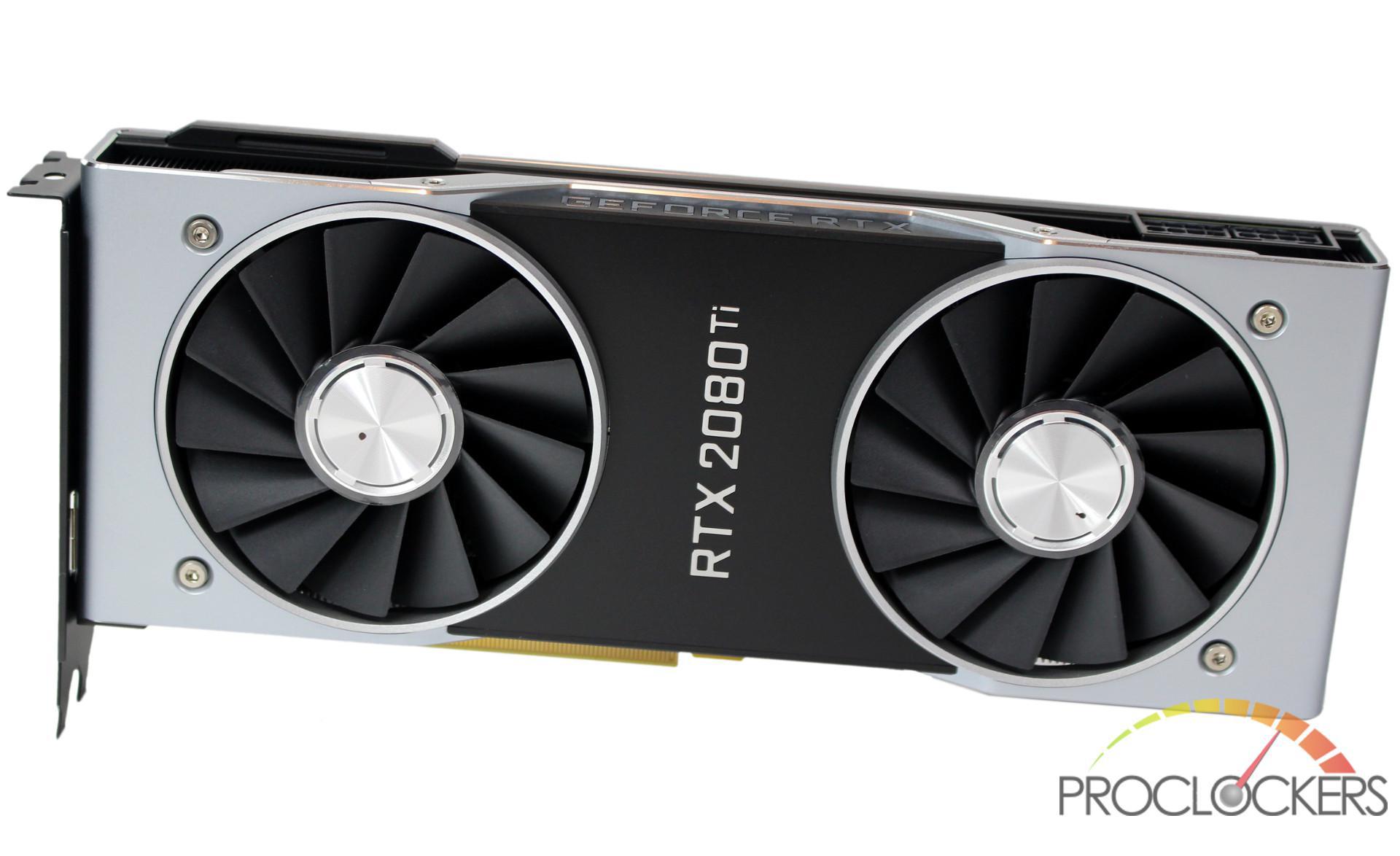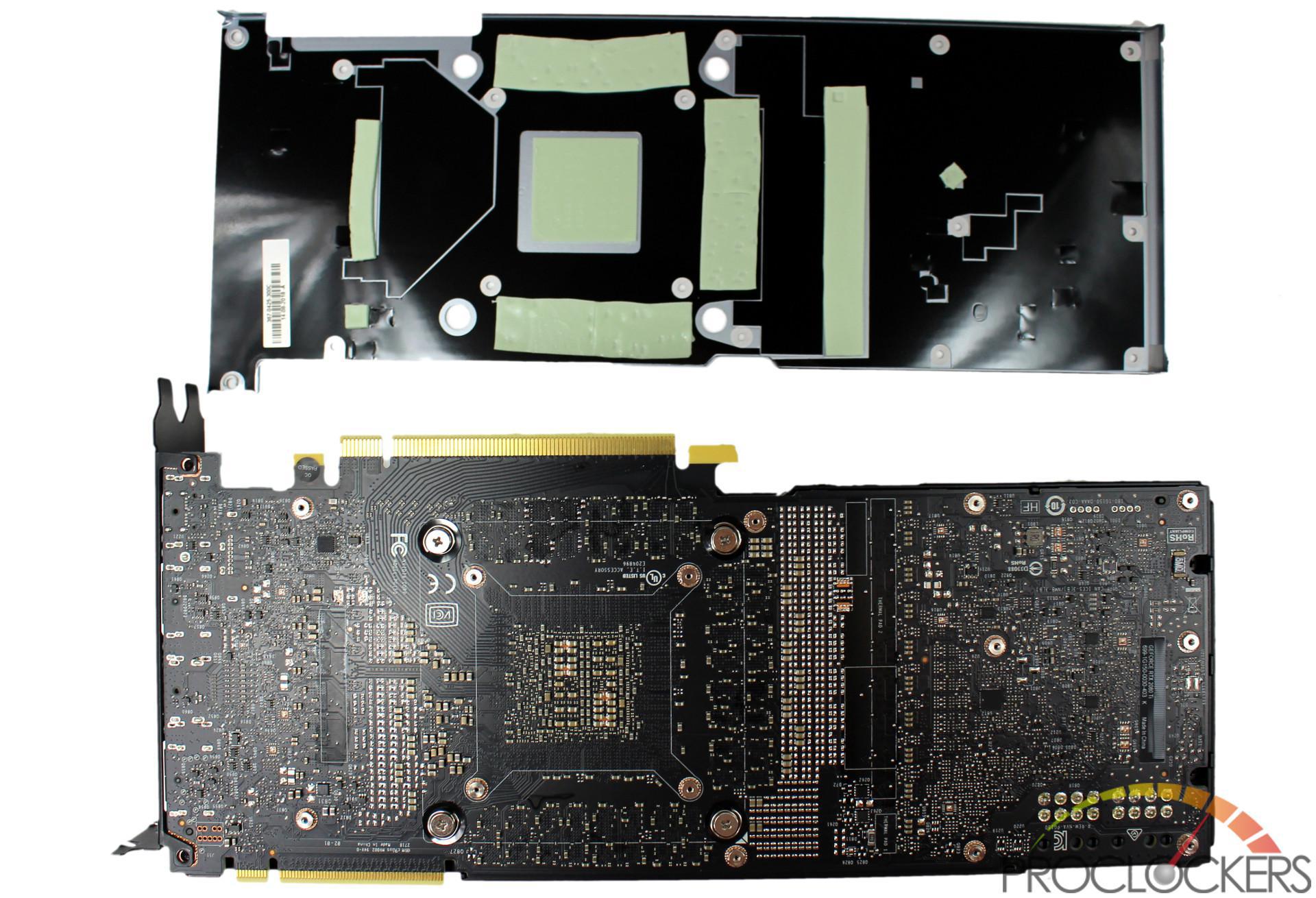Hardware
NVIDIA GEFORCE RTX 2080Ti Founders Edition Review
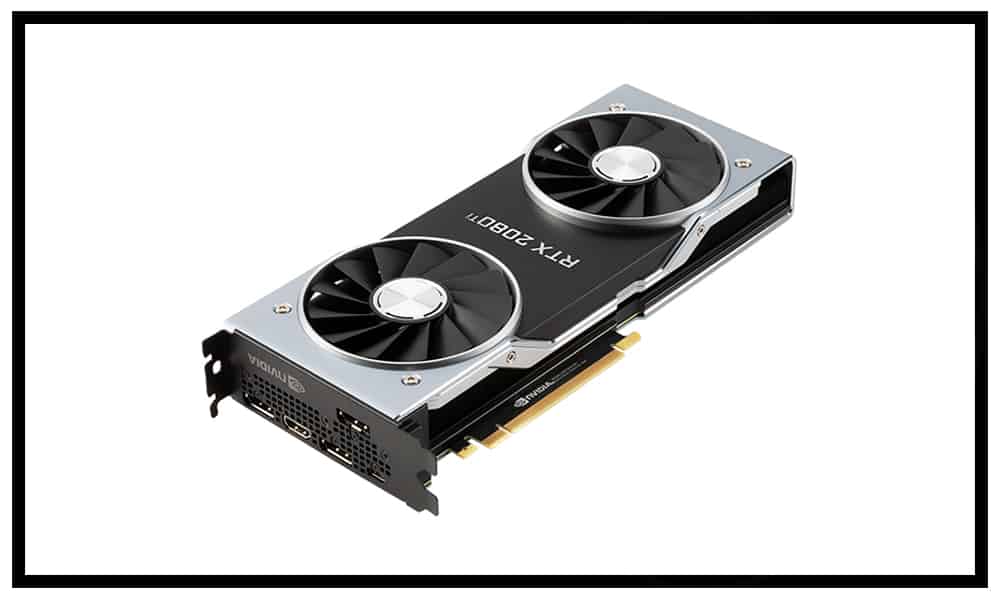
Introduction
It’s been nearly two and a half years since Nvidia’s last architecture hit the streets in the form of the Pascal powered GTX 10-series cards. This means it has been a good year to year and a half since the very vocal gaming community has been clamoring about the next best thing. Well, sorry gamers, Nvidia has been waiting for this day for nearly ten years. Featuring for the first time ever, real-time Ray Tracing. You may not be familiar with the term, but if you watch many movies, you’ve seen the results of server farms pre-rendering your movies and special effects. Dubbed the ‘Holy-Grail’ of gaming, Ray Tracing is poised to revolutionize the way lighting, shadows, and reflections are done in games for the ultimate immersive experience.
ProClockers would like to thank Nvidia for sending the GEFORCE RTX 2080Ti Founders Edition over to check out!
Nvidia’s take on the GEFORCE RTX 2080Ti Founders Edition:
NVIDIA’s newest flagship graphics card is a revolution in gaming realism and performance. Its powerful NVIDIA Turing™ GPU architecture, breakthrough technologies, and 11 GB of next-gen, ultra-fast GDDR6 memory make it the world’s ultimate gaming GPU.
NVIDIA TURING
GeForce RTX™ graphics cards are powered by the Turing GPU architecture and the all-new RTX platform. This gives you up to 6X the performance of previous-generation graphics cards and brings the power of real-time ray tracing and AI to games.
UP TO 6X FASTER PERFORMANCE
REAL-TIME RAY TRACING IN GAMES
POWERFUL AI ENHANCED GRAPHICS
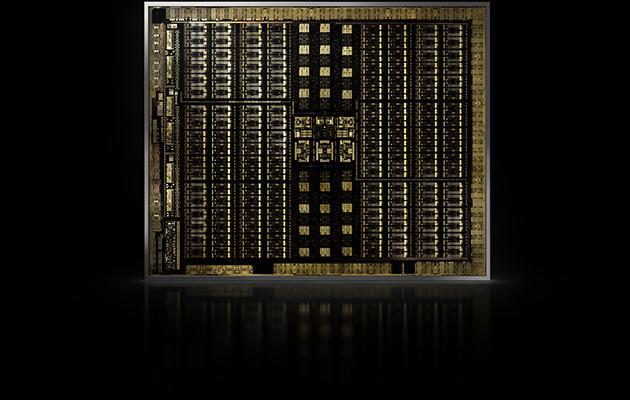
Turing represents the biggest architectural leap forward in over a decade, providing a new core GPU architecture that enables major advances in efficiency and performance for PC gaming, professional graphics applications, and deep learning inferencing.
Using new hardware-based accelerators and a Hybrid Rendering approach, Turing fuses rasterization, real-time ray tracing, AI, and simulation to enable incredible realism in PC games, amazing new effects powered by neural networks, cinematic-quality interactive experiences, and fluid interactivity when creating or navigating complex 3D models.

Turing reinvents graphics with an entirely new architecture that includes enhanced Tensor Cores, new RT Cores, and many new advanced shading features. Turing combines programmable shading, real-time ray tracing, and AI algorithms to deliver incredibly realistic and physically accurate graphics for games and professional applications.
Nvidia Turing Architecture In-Depth
There is a LOT going on under the hood of any GPU if you are interested in the nuts and bolts of how it works, but Nvidia’s Turing amplifies that to a whole new level. Nvidia has extensive documentation on what new technologies are in this generation and how they work, so it’s no use to reinvent the wheel here by paraphrasing. To that end, we’ll quote verbatim below for anyone that wishes to deep dive the Turing architecture as we found this particular public blog post to be an excellent balance between technical details and laymen’s explanations. You can read the original article here:
https://devblogs.nvidia.com/nvidia-turing-architecture-in-depth/
By Emmett Kilgariff, Henry Moreton, Nick Stam and Brandon Bell | September 14, 2018
Fueled by the ongoing growth of the gaming market and its insatiable demand for better 3D graphics, NVIDIA® has evolved the GPU into the world’s leading parallel processing engine for many computationally-intensive applications. In addition to rendering highly realistic and immersive 3D games, NVIDIA GPUs also accelerate content creation workflows, high-performance computing (HPC) and data center applications, and numerous artificial intelligence systems and applications. The new NVIDIA Turing GPU architecture builds on this long-standing GPU leadership.
Turing represents the biggest architectural leap forward in over a decade, providing a new core GPU architecture that enables major advances in efficiency and performance for PC gaming, professional graphics applications, and deep learning inferencing.
Using new hardware-based accelerators and a Hybrid Rendering approach, Turing fuses rasterization, real-time ray tracing, AI, and simulation to enable incredible realism in PC games, amazing new effects powered by neural networks, cinematic-quality interactive experiences, and fluid interactivity when creating or navigating complex 3D models.
Within the core architecture, the key enablers for Turing’s significant boost in graphics performance are a new GPU processor (streaming multiprocessor—SM) architecture with improved shader execution efficiency and a new memory system architecture that includes support for the latest GDDR6 memory technology.
Image processing applications such as the ImageNet Challenge were among the first success stories for deep learning, so it is no surprise that AI has the potential to solve many important problems in graphics. Turing’s Tensor Cores power a suite of new deep learning-based Neural Services that offer stunning graphics effects for games and professional graphics, in addition to providing fast AI inferencing for cloud-based systems.
The long-sought-after holy-grail of computer graphics rendering—real-time ray tracing—is now a reality in single-GPU systems with the NVIDIA Turing GPU architecture. Turing GPUs introduce new RT Cores, accelerator units that are dedicated to performing ray tracing operations with extraordinary efficiency, eliminating expensive software emulation-based ray tracing approaches of the past. These new units, combined with NVIDIA RTX™ software technology and sophisticated filtering algorithms, enable Turing to deliver real-time ray-traced rendering, including photorealistic objects and environments with physically accurate shadows, reflections, and refractions.
In parallel with Turing’s development, Microsoft announced both the DirectML for AI and DirectX Raytracing (DXR) APIs in early 2018. With the combination of Turing GPU architecture and the new AI and ray tracing APIs from Microsoft, game developers can rapidly deploy real-time AI and ray tracing in their games.
In addition to its groundbreaking AI and ray tracing features, Turing also includes many new advanced shading features that improve performance, enhance image quality, and deliver new levels of geometric complexity.
Turing GPUs also inherit all the enhancements to the NVIDIA CUDA™ platform introduced in the Volta architecture that improve the capability, flexibility, productivity, and portability of compute applications. Features such as independent thread scheduling, hardware-accelerated Multi Process Service (MPS) with address space isolation for multiple applications, and Cooperative Groups are all part of the Turing GPU architecture.
Several of the new NVIDIA GeForce® and NVIDIA Quadro™ GPU products will be powered by Turing GPUs. In this paper we focus on the architecture and capabilities of NVIDIA’s flagship Turing GPU, which is codenamed TU102 and will be shipping in the GeForce RTX 2080 Ti and Quadro RTX 6000. Technical details, including product specifications for TU104 and TU106 Turing GPUs, are located in the appendices.
Figure 1 shows how Turing reinvents graphics with an entirely new architecture that includes enhanced Tensor Cores, new RT Cores, and many new advanced shading features. Turing combines programmable shading, real-time ray tracing, and AI algorithms to deliver incredibly realistic and physically accurate graphics for games and professional applications.
Figure 1. Turing Reinvents Graphics
NVIDIA TURING KEY FEATURES
NVIDIA Turing is the world’s most advanced GPU architecture. The high-end TU102 GPU includes
18.6 billion transistors fabricated on TSMC’s 12 nm FFN (FinFET NVIDIA) high-performance manufacturing process.
The GeForce RTX 2080 Ti Founders Edition GPU delivers the following exceptional computational performance:
- 14.2 TFLOPS1 of peak single precision (FP32) performance
- 28.5 TFLOPS1 of peak half precision (FP16) performance
- 14.2 TIPS1 concurrent with FP, through independent integer execution units
- 113.8 Tensor TFLOPS1,2
- 10 Giga Rays/sec
- 78 Tera RTX-OPS
The Quadro RTX 6000 provides superior computational performance designed for professional workflows:
- 16.3 TFLOPS1 of peak single precision (FP32) performance
- 32.6 TFLOPS1 of peak half precision (FP16) performance
- 16.3 TIPS1 concurrent with FP, through independent integer execution units
- 130.5 Tensor TFLOPS1,2
- 10 Giga Rays/sec
- 84 Tera RTX-OPS
1Based on GPU Boost clock. 2FP16 matrix math with FP16 accumulation.
The following section describes Turing’s major new innovations in summary format. More detailed descriptions of each area are provided throughout this whitepaper.
New Streaming Multiprocessor (SM)
Turing introduces a new processor architecture, the Turing SM, that delivers a dramatic boost in shading efficiency, achieving 50% improvement in delivered performance per CUDA Core compared to the Pascal generation. These improvements are enabled by two key architectural changes. First, the Turing SM adds a new independent integer datapath that can execute instructions concurrently with the floating-point math datapath. In previous generations, executing these instructions would have blocked floating-point instructions from issuing. Second, the SM memory path has been redesigned to unify shared memory, texture caching, and memory load caching into one unit. This translates to 2x more bandwidth and more than 2x more capacity available for L1 cache for common workloads.
Turing Tensor Cores
Tensor Cores are specialized execution units designed specifically for performing the tensor / matrix operations that are the core compute function used in Deep Learning. Similar to Volta Tensor Cores, the Turing Tensor Cores provide tremendous speed-ups for matrix computations at the heart of deep learning neural network training and inferencing operations. Turing GPUs include a new version of the Tensor Core design that has been enhanced for inferencing. Turing Tensor Cores add new INT8 and INT4 precision modes for inferencing workloads that can tolerate quantization and don’t require FP16 precision. Turing Tensor Cores bring new deep learning- based AI capabilities to GeForce gaming PCs and Quadro-based workstations for the first time. A new technique called Deep Learning Super Sampling (DLSS) is powered by Tensor Cores. DLSS leverages a deep neural network to extract multidimensional features of the rendered scene and intelligently combine details from multiple frames to construct a high-quality final image. DLSS uses fewer input samples than traditional techniques such as TAA, while avoiding the algorithmic difficulties such techniques face with transparency and other complex scene elements.
Real-Time Ray Tracing Acceleration
Turing introduces real-time ray tracing that enables a single GPU to render visually realistic 3D games and complex professional models with physically accurate shadows, reflections, and refractions. Turing’s new RT Cores accelerate ray tracing and are leveraged by systems and interfaces such as NVIDIA’s RTX ray tracing technology, and APIs such as Microsoft DXR, NVIDIA OptiX™, and Vulkan ray tracing to deliver a real-time ray tracing experience.
New Shading Advancements
Mesh Shading
Mesh shading advances NVIDIA’s geometry processing architecture by offering a new shader model for the vertex, tessellation, and geometry shading stages of the graphics pipeline, supporting more flexible and efficient approaches for computation of geometry. This more flexible model makes it possible, for example, to support an order of magnitude more objects per scene, by moving the key performance bottleneck of object list processing off of the CPU and into highly parallel GPU mesh shading programs. Mesh shading also enables new algorithms for advanced geometric synthesis and object LOD management.
Variable Rate Shading (VRS)
VRS allows developers to control shading rate dynamically, shading as little as once per sixteen pixels or as often as eight times per pixel. The application specifies shading rate using a combination of a shading-rate surface and a per-primitive (triangle) value. VRS is a very powerful tool that allows developers to shade more efficiently, reducing work in regions of the screen where full resolution shading would not give any visible image quality benefit, and therefore improving frame rate. Several classes of VRS-based algorithms have already been identified, which can vary shading work based on content level of detail (Content Adaptive Shading), rate of content motion (Motion Adaptive Shading), and for VR applications, lens resolution and eye position (Foveated Rendering).
Texture-Space Shading
With texture-space shading, objects are shaded in a private coordinate space (a texture space) that is saved to memory, and pixel shaders sample from that space rather than evaluating results directly. With the ability to cache shading results in memory and reuse/resample them, developers can eliminate duplicate shading work or use different sampling approaches that improve quality.
Multi-View Rendering (MVR)
MVR powerfully extends Pascal’s Single Pass Stereo (SPS). While SPS allowed rendering of two views that were common except for an X offset, MVR allows rendering of multiple views in a single pass even if the views are based on totally different origin positions or view directions. Access is via a simple programming model in which the compiler automatically factors out view independent code, while identifying view-dependent attributes for optimal execution.
Deep Learning Features for Graphics
NVIDIA NGX™ is the new deep learning-based neural graphics framework of NVIDIA RTX Technology. NVIDIA NGX utilizes deep neural networks (DNNs) and set of “Neural Services” to perform AI-based functions that accelerate and enhance graphics, rendering, and other client- side applications. NGX employs the Turing Tensor Cores for deep learning-based operations and accelerates delivery of NVIDIA deep learning research directly to the end-user. Features include ultra-high quality NGX DLSS (Deep Learning Super-Sampling), AI InPainting content-aware image replacement, AI Slow-Mo very high-quality and smooth slow motion, and AI Super Rez smart resolution resizing.
Deep Learning Features for Inference
Turing GPUs deliver exceptional inference performance. The Turing Tensor Cores, along with continual improvements in TensorRT (NVIDIA’s run-time inferencing framework), CUDA, and CuDNN libraries, enable Turing GPUs to deliver outstanding performance for inferencing applications. Turing Tensor Cores also add support for fast INT8 matrix operations to significantly accelerate inference throughput with minimal loss in accuracy. New low-precision INT4 matrix operations are now possible with Turing Tensor Cores and will enable research and development into sub 8-bit neural networks.
GDDR6 High-Performance Memory Subsystem
Turing is the first GPU architecture to support GDDR6 memory. GDDR6 is the next big advance in high-bandwidth GDDR DRAM memory design. GDDR6 memory interface circuits in Turing GPUs have been completely redesigned for speed, power efficiency and noise reduction, achieving 14 Gbps transfer rates at 20% improved power efficiency compared to GDDR5X memory used in Pascal GPUs.
Second-Generation NVIDIA NVLink
Turing TU102 and TU104 GPUs incorporate NVIDIA’s NVLink™ high-speed interconnect to provide dependable, high bandwidth and low latency connectivity between pairs of Turing GPUs. With up to 100GB/sec of bidirectional bandwidth, NVLINK makes it possible for customized many workloads to efficiently split across two GPUs and share memory capacity. For gaming workloads, NVLINK’s increased bandwidth and dedicated inter-GPU channel enables new possibilities for SLI, such as new modes or higher resolution display configurations. For large memory workloads, including professional ray tracing applications, scene data can be split across the frame buffer of both GPUs, offering up to 96 GB of shared frame buffer memory (two 48 GB Quadro RTX 8000 GPUs), and memory requests are automatically routed by hardware to the correct GPU based on the location of the memory allocation.
USB-C and VirtualLink
Turing GPUs include hardware support for USB Type-C™ and VirtualLink™. (In preparation for the emerging VirtualLink standard, Turing GPUs have implemented hardware support according to the VirtualLink Advance Overview. To learn more about VirtualLink, refer to http://www.virtuallink.org). VirtualLink is a new open industry standard being developed to meet the power, display, and bandwidth demands of next-generation VR headsets through a single USB-C connector. In addition to easing the setup hassles present in today’s VR headsets, VirtualLink will bring VR to more devices.
Turing Architecture In-depth
The Turing TU102 GPU is the highest performing GPU of the Turing GPU line and the focus of this section. The TU104 and TU106 GPUs utilize the same basic architecture as TU102, scaled down to different degrees for different usage models and market segments. Details of TU104 and TU106 chip architectures and target usages/markets are provided in the full Turing Architecture White Paper.
TURING TU102 GPU
The TU102 GPU includes six Graphics Processing Clusters (GPCs), 36 Texture Processing Clusters (TPCs), and 72 Streaming Multiprocessors (SMs). (See Figure 2 for an illustration of the TU102 full GPU with 72 SM units.) Each GPC includes a dedicated raster engine and six TPCs, with each TPC including two SMs. Each SM contains 64 CUDA Cores, eight Tensor Cores, a 256 KB register file, four texture units, and 96 KB of L1/shared memory which can be configured for various capacities depending on the compute or graphics workloads.
Ray tracing acceleration is performed by a new RT Core processing engine within each SM (RT Core and ray tracing features are discussed in more depth in the full NVIDIA Turing Architecture White Paper).
The full implementation of the TU102 GPU includes the following:
- 4,608 CUDA Cores
- 72 RT Cores
- 576 Tensor Cores
- 288 texture units
- 12 32-bit GDDR6 memory controllers (384-bits total).
Tied to each memory controller are eight ROP units and 512 KB of L2 cache. The full TU102 GPU consists of 96 ROP units and 6144 KB of L2 cache. See the Turing TU102 GPU in Figure 3. Table 1 compares the GPU features of the Pascal GP102 to the Turing TU102.
Figure 2. Turing TU102 Full GPU with 72 SM Units
Note: The TU102 GPU also features 144 FP64 units (two per SM), which are not depicted in this diagram. The FP64 TFLOP rate is 1/32nd the TFLOP rate of FP32 operations. The small number of FP64 hardware units are included to ensure any programs with FP64 code operates correctly.
| Table 1. Comparison of NVIDIA Pascal GP102 and Turing TU102Note: ✱ Peak TFLOPS, TIPS, and TOPS rates are based on GPU Boost Clock.+ Power figure represents Graphics Card TDP only. Note that use of the VirtualLink™/USB Type-C™ connector requires up to an additional 35 W of power that is not represented in this power figure. | ||||
| GPU Features | GTX 1080Ti | RTX 2080 Ti | Quadro 6000 | Quadro RTX 6000 |
| Architecture | Pascal | Turing | Pascal | Turing |
| GPCs | 6 | 6 | 6 | 6 |
| TPCs | 28 | 34 | 30 | 36 |
| SMs | 28 | 68 | 30 | 72 |
| CUDA Cores / SM | 128 | 64 | 128 | 64 |
| CUDA Cores / GPU | 3584 | 4352 | 3840 | 4608 |
| Tensor Cores / SM | NA | 8 | NA | 8 |
| Tensor Cores / GPU | NA | 544 | NA | 576 |
| RT Cores | NA | 68 | NA | 72 |
| GPU Base Clock MHz (Reference / Founders Edition) | 1480 / 1480 | 1350 / 1350 | 1506 | 1455 |
| GPU Boost Clock MHz (Reference / Founders Edition) | 1582 / 1582 | 1545 / 1635 | 1645 | 1770 |
| RTX-OPS (Tera-OPS) (Reference / Founders Edition) | 11.3 / 11.3 | 76 / 78 | NA | 84 |
| Rays Cast (Giga Rays/sec) (Reference / Founders Edition) | 1.1 / 1.1 | 10 / 10 | NA | 10 |
| Peak FP32 TFLOPS✱ (Reference/Founders Edition) | 11.3 / 11.3 | 13.4 / 14.2 | 12.6 | 16.3 |
| Peak INT32 TIPS✱ (Reference/Founders Edition) | NA | 13.4 / 14.2 | NA | 16.3 |
| Peak FP16 TFLOPS✱ (Reference/Founders Edition) | NA | 26.9 / 28.5 | NA | 32.6 |
| Peak FP16 Tensor TFLOPS with FP16 Accumulate✱ (Reference/Founders Edition) | NA | 107.6 / 113.8 | NA | 130.5 |
| Peak FP16 Tensor TFLOPS with FP32 Accumulate✱ (Reference/Founders Edition) | NA | 53.8 / 56.9 | NA | 130.5 |
| Peak INT8 Tensor TOPS✱ (Reference/Founders Edition) | NA | 215.2 / 227.7 | NA | 261.0 |
| Peak INT4 Tensor TOPS✱ (Reference/Founders Edition) | NA | 430.3 / 455.4 | NA | 522.0 |
| Frame Buffer Memory Size and Type | 11264 MB GDDR5X | 11264 MB GDDR6 | 24576 MB GDDR5X | 24576 MB GDDR6 |
| Memory Interface | 352-bit | 352-bit | 384-bit | 384-bit |
| Memory Clock (Data Rate) | 11 Gbps | 14 Gbps | 9 Gbps | 14 Gbps |
| Memory Bandwidth (GB/sec) | 484 | 616 | 432 | 672 |
| ROPs | 88 | 88 | 96 | 96 |
| Texture Units | 224 | 272 | 240 | 288 |
| Texel Fill-rate (Gigatexels/sec) | 354.4 / 354.4 | 420.2 / 444.7 | 395 | 510 |
| L2 Cache Size | 2816 KB | 5632 KB | 3072 KB | 6144 KB |
| Register File Size/SM | 256 KB | 256 KB | 256 KB | 256 KB |
| Register File Size/GPU | 7168 KB | 17408 KB | 7680 KB | 18432 KB |
| TDP★ (Reference/Founders Edition) | 250 / 250 W | 250 / 260 W | 250 W | 260 W |
| Transistor Count | 12 Billion | 18.6 Billion | 12 Billion | 18.6 Billion |
| Die Size | 471 | 754 | 471 | 754 |
| Manufacturing Process | 16 nm | 12 nm FFN | 16 nm | 12 nm FFN |
As GPU-accelerated computing has become more popular, systems with multiple GPUs are increasingly being deployed in servers, workstations, and supercomputers. The TU102 and TU104 GPUs include the second generation of NVIDIA’s NVLink™ high-speed interconnect, originally designed into the Volta GV100 GPU, providing high-speed multi-GPU connectivity for SLI and other multi-GPU use cases. NVLink permits each GPU to directly access memory of other connected GPUs, providing much faster GPU-to-GPU communications, and allows combining memory from multiple GPUs to support much larger datasets and faster in-memory computations.
TU102 includes two NVLink x8 links each capable of delivering up to 25 Gigabytes/second in each direction, for a total aggregate bidirectional bandwidth of 100 Gigabytes/second.
Figure 3. NVIDIA Turing TU102 GPU
TURING STREAMING MULTIPROCESSOR (SM) ARCHITECTURE
The Turing architecture features a new SM design that incorporates many of the features introduced in our Volta GV100 SM architecture. Two SMs are included per TPC, and each SM has a total of 64 FP32 Cores and 64 INT32 Cores. In comparison, the Pascal GP10x GPUs have one SM per TPC and 128 FP32 Cores per SM. The Turing SM supports concurrent execution of FP32 and INT32 operations (more details below), independent thread scheduling similar to the Volta GV100 GPU. Each Turing SM also includes eight mixed-precision Turing Tensor Cores, which are described in more detail in the Turing Tensor Cores section below , and one RT Core, whose functionality is described in the Turing Ray Tracing Technology below. See Figure 4 for an illustration of the Turing TU102, TU104, and TU106 SM.
Figure 4. Turing TU102/TU104/TU106 Streaming Multiprocessor (SM)
The Turing SM is partitioned into four processing blocks, each with 16 FP32 Cores, 16 INT32 Cores, two Tensor Cores, one warp scheduler, and one dispatch unit. Each block includes a new L0 instruction cache and a 64 KB register file. The four processing blocks share a combined 96 KB L1 data cache/shared memory. Traditional graphics workloads partition the 96 KB L1/shared memory as 64 KB of dedicated graphics shader RAM and 32 KB for texture cache and register file spill area. Compute workloads can divide the 96 KB into 32 KB shared memory and 64 KB L1 cache, or 64 KB shared memory and 32 KB L1 cache.
Turing implements a major revamping of the core execution datapaths. Modern shader workloads typically have a mix of FP arithmetic instructions such as FADD or FMAD with simpler instructions such as integer adds for addressing and fetching data, floating point compare or min/max for processing results, etc. In previous shader architectures, the floating-point math datapath sits idle whenever one of these non-FP-math instructions runs. Turing adds a second parallel execution unit next to every CUDA core that executes these instructions in parallel with floating point math.
Figure 5 shows that the mix of integer pipe versus floating point instructions varies, but across several modern applications, we typically see about 36 additional integer pipe instructions for every 100 floating point instructions. Moving these instructions to a separate pipe translates to an effective 36% additional throughput possible for floating point.
Figure 5. Concurrent Execution of Floating Point and Integer Instructions in the Turing SM
Profiling many workloads shows an average of 36 integer operations for every 100 floating point operations.
Turing’s SM also introduces a new unified architecture for shared memory, L1, and texture caching. This unified design allows the L1 cache to leverage resources, increasing its hit bandwidth by 2x per TPC compared to Pascal, and allows it to be reconfigured to grow larger when shared memory allocations are not using all the shared memory capacity. The Turing L1 can be as large as 64 KB in size, combined with a 32 KB per SM shared memory allocation, or it can reduce to 32 KB, allowing 64 KB of allocation to be used for shared memory. Turing’s L2 cache capacity has also been increased.
Figure 6 shows how the new combined L1 data cache and shared memory subsystem of the Turing SM significantly improves performance while also simplifying programming and reducing the tuning required to attain at or near-peak application performance. Combining the L1 data cache with the shared memory reduces latency and provides higher bandwidth than the L1 cache implementation used previously in Pascal GPUs.
Figure 6. New Shared Memory Architecture
Overall, the changes in SM enable Turing to achieve 50% improvement in delivered performance per CUDA core. Figure 7 shows the results across a set of shader workloads from current gaming applications.
Figure 7. Turing Shading Performance Speedup versus Pascal on Many Different Workloads
Turing Tensor Cores
Turing GPUs include an enhanced version of the Tensor Cores first introduced in the Volta GV100 GPU. The Turing Tensor Core design adds INT8 and INT4 precision modes for inferencing workloads that can tolerate quantization. FP16 is also fully supported for workloads that require higher precision.
The introduction of Tensor Cores into Turing-based GeForce gaming GPUs makes it possible to bring real-time deep learning to gaming applications for the first time. Turing Tensor Cores accelerate the AI-based features of NVIDIA NGX Neural Services that enhance graphics, rendering, and other types of client-side applications. Examples of NGX AI features include Deep Learning Super Sampling (DLSS), AI InPainting, AI Super Rez, and AI Slow-Mo. More details on DLSS can be found later in this post. You can find additional information on other NGX functionality in the full NVIDIA Turing Architecture White Paper.
Turing Tensor Cores accelerate the matrix-matrix multiplication at the heart of neural network training and inferencing functions. Turing Tensor Cores particularly excel at inference computations, in which useful and relevant information can be inferred and delivered by a trained deep neural network (DNN) based on a given input. Examples of inference include identifying images of friends in Facebook photos, identifying and classifying different types of automobiles, pedestrians, and road hazards in self-driving cars, translating human speech in real- time, and creating personalized user recommendations in online retail and social media systems.
A TU102 GPU contains 576 Tensor Cores: eight per SM and two per each processing block within an SM. Each Tensor Core can perform up to 64 floating point fused multiply-add (FMA) operations per clock using FP16 inputs. Eight Tensor Cores in an SM perform a total of 512 FP16 multiply and accumulate operations per clock, or 1024 total FP operations per clock. The new INT8 precision mode works at double this rate, or 2048 integer operations per clock.
Turing Tensor Cores provide significant speedups to matrix operations and are used for both deep learning training and inference operations in addition to new neural graphics functions. For more information on basic Tensor Core operational details refer to the NVIDIA Tesla V100 GPU Architecture Whitepaper.
New Turing Tensor Cores Provide Multi-Precision for AI Inference.
TURING OPTIMIZED FOR DATACENTER APPLICATIONS
In addition to bringing revolutionary new features for high-end gaming and professional graphics, Turing delivers exceptional performance and energy efficiency for the next generation of Tesla® GPUs. NVIDIA’s current generation of Pascal-based GPUs used in datacenters for inferencing applications already deliver up to 10 times higher performance and 25 times higher energy efficiency than CPU-based servers. Powered by the Turing Tensor Cores, the next generation of Turing-based Tesla GPUs will deliver even higher inferencing performance and energy efficiency in data centers. Turing-based Tesla GPUs optimized to operate under 75 Watts will deliver significant efficiency and performance boost to hyperscale data centers.
Turing GPU architecture, in addition to the Turing Tensor Cores, includes several features to improve performance of data center applications. Some of the key features are:
Enhanced Video Engine
Compared to prior generation Pascal and Volta GPU architectures, Turing supports additional video decode formats such as HEVC 4:4:4 (8/10/12 bit), and VP9 (10/12 bit). The enhanced video engine in Turing is capable of decoding significantly higher number of concurrent video streams than equivalent Pascal based Tesla GPUs. (See the Video and Display Engine section below.)
Turing Multi-Process Service
Turing GPU architecture inherits the enhanced Multi-Process Service (MPS) feature first introduced in the Volta architecture. Compared to Pascal-based Tesla GPUs, MPS on Turing- based Tesla boards improve inference performance for small batch sizes, reduce launch latency, improve Quality of Service, and can service higher numbers of concurrent client requests.
Higher memory bandwidth and larger memory size
Upcoming Turing-based Tesla boards have larger memory capacity and higher memory bandwidth than prior generation Pascal-based Tesla boards that target similar server segments, delivering greater user density for Virtual Desktop Infrastructure (VDI) applications.
TURING MEMORY ARCHITECTURE AND DISPLAY FEATURES
This section dives deeper into key new memory hierarchy and display subsystem features of the Turing architecture.
Memory subsystem performance is crucial to application acceleration. Turing improves main memory, cache memory, and compression architectures to increase memory bandwidth and reduce access latency. Improved and enhanced GPU compute features help accelerate both games and many computationally intensive applications and algorithms. New display and video encode/decode features support higher resolution and HDR-capable displays, more advanced VR displays, increasing video streaming requirements in the datacenter, 8K video production, and other video-related applications. The following features are discussed in detail:
- GDDR6 Memory Subsystem
- L2 Cache and ROPs
- Turing Memory Compression
- Video and Display Engine
- USB-C and VirtualLink
GDDR6 Memory Subsystem
As display resolutions continue to increase and shader functionality and rendering techniques become more complex, memory bandwidth and size play a larger role in GPU performance. To maintain the highest possible frame rates and computational speed, the GPU not only needs more memory bandwidth, it also needs a large pool of memory to draw from to deliver sustained performance.
NVIDIA worked closely with the DRAM industry to develop the world’s first GPUs that use HBM2 and GDDR5X memories. Now Turing is the first GPU architecture to utilize GDDR6 memory.
GDDR6 is the next big advance in high-bandwidth GDDR DRAM memory design. Enhanced with many high-speed SerDes and RF techniques, GDDR6 memory interface circuits in Turing GPUs have been completely redesigned for speed, power efficiency, and noise reduction. This new interface design comes with many new circuit and signal training improvements that minimize noise and variations due to process, temperature, and supply voltage. Extensive clock gating was used to minimize power consumption during periods of lower utilization, resulting in significant overall power efficiency improvement. Turing’s GDDR6 memory subsystem delivers 14 Gbps signaling rates and 20% power efficiency improvement over GDDR5X memory used in Pascal GPUs.
Achieving this speed increase requires end-to-end optimizations. Using extensive signal and power integrity simulations, NVIDIA carefully crafted Turing’s package and board designs to meet the higher speed requirements. An example is a 40% reduction in signal crosstalk, which is one of the most severe impairments in large memory systems.
To realize speeds of 14 Gbps, every aspect of the memory subsystem was carefully crafted to meet the demanding standards that are required for such high frequency operation. Every signal in the design was carefully optimized to provide the cleanest memory interface signaling as possible (see Figure 9).
Figure 9. Turing GDDR6
L2 Cache and ROPs
Turing GPUs add larger and faster L2 caches in addition to the new GDDR6 memory subsystem. The TU102 GPU ships with 6 MB of L2 cache, double the 3 MB of L2 cache that was offered in the prior generation GP102 GPU used in the TITAN Xp. TU102 also provides significantly higher L2 cache bandwidth than GP102.
Like prior generation NVIDIA GPUs, each ROP partition in Turing contains eight ROP units and each unit can process a single-color sample. A full TU102 chip contains 12 ROP partitions for a total of 96 ROPs.
Turing Memory Compression
NVIDIA GPUs utilize several lossless memory compression techniques to reduce memory bandwidth demands as data is written out to frame buffer memory. The GPU’s compression engine has a variety of different algorithms which determine the most efficient way to compress the data based on its characteristics. This reduces the amount of data written out to memory and transferred from memory to the L2 cache and reduces the amount of data transferred between clients (such as the texture unit) and the frame buffer. Turing adds further improvements to Pascal’s state-of-the-art memory compression algorithms, offering a further boost in effective bandwidth beyond the raw data transfer rate increases of GDDR6. As shown in Figure 10, the combination of raw bandwidth increases, and traffic reduction translates to a 50% increase in effective bandwidth on Turing compared to Pascal, which is critical to keep the architecture balanced and support the performance offered by the new Turing SM architecture.
Figure 10. 50% Higher Effective Bandwidth
The memory subsystem and compression (traffic reduction) improvements of Turing TU102-based RTX 2080 Ti deliver approximately 50% effective bandwidth improvements over the Pascal GP102-based 1080 Ti.
Video and Display Engine
Consumer demand for higher resolution displays continues to increase with every passing year. For example, 8K resolution (7680 x 4320) requires four times more pixels than 4K (3820 x 2160). Gamers and hardware enthusiasts also desire displays with higher refresh rates in addition to higher resolution to experience the smoothest possible image.
Turing GPUs include an all-new display engine designed for the new wave of displays, supporting higher resolutions, faster refresh rates, and HDR. Turing supports DisplayPort 1.4a allowing 8K resolution at 60 Hz and includes VESA’s Display Stream Compression (DSC) 1.2 technology, providing higher compression that is visually lossless. Table 2 shows the DisplayPort support in the Turing GPUs.
| Table 2. DisplayPort Support in Turing GPUs | ||
| Bandwidth/Lane | Max Resolution Supported | |
| DisplayPort 1.2 | 5.4 Gbps | 4K @ 60 Hz |
| DisplayPort 1.3 | 8.1 Gbps | 5K @ 60 Hz |
| DisplayPort 1.4a | 8.1 Gbps | 8K @ 60 Hz |
Turing GPUs can drive two 8K displays at 60 Hz with one cable for each display. 8K resolution can also be sent over USB-C (see USB-C and VirtualLink section below for more details).
Turing’s new display engine supports HDR processing natively in the display pipeline. Tone mapping has also been added to the HDR pipeline. Tone mapping is a technique used to approximate the look of high dynamic range images on standard dynamic range displays. Turing supports the tone mapping formula defined by the ITU-R Recommendation BT.2100 standard to avoid color shift on different HDR displays.
Turing GPUs also ship with an enhanced NVENC encoder unit that adds support for H.265 (HEVC) 8K encode at 30 fps. The new NVENC encoder provides up to 25% bitrate savings for HEVC and up to 15% bitrate savings for H.264.
Turing’s new NVDEC decoder has also been updated to support decoding of HEVC YUV444 10/12b HDR at 30 fps, H.264 8K, and VP9 10/12b HDR.
Turing improves encoding quality compared to prior generation Pascal GPUs and compared to software encoders. Figure 11 shows that on common Twitch and YouTube streaming settings, Turing’s video encoder exceeds the quality of the x264 software-based encoder using the fast encode settings, with dramatically lower CPU utilization. 4K streaming is too heavy a workload for encoding on typical CPU setups, but Turing’s encoder makes 4K streaming possible.
Figure 11. New video features and video quality comparison of Turing to Pascal to a fast x264 software encoder
USB-C AND VIRTUALLINK
Supporting VR headsets on today’s PCs requires multiple cables to be connected between the headset and the system; a display cable to send image data from the GPU to the two displays in the headset, a cable to power the headset, and a USB connection to transfer camera streams and read back head pose information from the headset (to update frames rendered by the GPU). The number of cables can be uncomfortable for end users and limit their ability to move around when using the headset. Headset manufacturers need to accommodate the cables, complicating their designs and making them bulkier.
To address this issue, Turing GPUs are designed with hardware support for USB Type-C™ and VirtualLink™. VirtualLink is a new open industry standard that includes leading silicon, software, and headset manufacturers and is led by NVIDIA, Oculus, Valve, Microsoft, and AMD.
VirtualLink has been developed to meet the connectivity requirements of current and next- generation VR headsets. VirtualLink employs a new alternate mode of USB-C, designed to deliver the power, display, and data required to power VR headsets through a single USB-C connector.
VirtualLink simultaneously supports four lanes of High Bit Rate 3 (HBR3) DisplayPort along with the SuperSpeed USB 3 link to the headset for motion tracking. In comparison, USB-C only supports four lanes of HBR3 DisplayPort OR two lanes of HBR3 DisplayPort + two lanes SuperSpeed USB 3.
In addition to easing the setup hassles present in today’s VR headsets, VirtualLink will bring VR to more devices. A single connector solution brings VR to small form factor devices that can accommodate a single, small footprint USB-C connector (such as a thin and light notebook) rather than today’s VR infrastructure which requires a PC that can accommodate multiple connectors.
NVLINK IMPROVES SLI
Prior to the Pascal GPU architecture, NVIDIA GPUs used a single Multiple Input/Output (MIO) interface as the SLI Bridge technology to allow a second (or third or fourth) GPU to transfer its final rendered frame output to the primary GPU that was physically connected to a display. Pascal enhanced the SLI Bridge by using a faster dual-MIO interface, improving bandwidth between the GPUs, allowing higher resolution output, and multiple high-resolution monitors for NVIDIA Surround.
Turing TU102 and TU104 GPUs use NVLink instead of the MIO and PCIe interfaces for SLI GPU-to- GPU data transfers. The Turing TU102 GPU includes two x8 second-generation NVLink links, and Turing TU104 includes one x8 second-generation NVLink link. Each link provides 25 GB/sec peak bandwidth per direction between two GPUs (50 GB/sec bidirectional bandwidth). Two links in TU102 provides 50 GB/sec in each direction, or 100 GB/sec bidirectionally. Two-way SLI is supported with Turing GPUs that have NVLink, but 3-way and 4-way SLI configurations are not supported.
Compared to the previous SLI bridge, the increased bandwidth of the new NVLink bridge enables advanced display topologies that were not previously possible (see Figure 12).
Figure 12. NVLink Enables New SLI Display Topologies
Note: SLI driver support for 8K and 8K Surround will be enabled post-launch.
TURING RAY TRACING TECHNOLOGY
Ray tracing is a computationally-intensive rendering technology that realistically simulates the lighting of a scene and its objects. Turing GPU-based ray tracing technology can render physically correct reflections, refractions, shadows, and indirect lighting in real-time. More details on how ray tracing works can be found in the full Turing White Paper.
In the past, GPU architectures could not perform real time ray-tracing for games or graphical applications using a single GPU. While NVIDIA’s GPU-accelerated NVIDIA Iray® plugins and OptiX ray tracing engine have delivered realistic ray-traced rendering to designers, artists, and technical directors for years, high quality ray tracing effects could not be performed in real-time. Similarly, current NVIDIA Volta GPUs can render realistic movie-quality ray-traced scenes, but not in real- time on a single GPU. Due to its processing intensive nature, ray tracing has not been used in games for any significant rendering tasks. Instead, games that require 30 to 90+ frame/second animations have relied on fast, GPU-accelerated rasterization rendering techniques for years, at the expense of fully realistic looking scenes.
Implementing real-time ray tracing on GPUs was an enormous technical challenge, requiring nearly 10 years of collaboration between NVIDIA’s research, GPU hardware design, and software engineering teams. Real-time ray tracing in games and other applications is made possible by incorporation of multiple new hardware-based ray tracing acceleration engines called RT Cores in Turing TU102, TU104, and TU106 GPUs, combined with NVIDIA RTX software technology.
SOL MAN from NVIDIA SOL ray tracing demo running on a Turing TU102 GPU with NVIDIA RTX technology in real-time is shown in Figure 13 (see demo).
As mentioned, rasterization techniques have been the norm in real-time rendering for years, especially in computer games, and while many rasterized scenes can look very good, rasterization-based rendering has significant limitations. For example, rendering reflections and shadows using only rasterization requires simplifying assumptions that can cause many different types of artifacts. Similarly, static lightmaps may look correct until something moves, rasterized shadows often suffer from aliasing and light leaks, and screen-space reflections can only reflect off objects that are visible on the screen. These artifacts detract from the realism of the gaming experience and are costly for developers and artists to try to fix with additional effects.
Figure 13. SOL MAN from NVIDIA SOL Ray Tracing Demo
While ray tracing can produce much more realistic imagery than rasterization, it is also computationally intensive. We have found that the best approach is hybrid rendering, a combination of ray tracing and rasterization. With this approach, rasterization is used where it is most effective, and ray tracing is used where it provides the most visual benefit vs rasterization, such as rendering reflections, refractions, and shadows. Figure 14 Shows the hybrid rendering pipeline.
Hybrid Rendering combines ray tracing and rasterization techniques in the rendering pipeline to take advantage of what each does best to render a scene. SEED uses a hybrid rendering model for their PICA PICA real-time ray tracing experiment that features self-learning agents in a procedurally-assembled world. Built using SEED’s R&D engine Halcyon, PICA PICA implements real-time ray tracing using Microsoft DXR and NVIDIA GPUs.
Figure 14. Hybrid Rendering Pipeline. Image Courtesy of the SEED division of EA (SEED//Pica Pica Hardware Raytracing and Turing)
Rasterization and z-buffering is much faster at determining object visibility and can substitute for the primary ray casting stage of the ray tracing process. Ray tracing can then be used for shooting secondary rays to generate high-quality physically correct reflections, refractions, and shadows.
Developers can also use material property thresholds to determine areas to perform ray tracing in a scene. One technique might be to specify that only surfaces with a certain reflectivity level, say 70%, would trigger whether ray tracing should be used on that surface to generate secondary rays.
We expect many developers to use hybrid rasterization/ray tracing techniques to attain high frame rates with excellent image quality. Alternatively, for professional applications where image fidelity is the highest priority, we expect to see use of ray tracing for the entire rendering workload, casting primary and secondary rays to create amazingly realistic rendering.
Turing GPUs not only include dedicated ray tracing acceleration hardware, but also use an advanced acceleration structure described in the next section. Essentially, an entirely new rendering pipeline is available to enable real-time ray tracing in games and other graphics applications using a single Turing GPU (see Figure 15).
Figure 15. Details of Ray Tracing and Rasterization Pipeline Stages
Both Ray tracing and Rasterization pipeline operate simultaneously and cooperatively in Hybrid Rendering model used in Turing GPUs.
While Turing GPUs enable real time ray tracing, the number of primary or secondary rays cast per pixel or surface location varies based on many factors, including scene complexity, resolution, other graphics effects rendered in a scene, and of course GPU horsepower. Do not expect hundreds of rays cast per pixel in real-time. In fact, far fewer rays are needed per pixel when using Turing RT Core acceleration in combination with advanced denoising filtering techniques.
NVIDIA Real-Time Ray Tracing Denoiser modules can significantly reduce the number of rays required per pixel and still produce excellent results.
Real-time ray tracing of selected objects can make many scenes in games and applications look as realistic as high-end movie special effects, or as good as ray-traced images created with professional software-based non-real-time rendering applications. Figure 16 shows an example from the Reflections demo created by Epic Games in collaboration with ILMxLAB and NVIDIA.
Ray-traced reflections, ray-traced area light shadows, and ray-traced ambient occlusion can run on a single Quadro RTX 6000 or GeForce RTX 2080 Ti GPU delivering rendering quality nearly indistinguishable from movies, as this Unreal Engine demo shows.
Figure 16. Unreal Engine Reflections ray tracing demo
Turing ray tracing hardware works with NVIDIA’s RTX ray tracing technology, NVIDIA Real-Time Ray Tracing Libraries, NVIDIA OptiX, the Microsoft DXR API, and the soon-to-come Vulkan ray tracing API. Users will experience real-time, cinematic-quality ray-traced objects and characters in games at playable frame-rates, or visual realism in professional graphics applications that has been impossible with prior GPU architectures in real time.
Turing GPUs can accelerate ray tracing techniques used in many of the following rendering and non-rendering operations:
- Reflections and Refractions
- Shadows and Ambient Occlusion
- Global Illumination
- Instant and off-line lightmap baking
- Beauty shots and high-quality previews
- Primary rays for foveated VR rendering
- Occlusion Culling
- Physics, Collision Detection, Particle simulations
- Audio simulation (ex., NVIDIA VRWorks Audio built on top of the OptiX API)
- AI visibility queries
In-engine Path Tracing (non-real-time) to generate reference screenshots for tuning real-time rendering techniques and denoisers, material composition, and scene lighting.
More detail is presented on rendering ray-traced shadows, ambient occlusion, and reflections using Turing ray tracing acceleration in following sections. The NVIDIA Developer Site has more details describing rendering operations that can be accelerated with Turing ray tracing.
TURING RT CORES
At the heart of Turing’s hardware-based ray tracing acceleration is the new RT Core included in each SM. RT Cores accelerate Bounding Volume Hierarchy (BVH) traversal and ray/triangle intersection testing (ray casting) functions. RT Cores perform visibility testing on behalf of threads running in the SM.
RT Cores work together with advanced denoising filtering, a highly-efficient BVH acceleration structure developed by NVIDIA Research, and RTX compatible APIs to achieve real time ray tracing on single Turing GPU. RT Cores traversus the BVH autonomously, and by accelerating traversal and ray/triangle intersection tests, they offload the SM, allowing it to handle other vertex, pixel, and compute shading work. Functions such as BVH building and refitting are handled by the driver, and ray generation and shading is managed by the application through new types of shaders.
To better understand the function of RT Cores, and what exactly they accelerate, we should first explain how ray tracing is performed on GPUs or CPUs without a dedicated hardware ray tracing engine. Essentially, the process of BVH traversal would need to be performed by shader operations and take thousands of instruction slots per ray cast to test against bounding box intersections in the BVH until finally hitting a triangle and the color at the point of intersection contributes to final pixel color (or if no triangle is hit, background color may be used to shade a pixel).
Ray tracing without hardware acceleration requires thousands of software instruction slots per ray to test successively smaller bounding boxes in the BVH structure until possibly hitting a triangle. It’s a computationally intensive process making it impossible to do on GPUs in real-time without hardware-based ray tracing acceleration (see Figure 17).
Figure 17. Ray Tracing Pre Turing
The RT Cores in Turing can process all the BVH traversal and ray-triangle intersection testing, saving the SM from spending the thousands of instruction slots per ray, which could be an enormous amount of instructions for an entire scene. The RT Core includes two specialized units. The first unit does bounding box tests, and the second unit does ray-triangle intersection tests. The SM only has to launch a ray probe, and the RT core does the BVH traversal and ray-triangle tests, and return a hit or no hit to the SM. The SM is largely freed up to do other graphics or compute work. See Figure 18 or an illustration of Turing ray tracing with RT Cores.
Figure 18. Turing Ray Tracing with RT Cores
Turing ray tracing performance with RT Cores is significantly faster than ray tracing in Pascal GPUs. Turing can deliver far more Giga Rays/Sec than Pascal on different workloads, as shown in Figure 19. Pascal is spending approximately 1.1 Giga Rays/Sec, or 10 TFLOPS / Giga Ray to do ray tracing in software, whereas Turing can do 10+ Giga Rays/Sec using RT Cores, and run ray tracing 10 times faster.
Figure 19. Turing Ray Tracing Performance
DEEP LEARNING SUPER-SAMPLING (DLSS)
In modern games, rendered frames are not displayed directly, rather they go through a post processing image enhancement step that combines input from multiple rendered frames, trying to remove visual artifacts such as aliasing while preserving detail. For example, Temporal Anti- Aliasing (TAA), a shader-based algorithm that combines two frames using motion vectors to determine where to sample the previous frame, is one of the most common image enhancement algorithms in use today. However, this image enhancement process is fundamentally very difficult to get right.
NVIDIA’s researchers recognized that this type of problem – an image analysis and optimization problem with no clean algorithmic solution – would be a perfect application for AI. As discussed earlier in this document, image processing cases (for example ImageNet) are among the biggest successful applications of deep learning. Deep learning has now achieved super-human ability to recognize dogs, cats, birds etc., from looking at the raw pixels in an image. In this case, the goal would be to combine rendered images, based on looking at raw pixels, to produce a high-quality result—a different objective but using similar capabilities.
The deep neural network (DNN) that was developed to solve this challenge is called Deep Learning Super-Sampling (DLSS). DLSS produces a much higher quality output than TAA from a given set of input samples, and we leverage this capability to improve overall performance.
Whereas TAA renders at the final target resolution and then combines frames, subtracting detail, DLSS allows faster rendering at a lower input sample count, and then infers a result that at target resolution is similar quality to the TAA result, but with half the shading work.
Figure 20, below shows a sampling of results on the UE4 Infiltrator demo. DLSS provides image quality that is similar to TAA, with much improved performance. The much faster raw rendering horsepower of RTX 2080 Ti, combined with the performance uplift from DLSS and Tensor Cores, enables RTX 2080 Ti to achieve 2x the performance of GTX 1080 Ti.
Figure 20. Turing with 4K DLSS is Twice the Performance of Pascal with 4K TAA
The key to this result is the training process for DLSS, where it gets the opportunity to learn how to produce the desired output based on large numbers of super-high-quality examples. To train the network, we collect thousands of “ground truth” reference images rendered with the gold standard method for perfect image quality, 64x supersampling (64xSS). 64x supersampling means that instead of shading each pixel once, we shade at 64 different offsets within the pixel, and then combine the outputs, producing a resulting image with ideal detail and anti-aliasing quality. We also capture matching raw input images rendered normally. Next, we start training the DLSS network to match the 64xSS output frames, by going through each input, asking DLSS to produce an output, measuring the difference between its output and the 64xSS target, and adjusting the weights in the network based on the differences, through a process called back propagation.
After many iterations, DLSS learns on its own to produce results that closely approximate the quality of 64xSS, while also learning to avoid the problems with blurring, disocclusion, and transparency that affect classical approaches like TAA.
In addition to the DLSS capability described above, which is the standard DLSS mode, we provide a second mode, called DLSS 2X. In this case, DLSS input is rendered at the final target resolution and then combined by a larger DLSS network to produce an output image that approaches the level of the 64x super sample rendering – a result that would be impossible to achieve in real time by any traditional means. Figure 21 shows DLSS 2X mode in operation, providing image quality very close to the reference 64x super-sampled image.
Figure 21. DLSS 2X versus 64xSS image almost Indistinguishable
Finally, Figure 22 illustrates one of the challenging cases for multi frame image enhancement. In this case, a semi-transparent screen floats in front of a background that is moving differently. TAA tends to blindly follow the motion vectors of the moving object, blurring the detail on the screen. DLSS is able to recognize that changes in the scene are more complex and combines the inputs in a more intelligent way that avoids the blurring issue.
Figure 22. DLSS 2X Provides Significantly Better Temporal Stability and Image Clarity Than TAA
Conclusion
Graphics has just been reinvented. The new NVIDIA Turing GPU architecture is the most advanced and efficient GPU architecture ever built. Turing implements a new Hybrid Rendering model that combines real-time ray tracing, rasterization, AI, and simulation. Teamed with the next generation graphics APIs, Turing enables massive performance gains and incredibly realistic graphics for PC games and professional applications.
Future blog posts will include more details on Turing’s advanced shader technology. If you wish to dive deeper into the Turing architecture, please download the full NVIDIA Turing Architecture White Paper. You can also find more information on RTX technology on the RTX developer page or read about how to RTX and DirectX 12 ray tracing works here.
Features & Specifications
REINVENTING DESIGN
The factory overclocked GeForce RTX™ 2080 Ti Founders Edition graphics card features a next-gen 13-phase power supply for maximum overclocking and dual-axial 13-blade fans coupled with a new vapor chamber for ultra-cool and quiet performance.
1. FAN – Dual 13-blade fans produce 3X higher airflow and ultra-quiet acoustics.
2. FRAME/COVER – A forged and machined-finished diecast aluminum cover with diamond-cut edge detailing provides a rigid, lightweight frame for an open design with beautifully smooth, continuous curves.
3. VAPOR CHAMBER – The first full-card vapor chamber is 2X larger to maximize heat spreading and heat transfer to the finstack.
4. GEFORCE RTX NVLINK™ BRIDGE – Using the latest NVIDIA NVLink™ technology for SLI allows up to 50 GBps per link and ample headroom for 4K, 120Hz surround, 8K and NVIDIA G-SYNC™.
5. NVIDIA TURING GPU – Turing and the all-new RTX platform give you up to 6X the performance of previous-generation graphics cards and brings the power of real-time ray tracing and AI to games.
6. POWER SUPPLY – The all-new 13-phase iMON DrMOS power supply delivers more headroom and sub-millisecond power management for maximum overclocking.
7. GDDR6 MEMORY – Ultra-fast GDDR6 memory provides over 600 GBps of memory bandwidth for high-speed, high-resolution gaming.
1. VirtualLink™ – Turing GPUs are designed with hardware support for USB Type-C™ and VirtualLink™*. VirtualLink is a new open industry standard being developed to meet the power, display, and bandwidth demands of next-generation VR headsets through a single USB-C connector.
2. DisplayPort 1.4 8K @ 60 Hz – This enhanced DisplayPort allows a single connector to drive an 8K monitor at 60 Hz.
GEFORCE RTX 2080 Ti Specifications
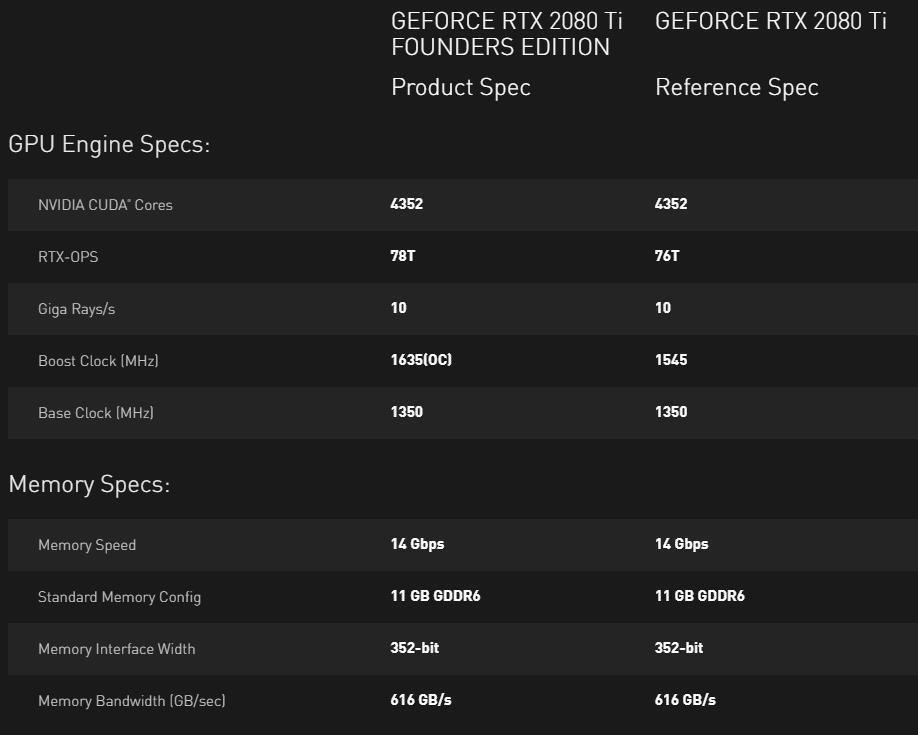
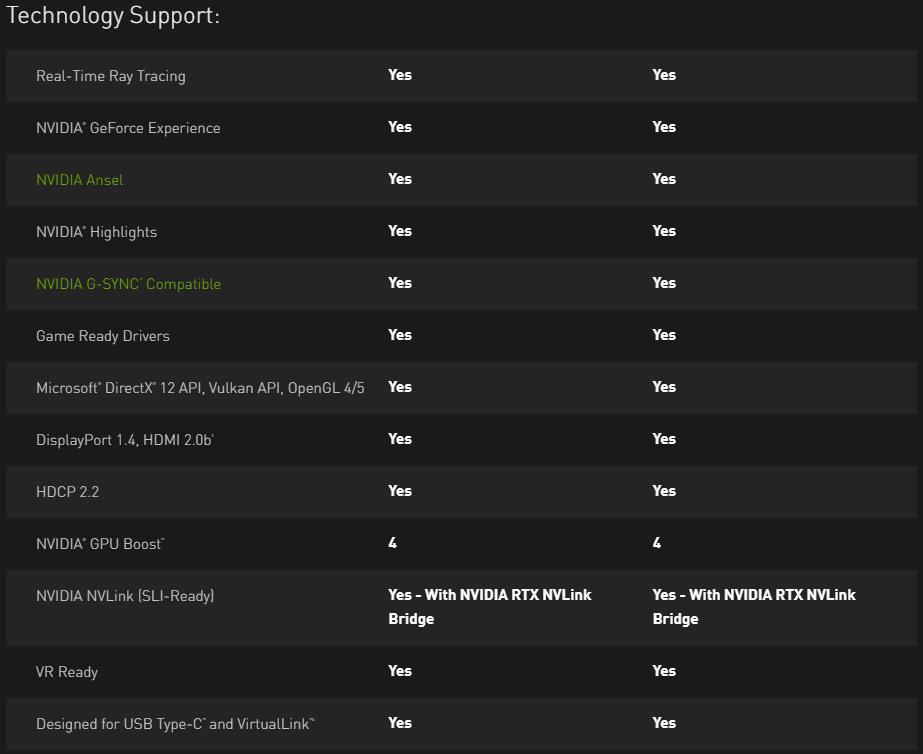
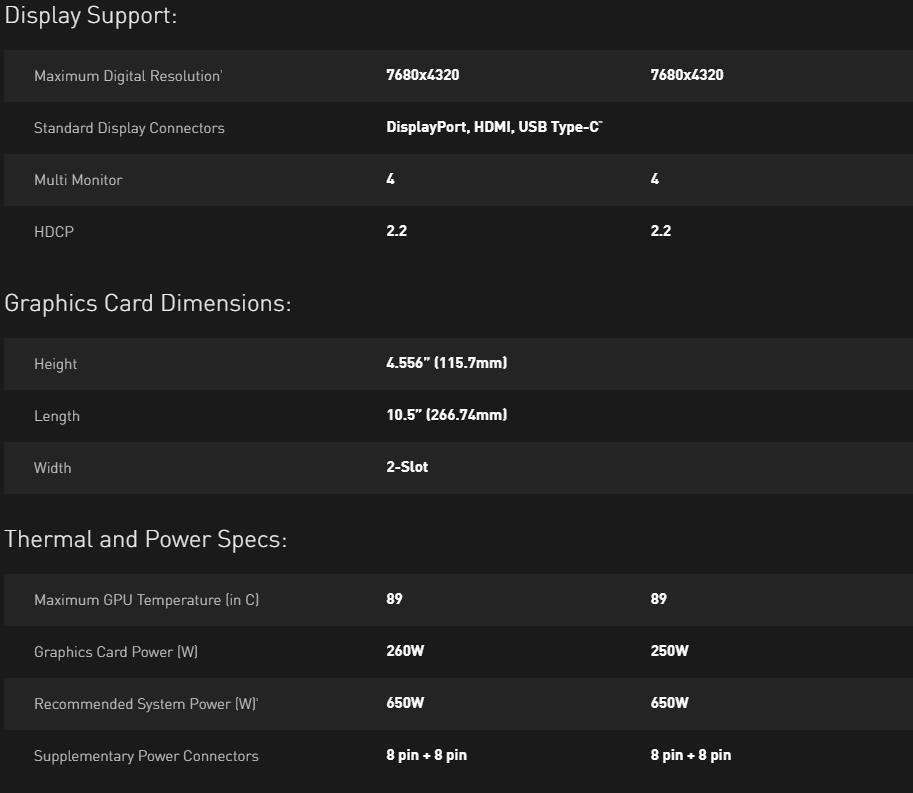
Packaging & Unboxing
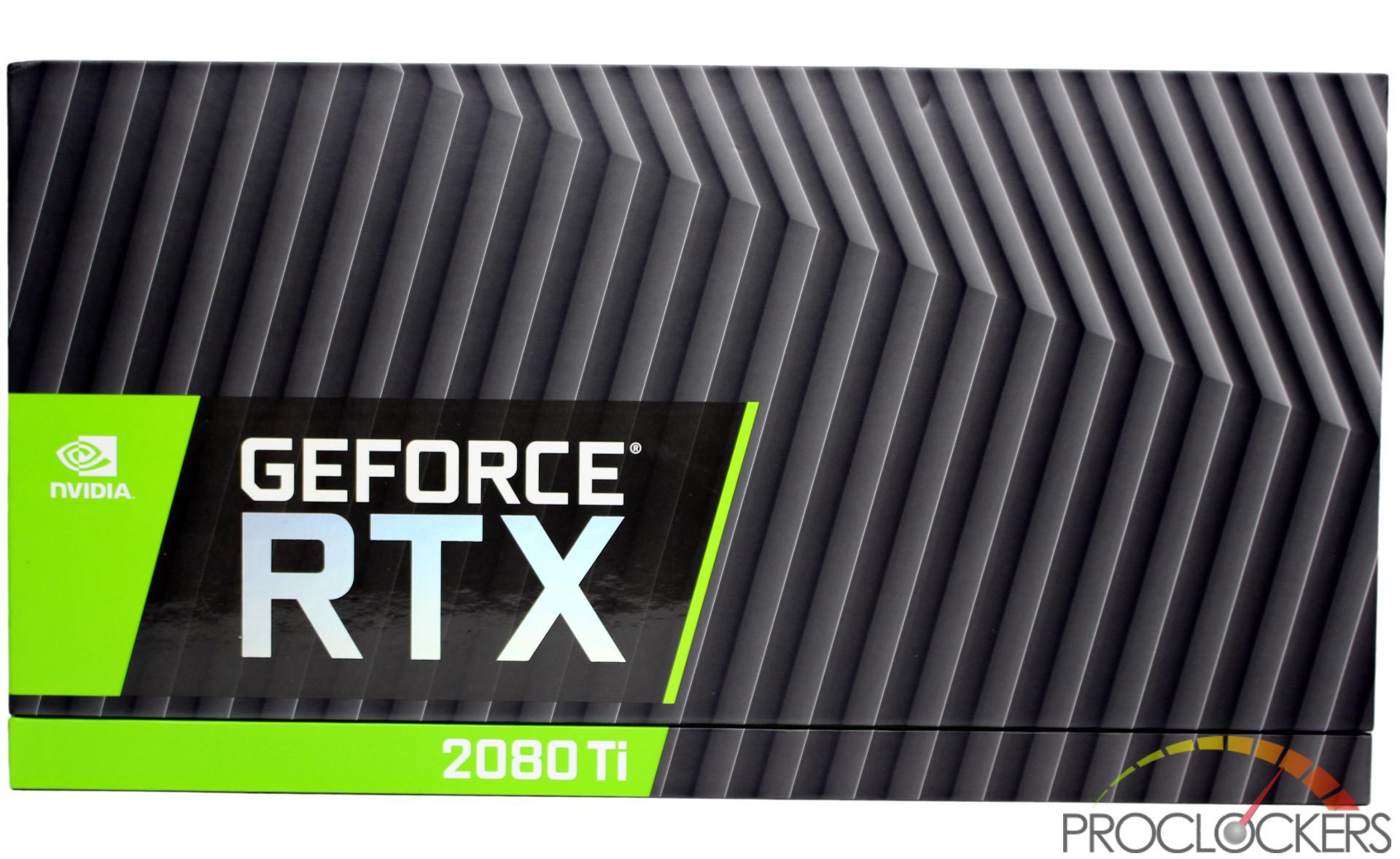
Nvidia’s packaging is extremely efficient and yet somehow still very classy. The GeForce RTX 2080Ti comes in a box similar to previous generations but with a ridged pattern in grey over most of the front.
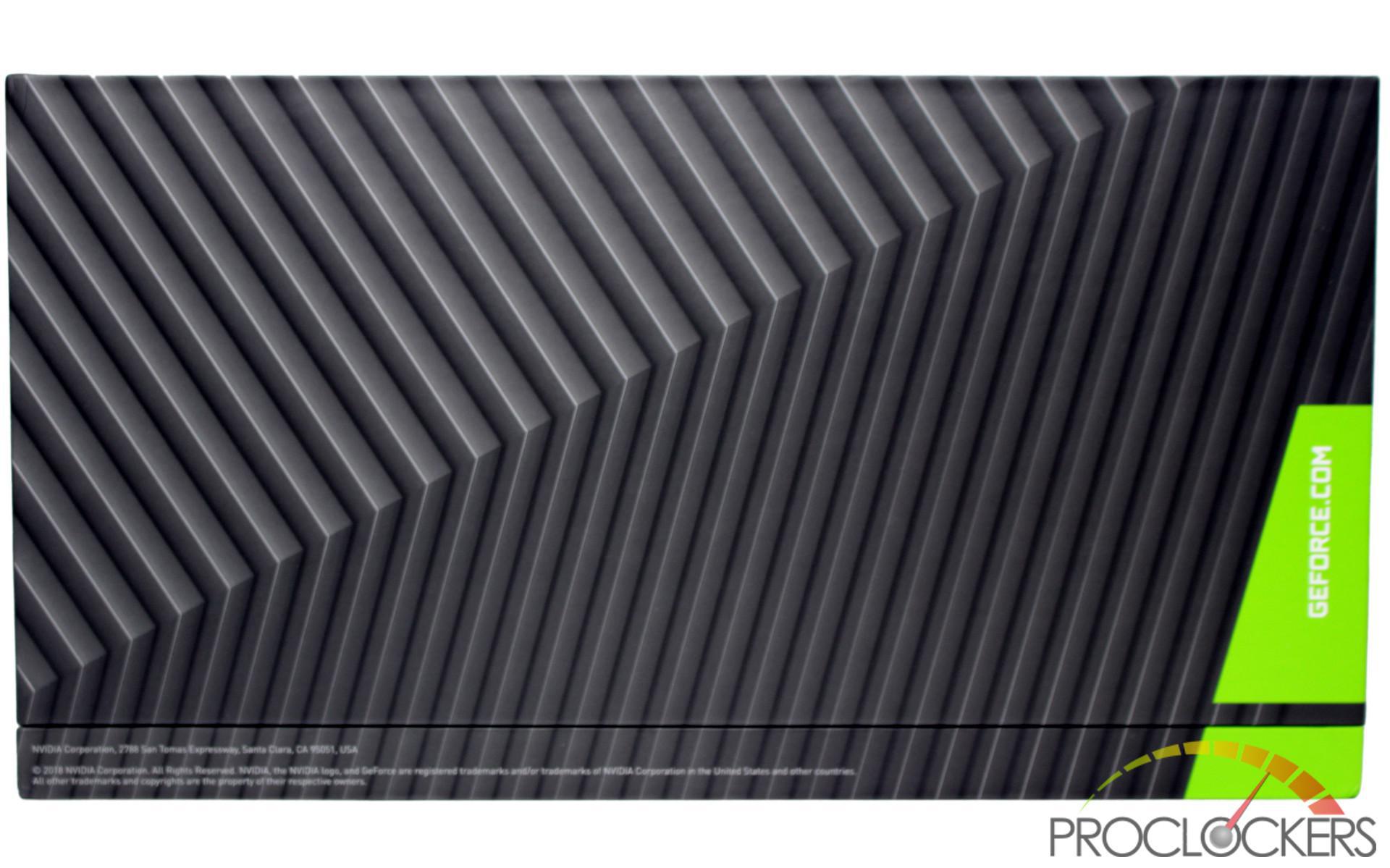
The same pattern covers the back and there really isn’t much to see here.
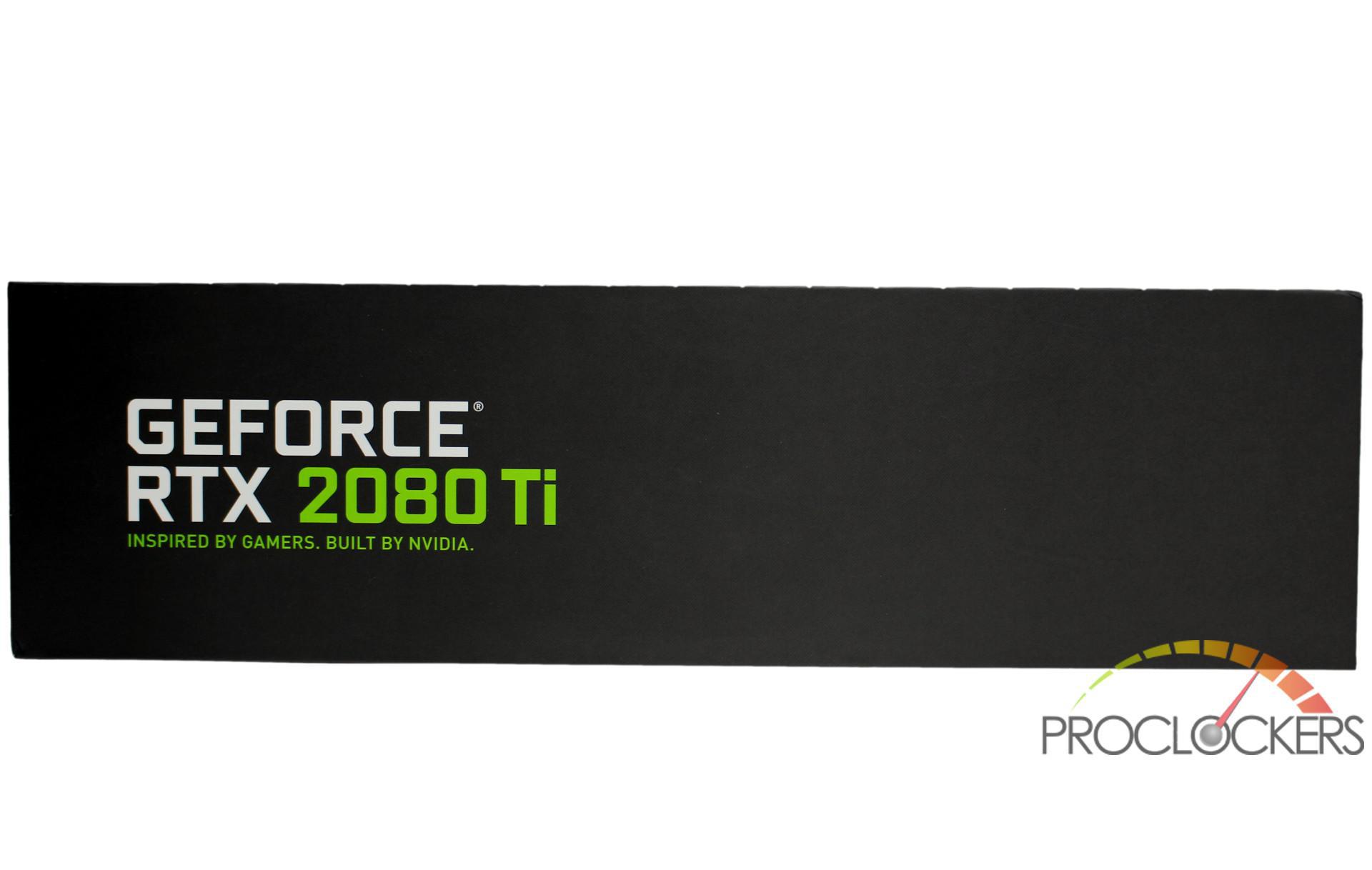
The top of the box is all black with just the model and Nvidia’s GeForce slogan.
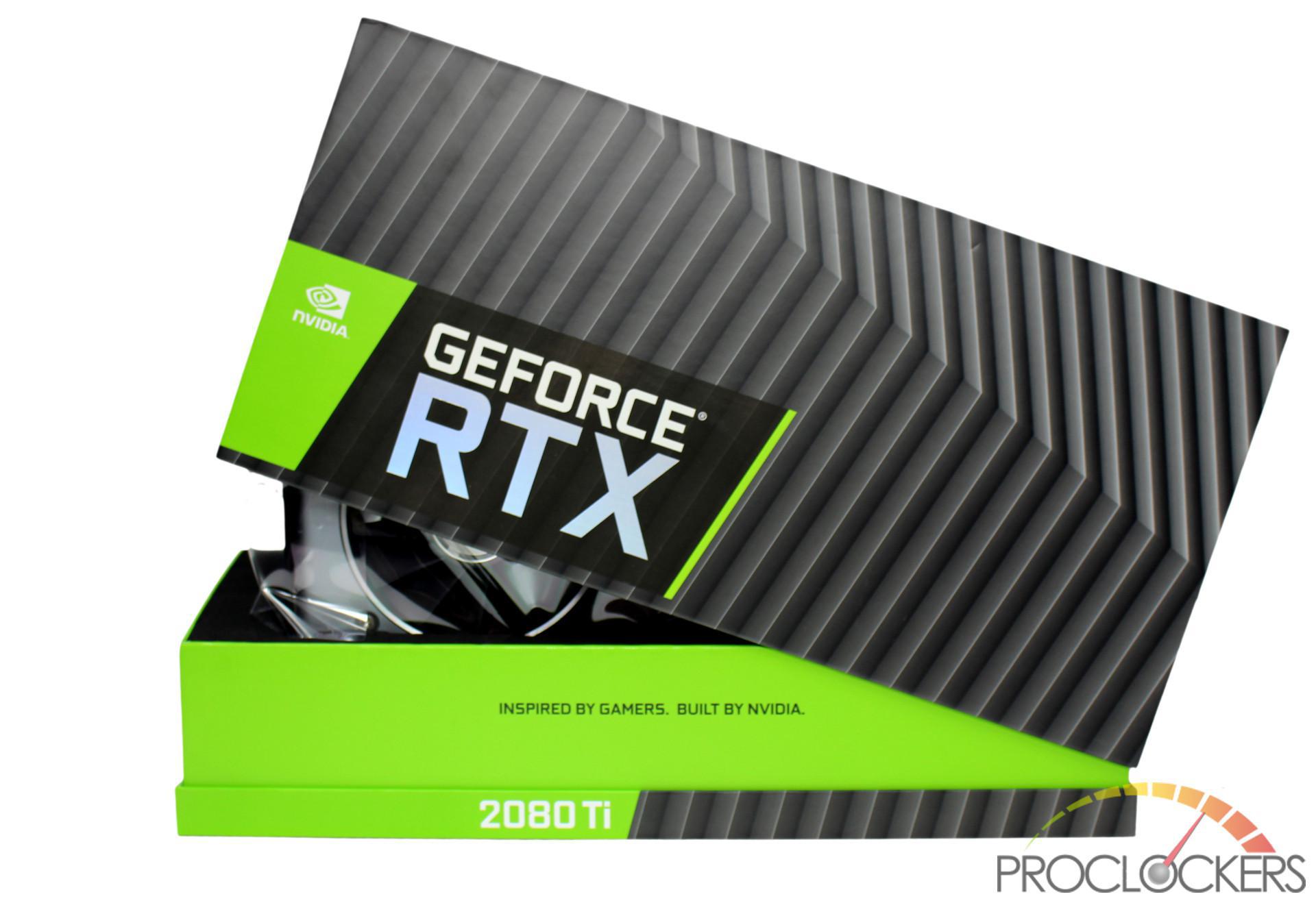
After breaking the tape on each side, the top of the box slides up and off the base that holds the card.
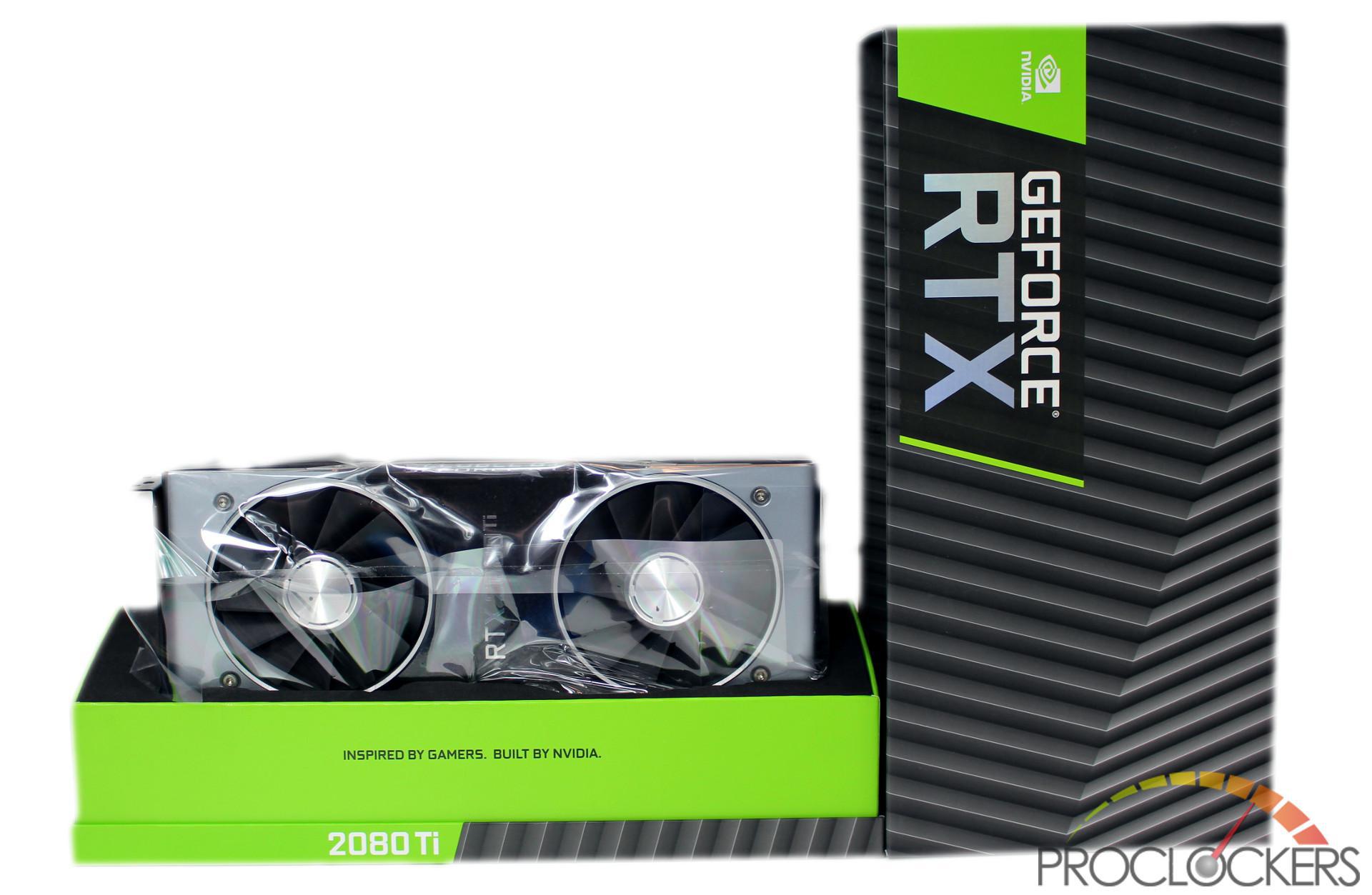
The card is displayed nicely in its foam cradle. It does have a clear wrapper over it initially.
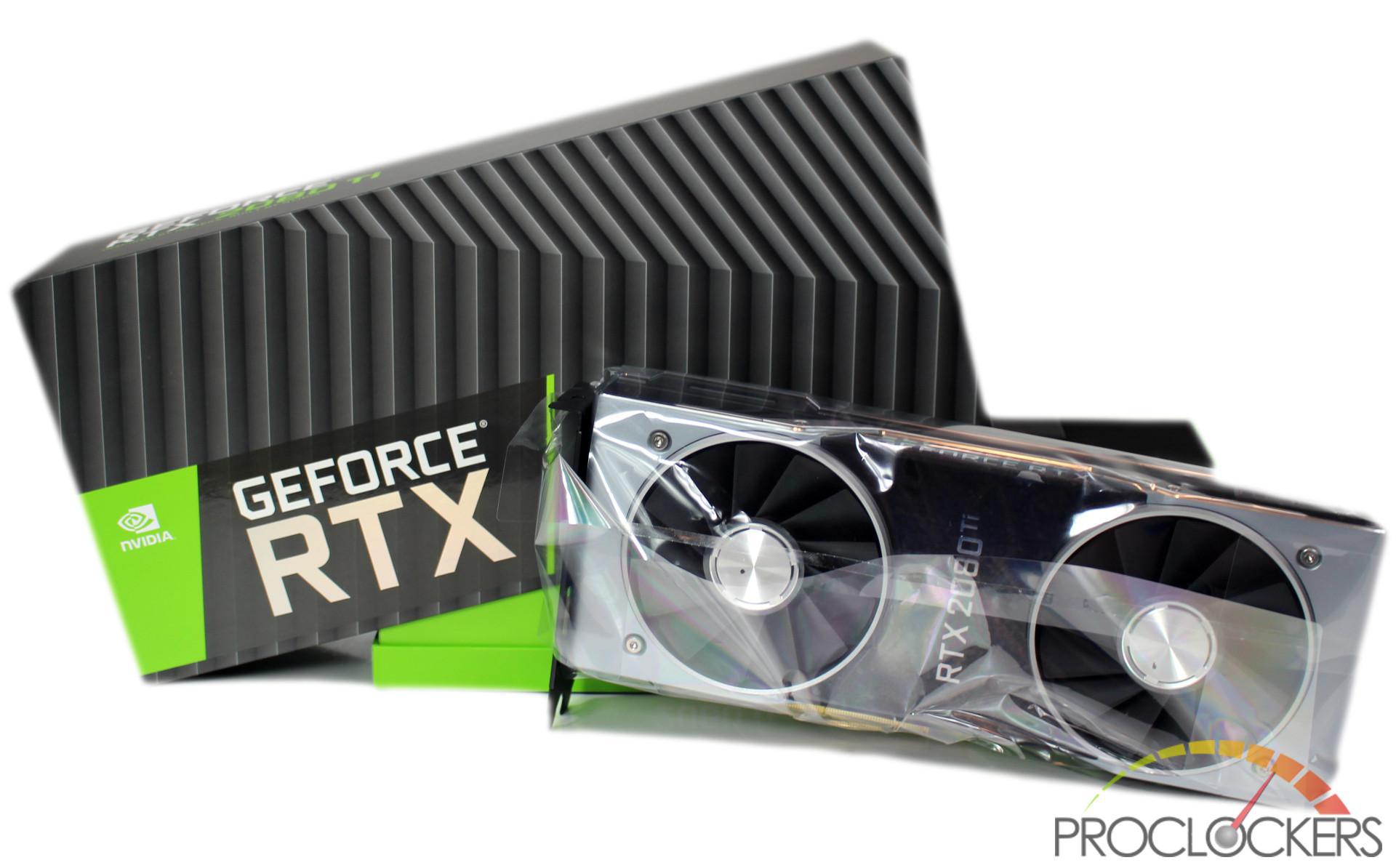
The card merely rests in the base and slides up and out easily.
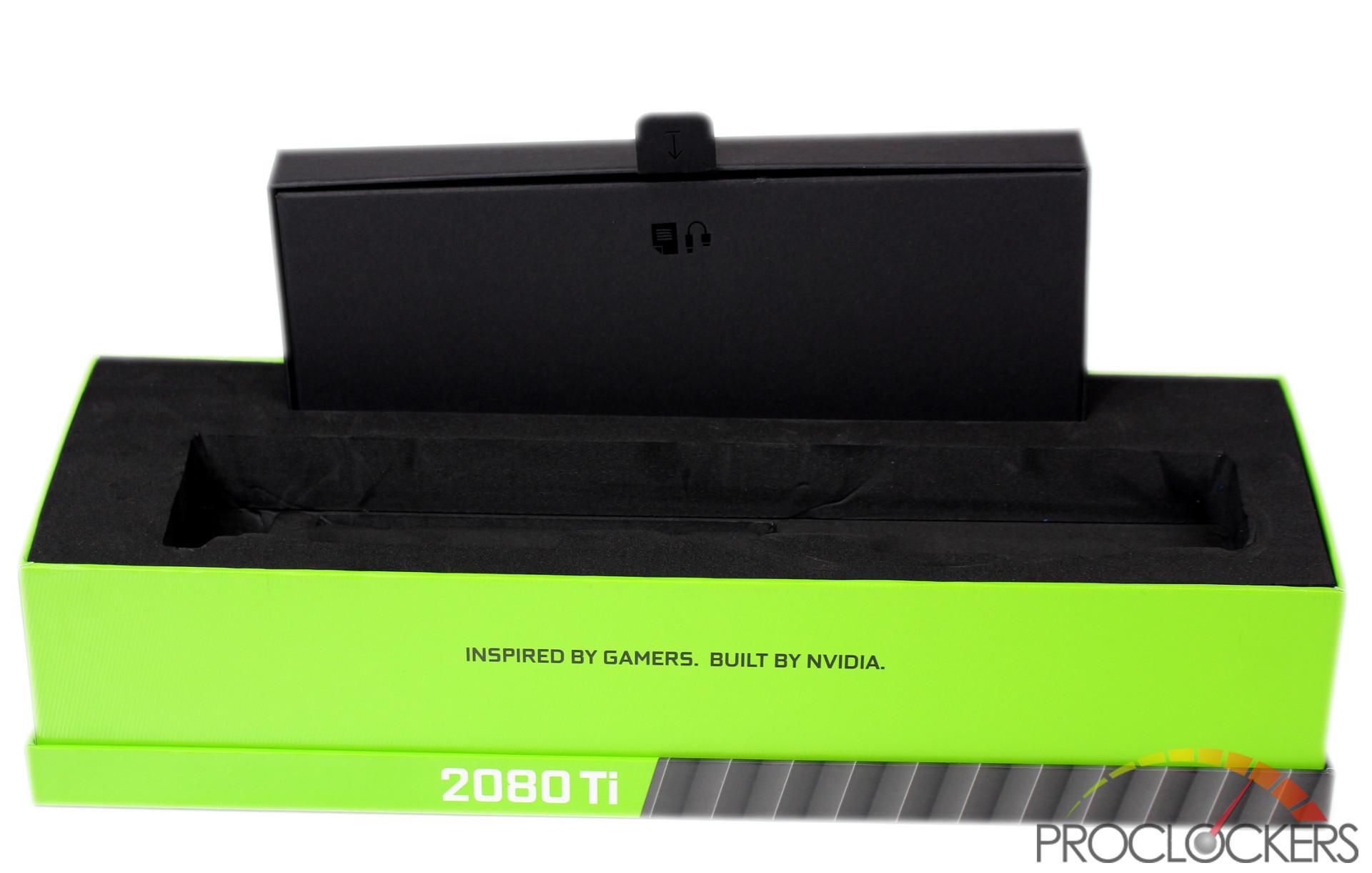
Previous generations had just a packet behind the card in a slot, now there is a good sized black box.
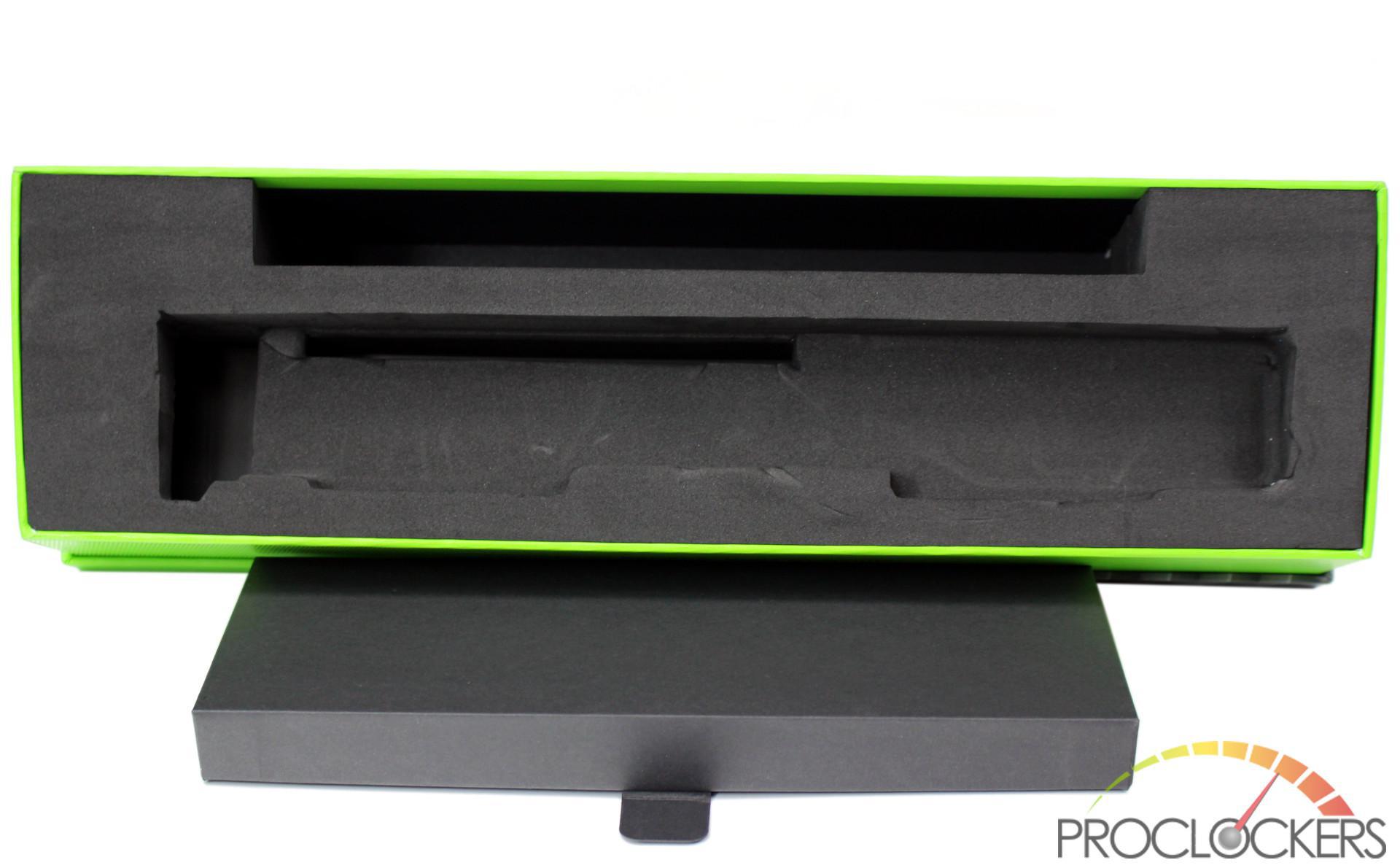
You can see here the entire base of the box is filled with a large foam block with perfect cutouts for the card and accessory box.
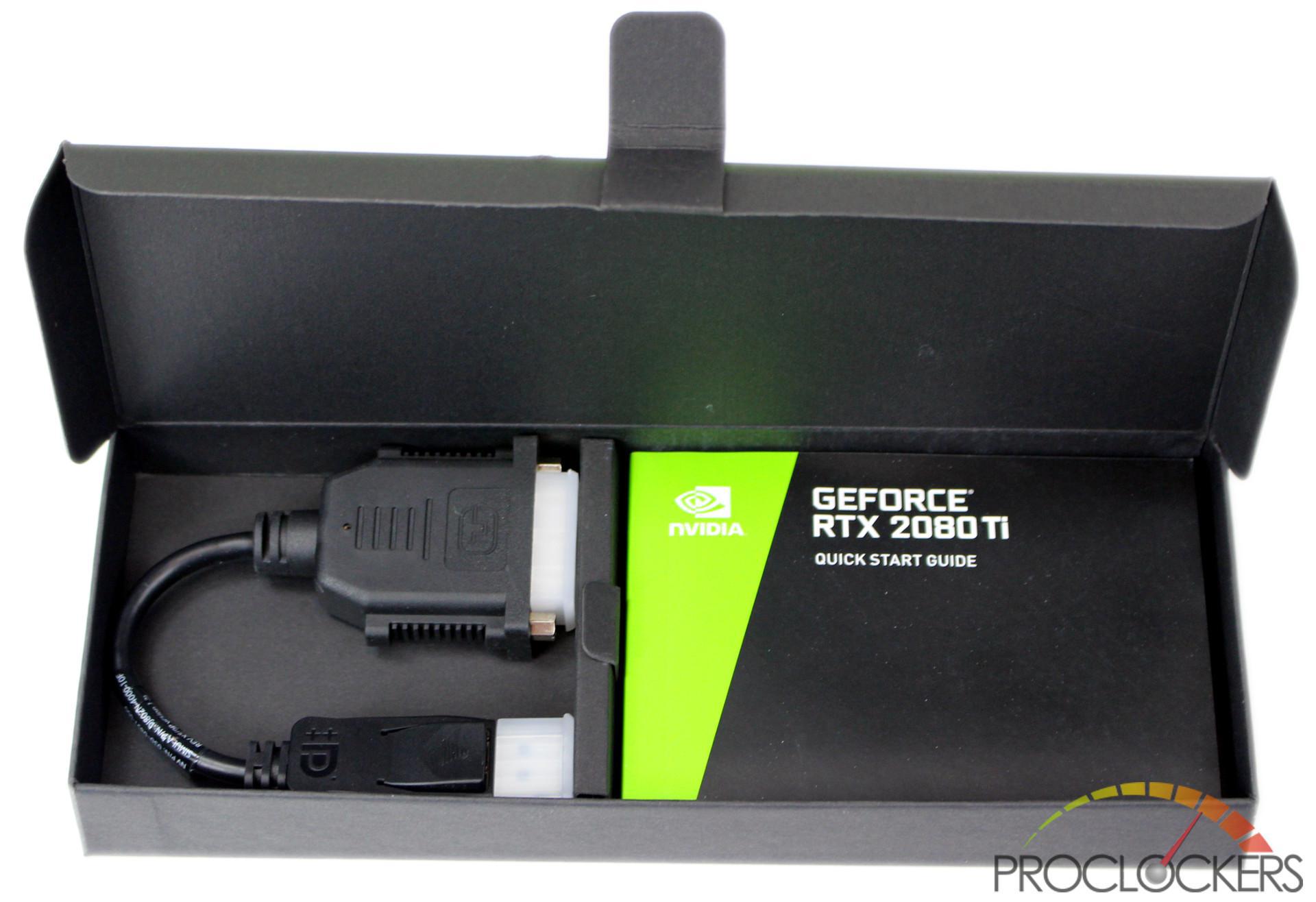
The accessory box has two small booklets and a DisplayPort to DVI adapter.
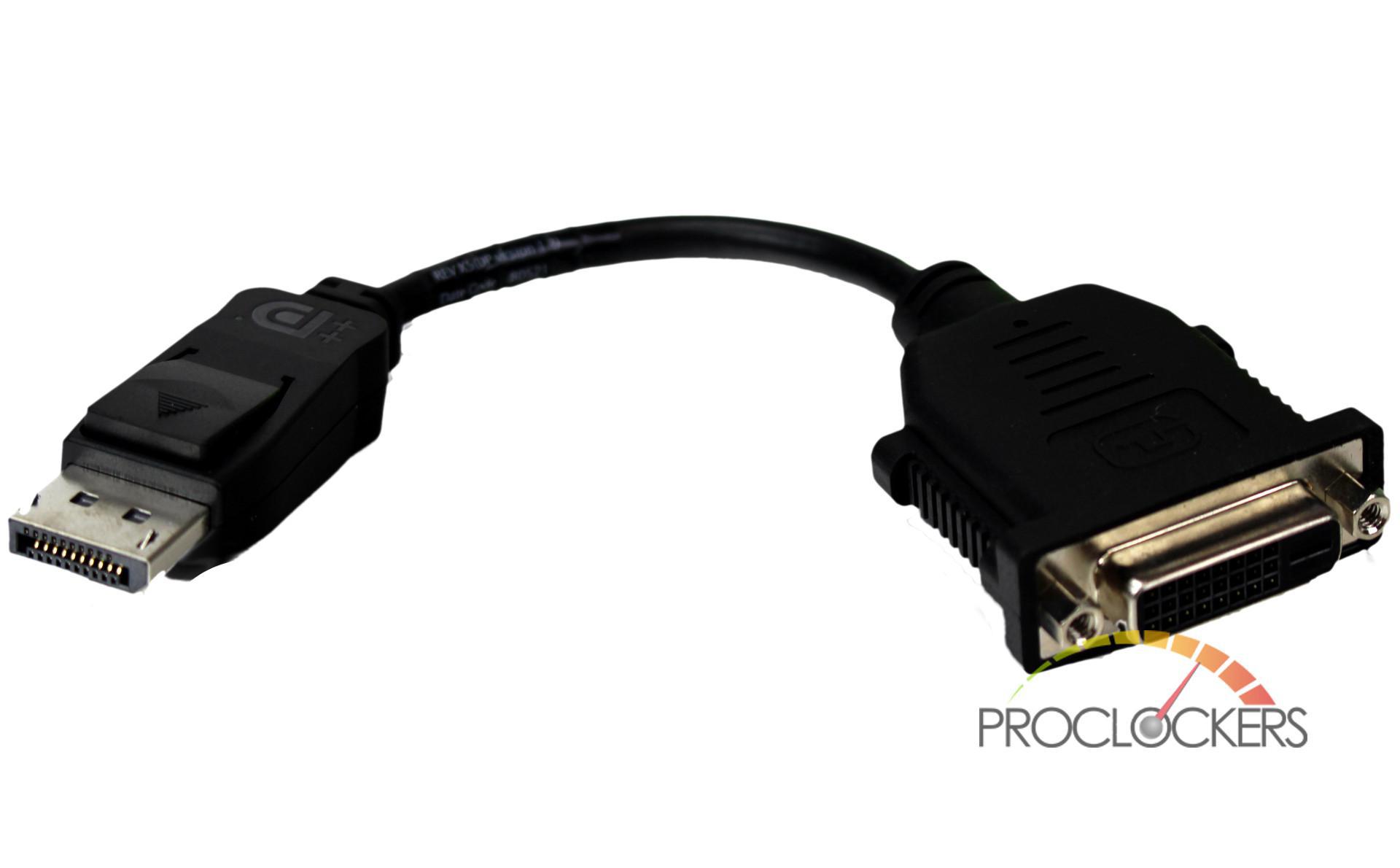
The adapter lets you continue to use up to Dual Link DVI-D monitors with your new RTX GPU.
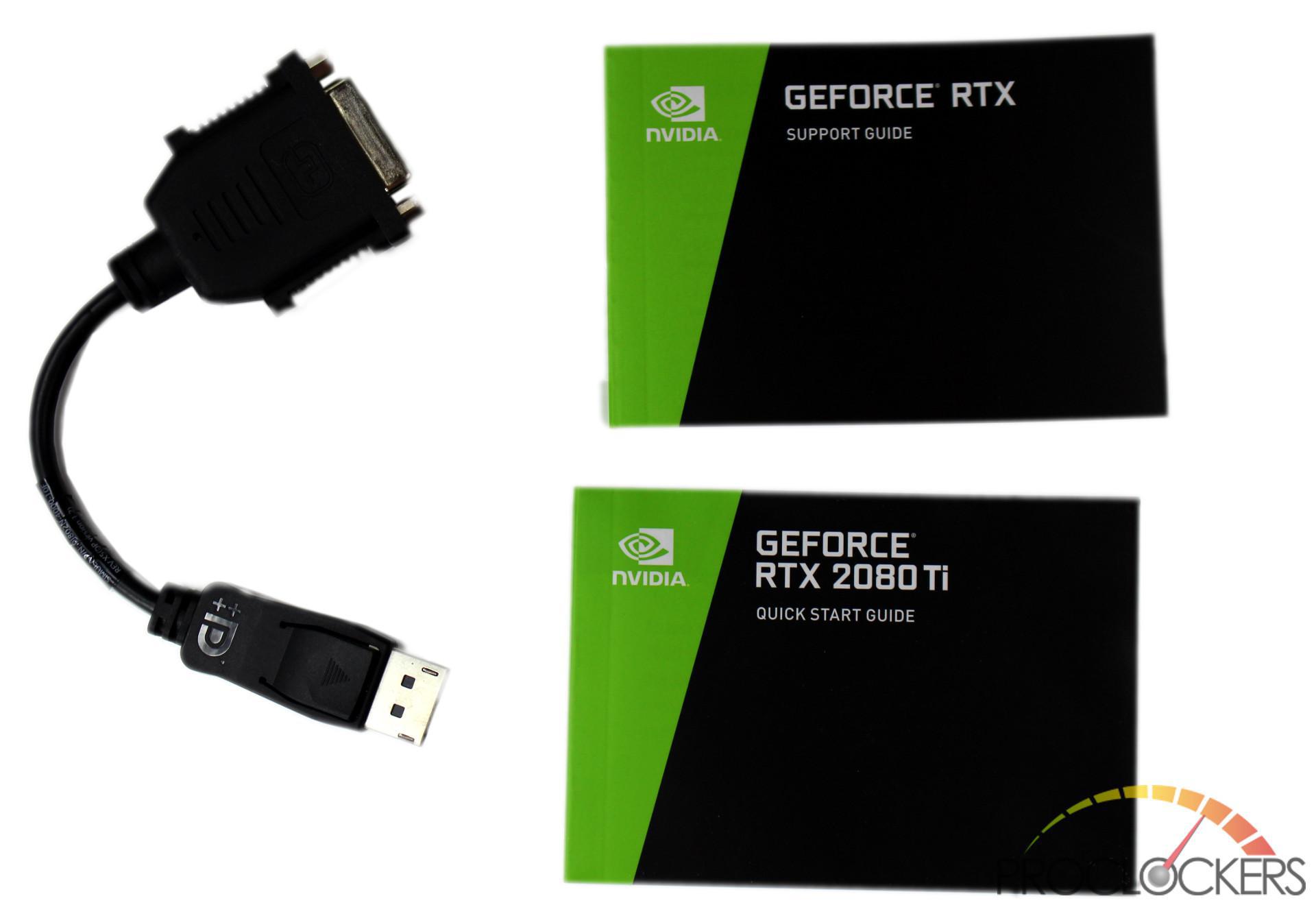
The booklets are a thick support guide and a thinner quick start guide.
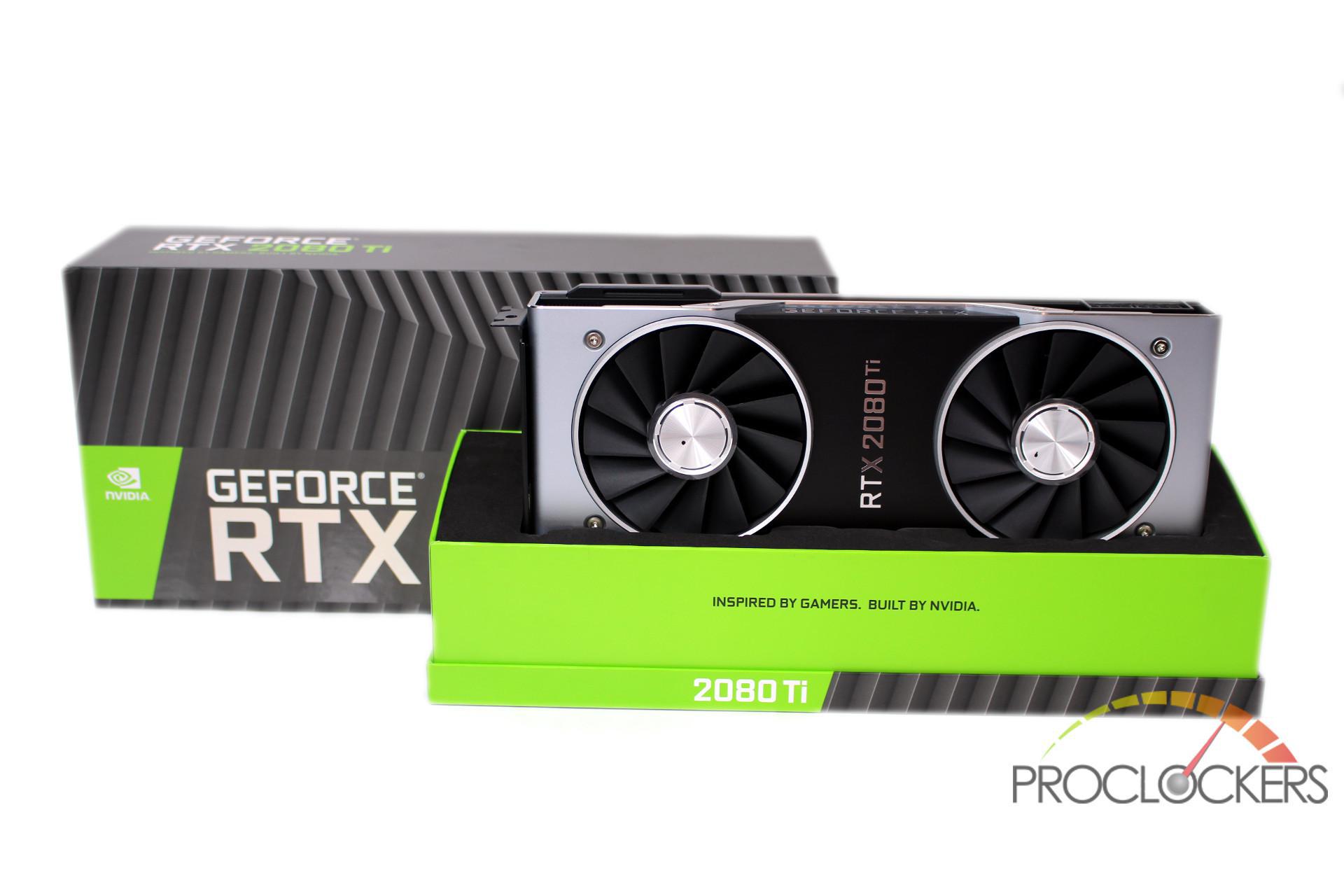
That’s really about it for the packaging, again, very efficient.
A Closer Look
Nvidia’s new RTX lineup has adopted a new Dual fan system over the previous ‘blower’ style system. The shroud is all metal and this makes the card quite hefty and premium feeling.
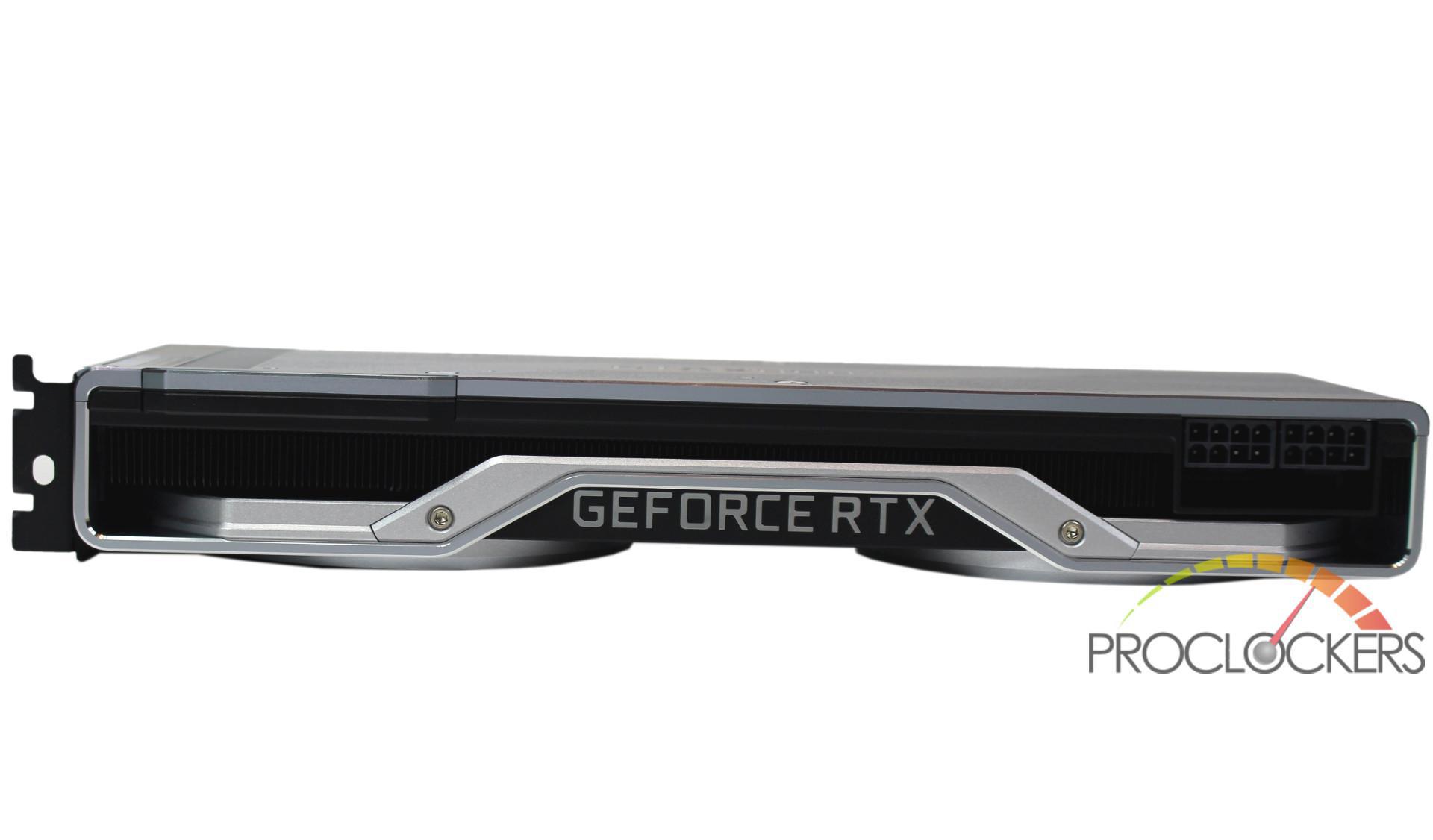
The vapor chamber heatsink assembly is now exhausted out the sides of the card instead of only at the rear which should help card temps considerably, but keep in mind this heat has to go somewhere, your case airflow will now have to deal with it.

The all-metal backplate makes a return, this time in a flawless satin silver. The plate is also a single piece as opposed to say the previous Titan X cards that were two pieces.
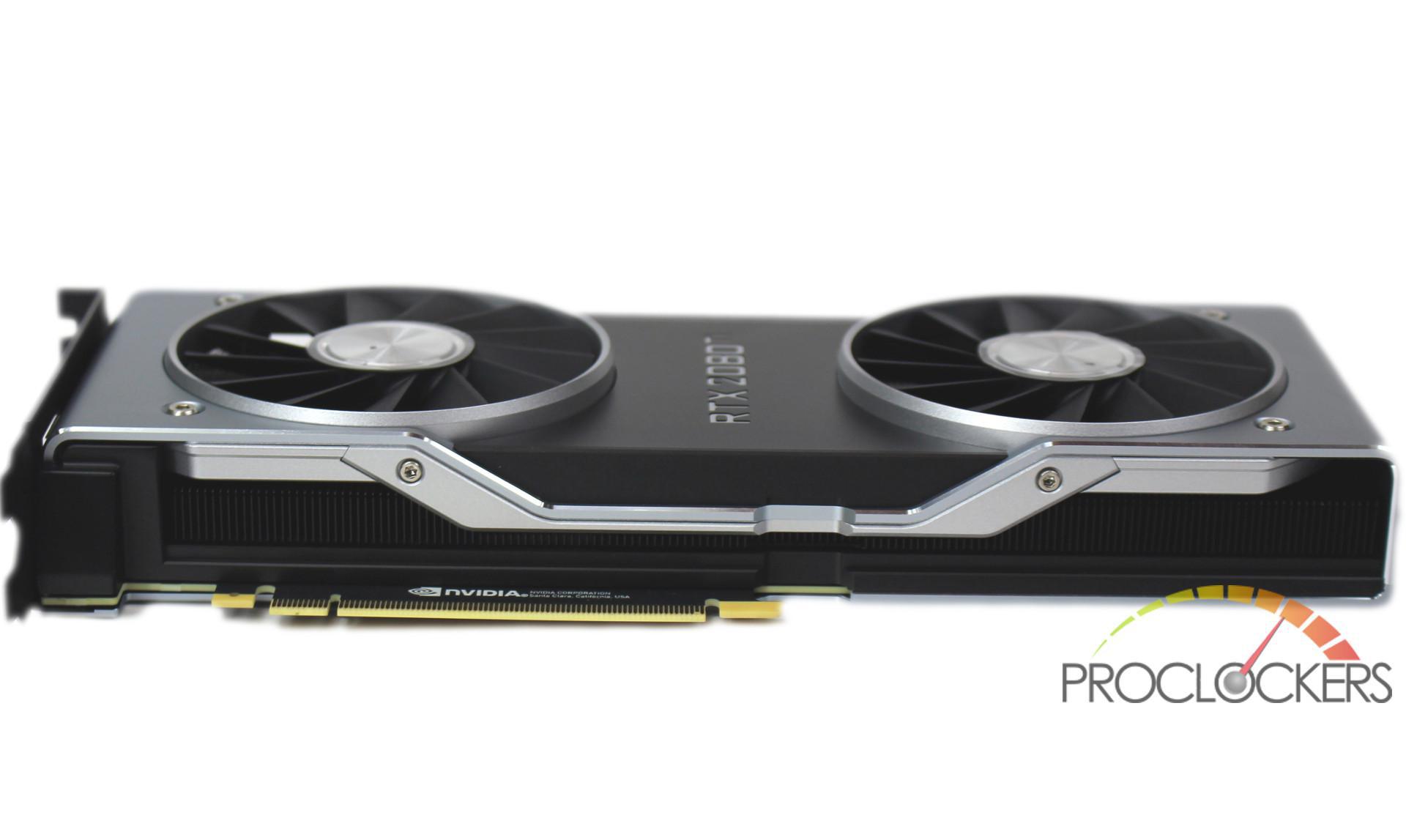
The RTX 2080Ti fits within 2 slots, but the fans are very close to the surface of the two fan wells, putting this GPU right next to another large card would heavily impede its airflow, microATX SLI users beware!
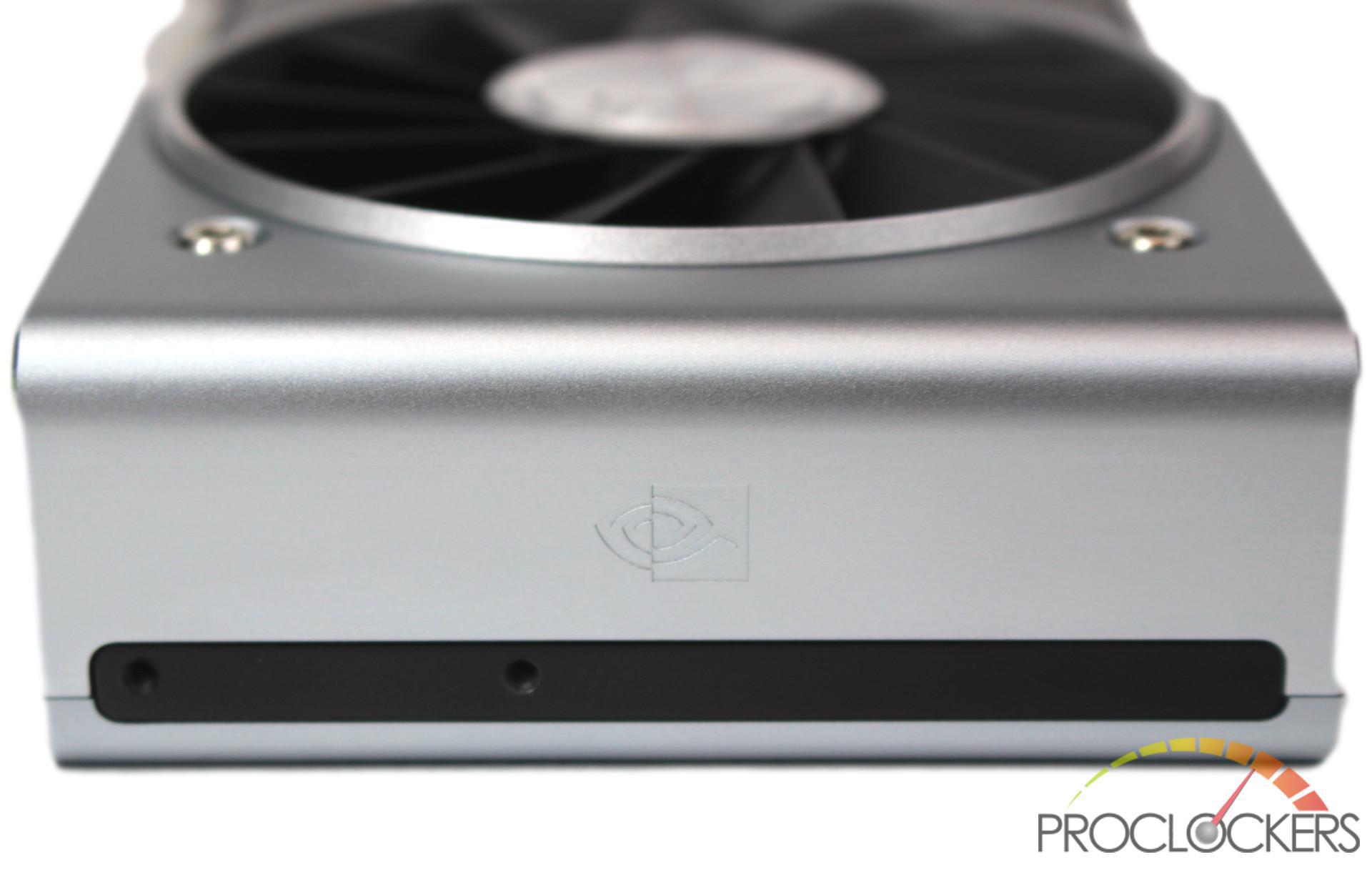
The rear of the card has an Nvidia eye logo and two threaded holes, presumably for mounting a rear support brace.
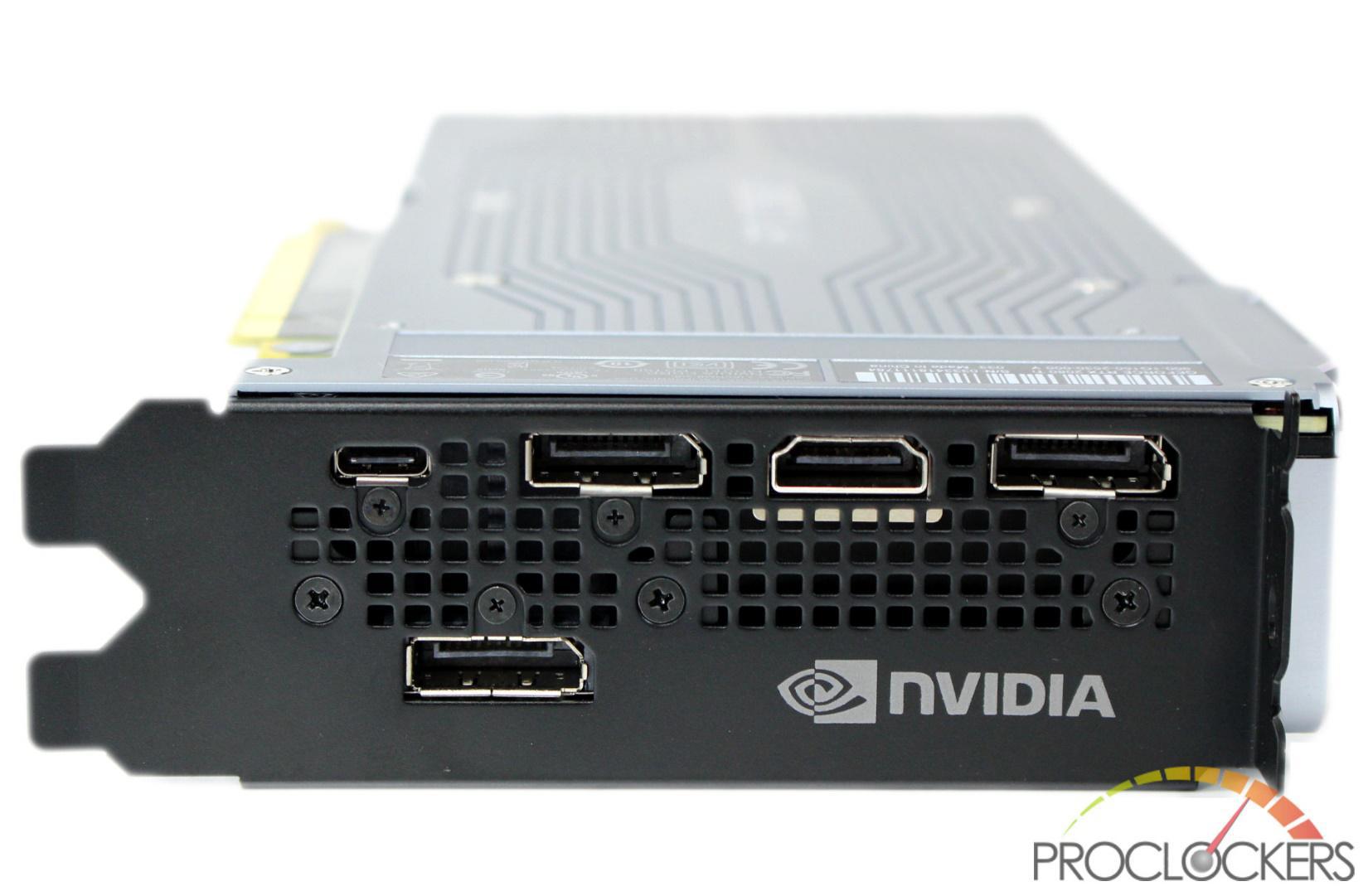
I/O ports are now comprised of a trio of DisplayPort 1.4 connections, an HDMI 2.0b and a new USB-C that will support the upcoming VirtualLink system for VR. VirtualLink provides a single cable supporting all of the power, display and bandwidth requirements. That includes support for four lanes of HBR3 DisplayPort for high-resolution displays, USB 3.1 Gen2 (SuperSpeed USB 10Gbps) for headset cameras and sensors, and up to 27 Watts of power delivery. Sadly, this does not support PCIe type connectivity for Thunderbolt 3.
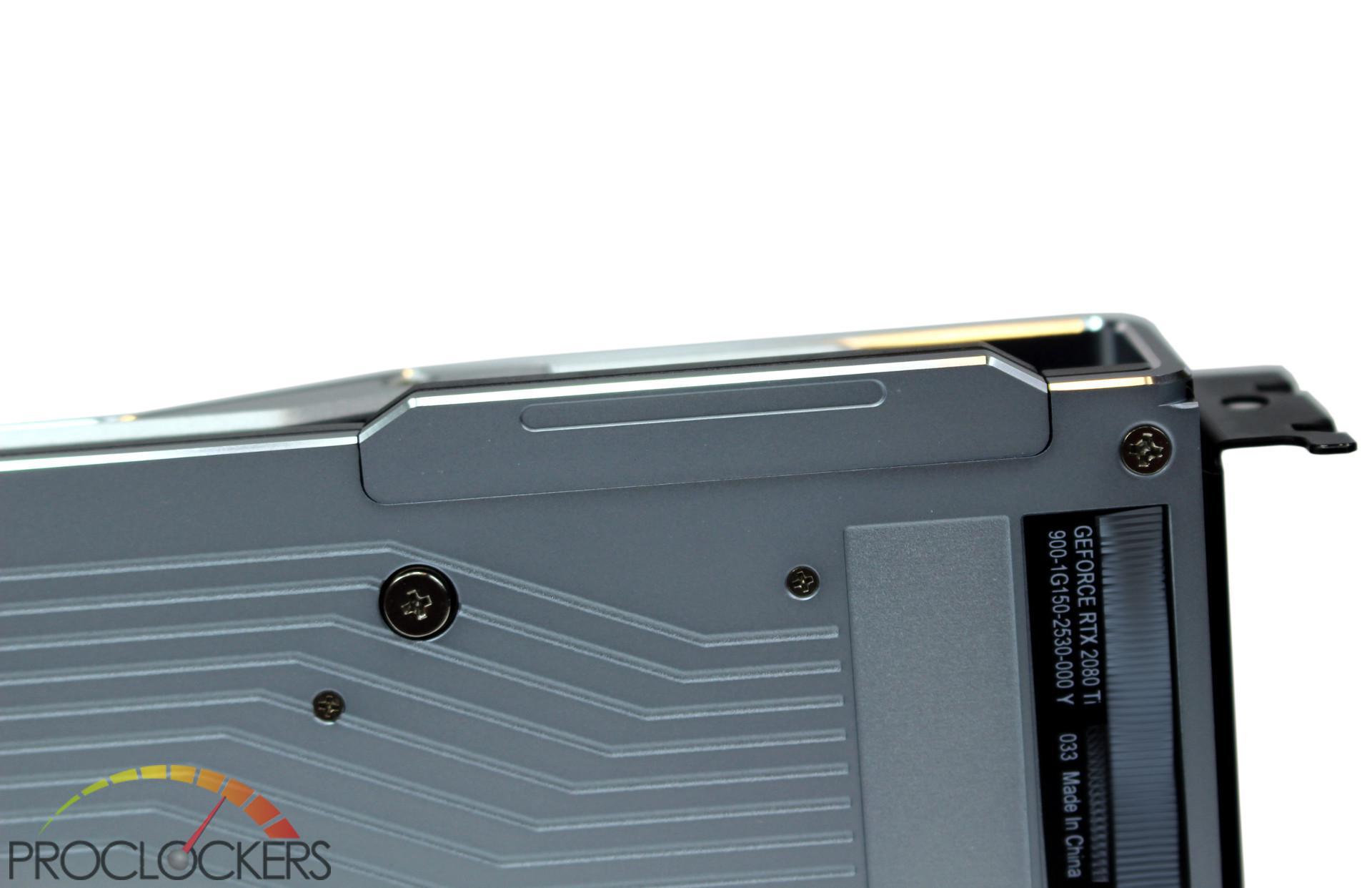
The RTX 2080Ti eschews from the long-standing SLI connectors and moves to the new NV-Link system. It’s hidden under a sleek cover that blends in well when not in use.
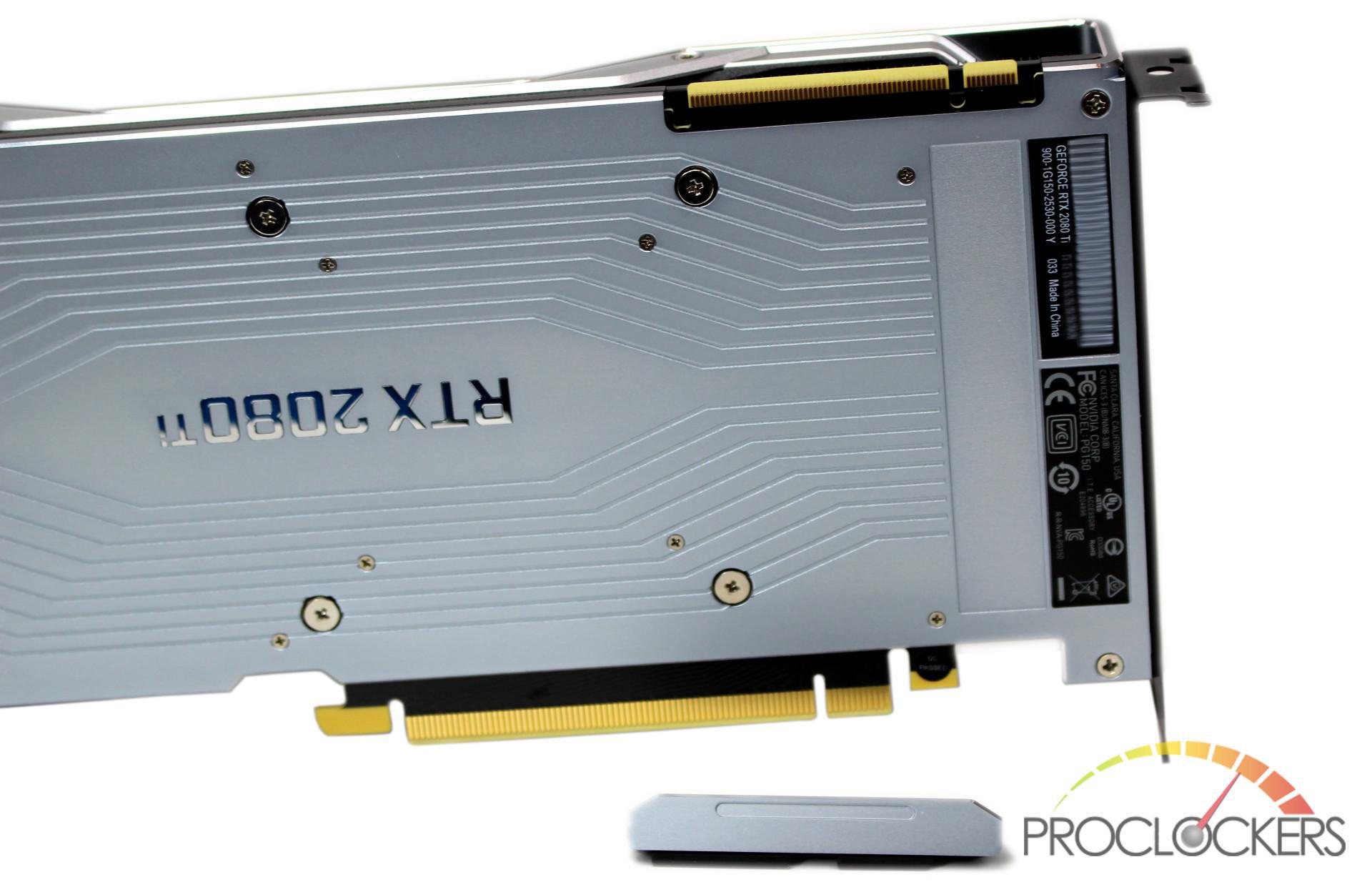
The cap simply slides off the connector.
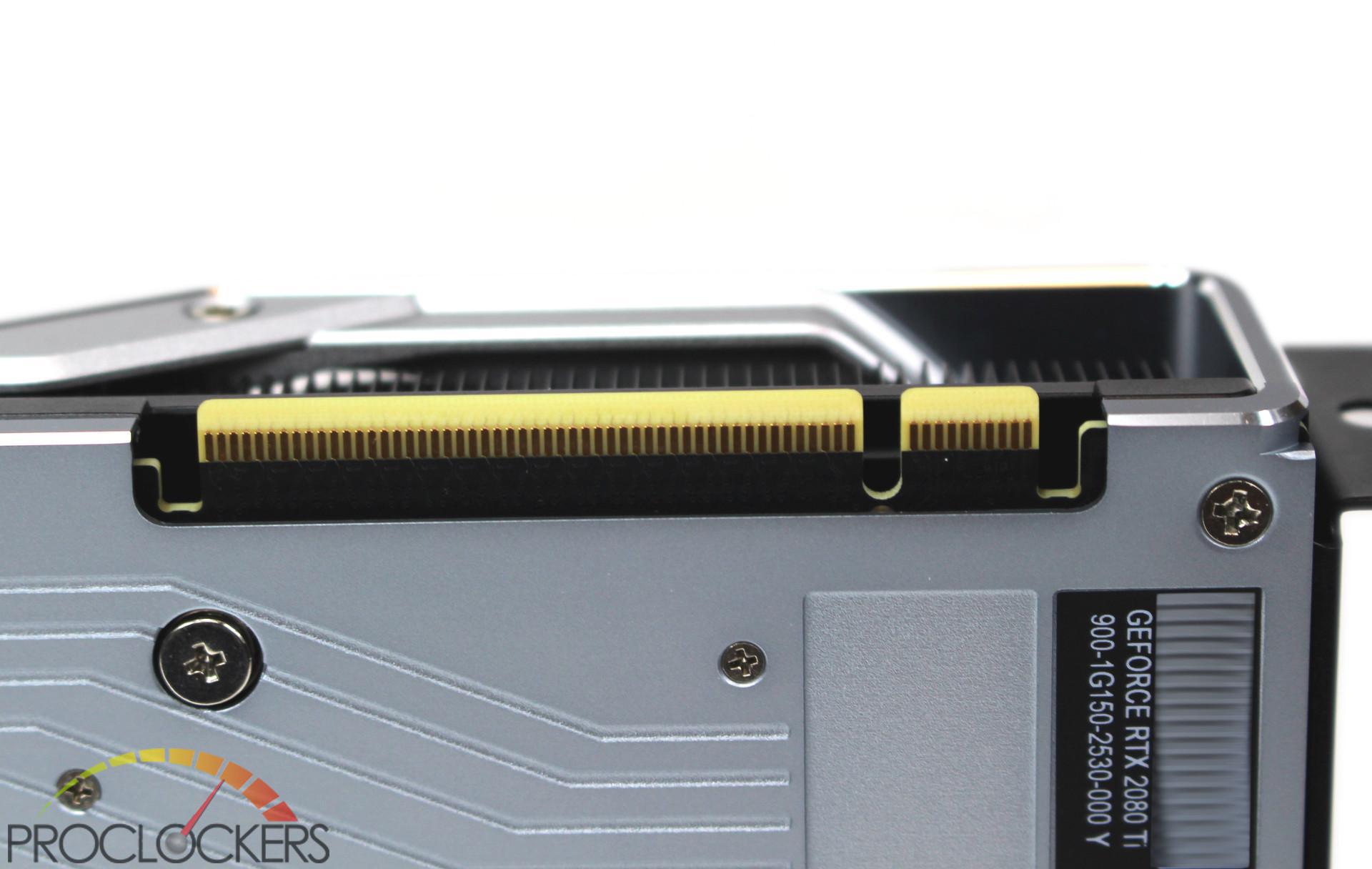
It nearly looks like a mini version of the PCIe connector on the other side of the card. With a 50X increase in bandwidth over SLI connections, this connection is ready for far more than multi-GPU SLI purposes. Believe it or not, this connector actually has more bandwidth than the PCIe x16 connection.
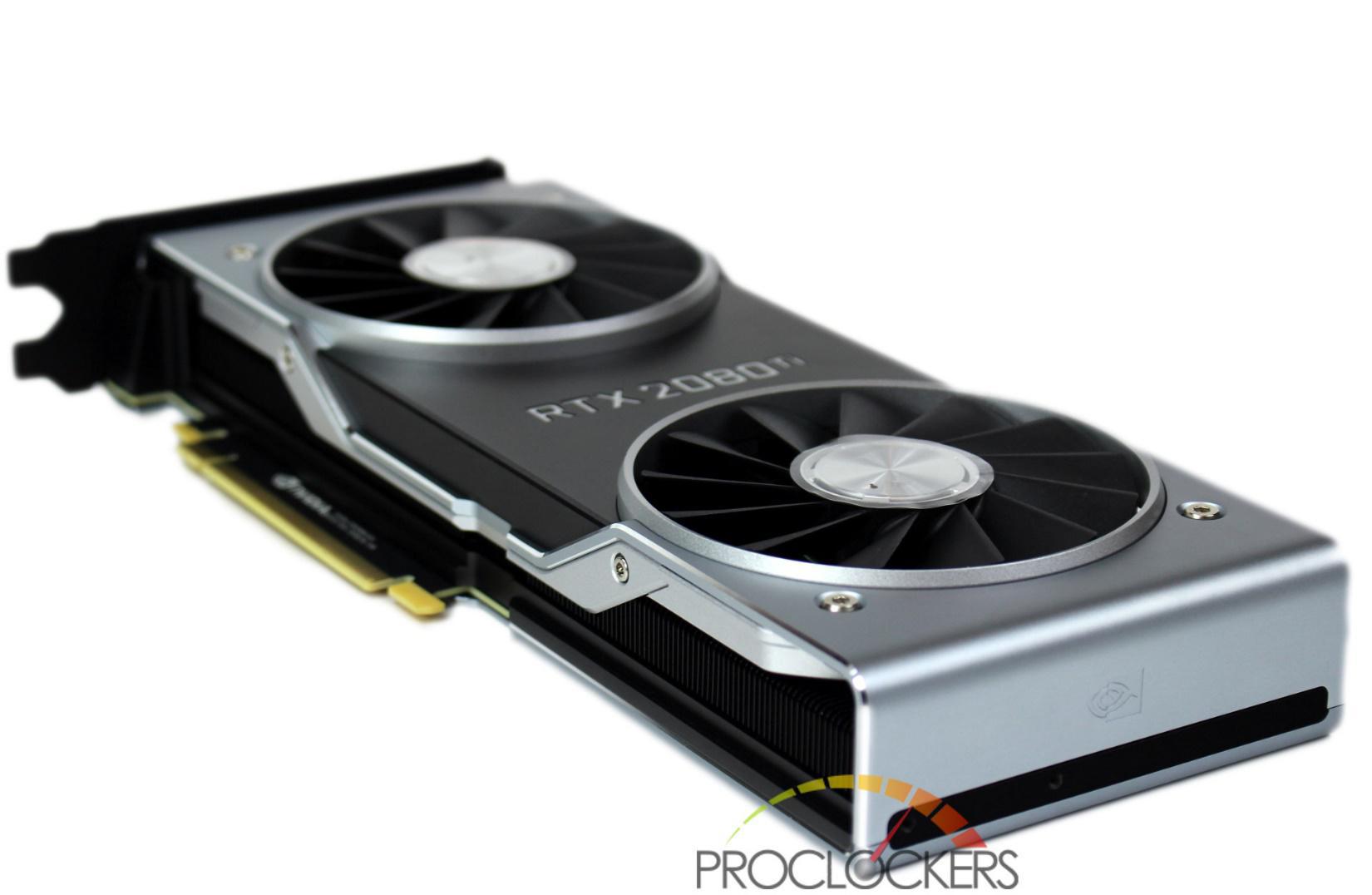
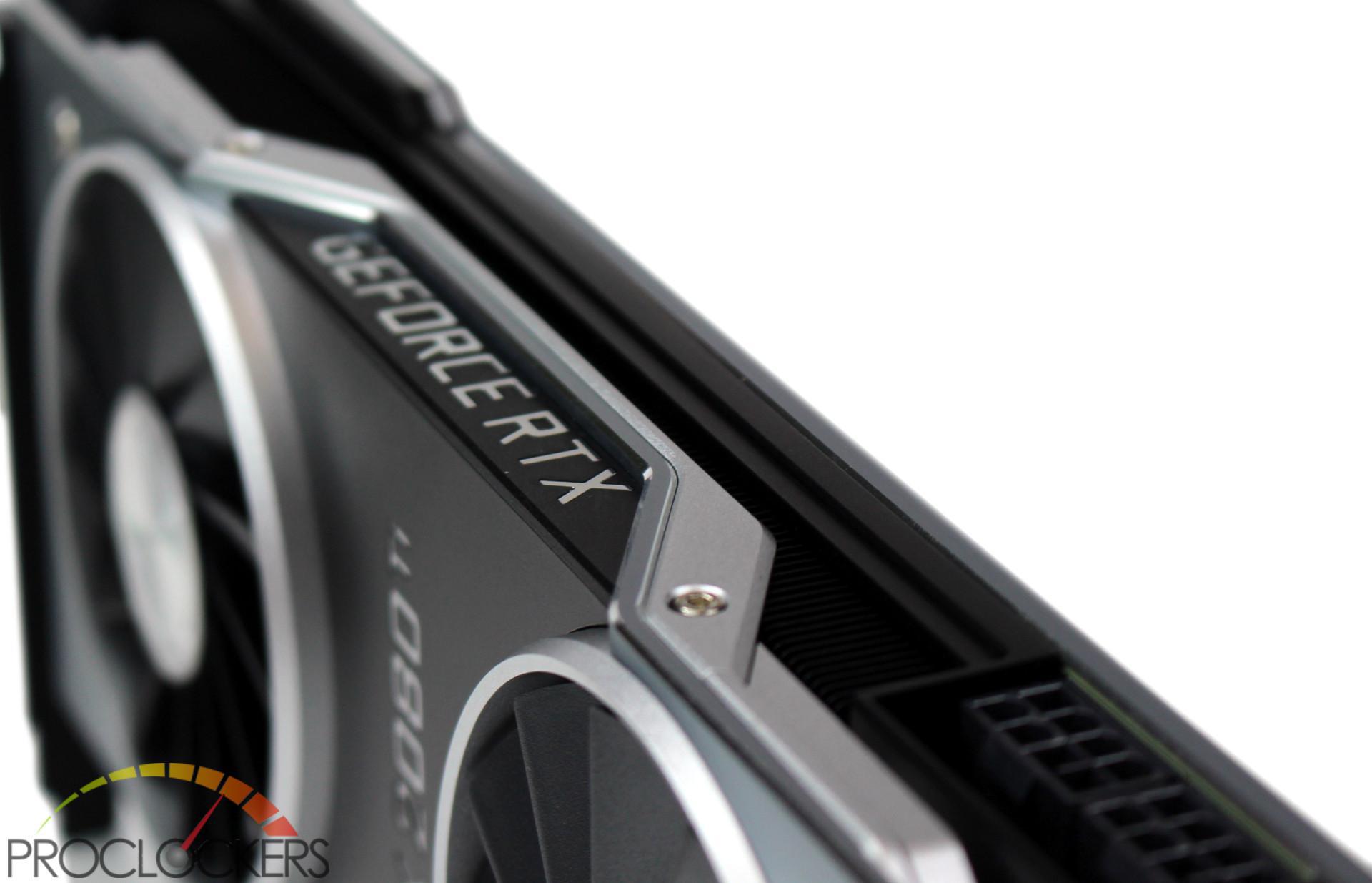
Of course, we had to throw a few glamor shots in, this card is just beautiful.
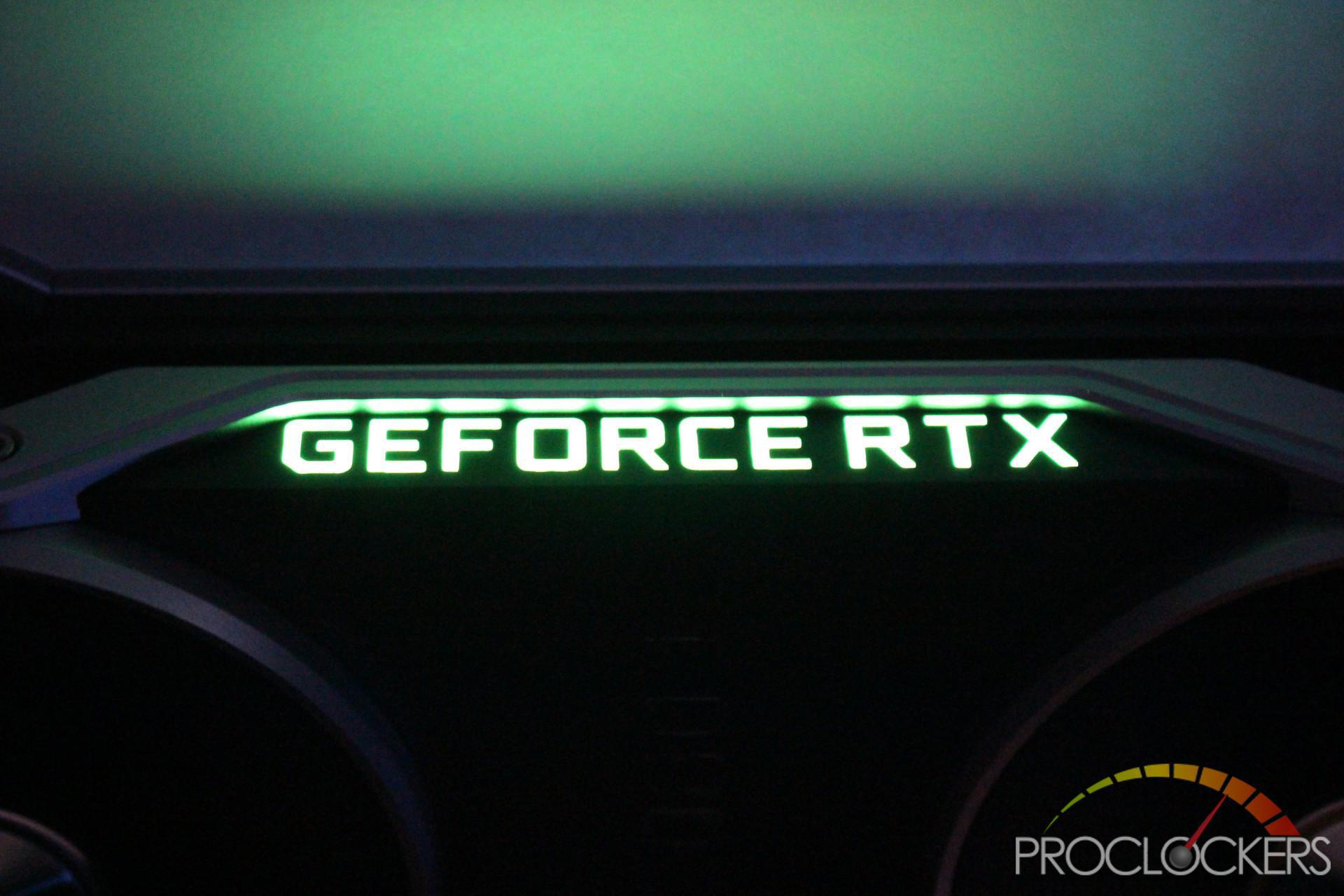
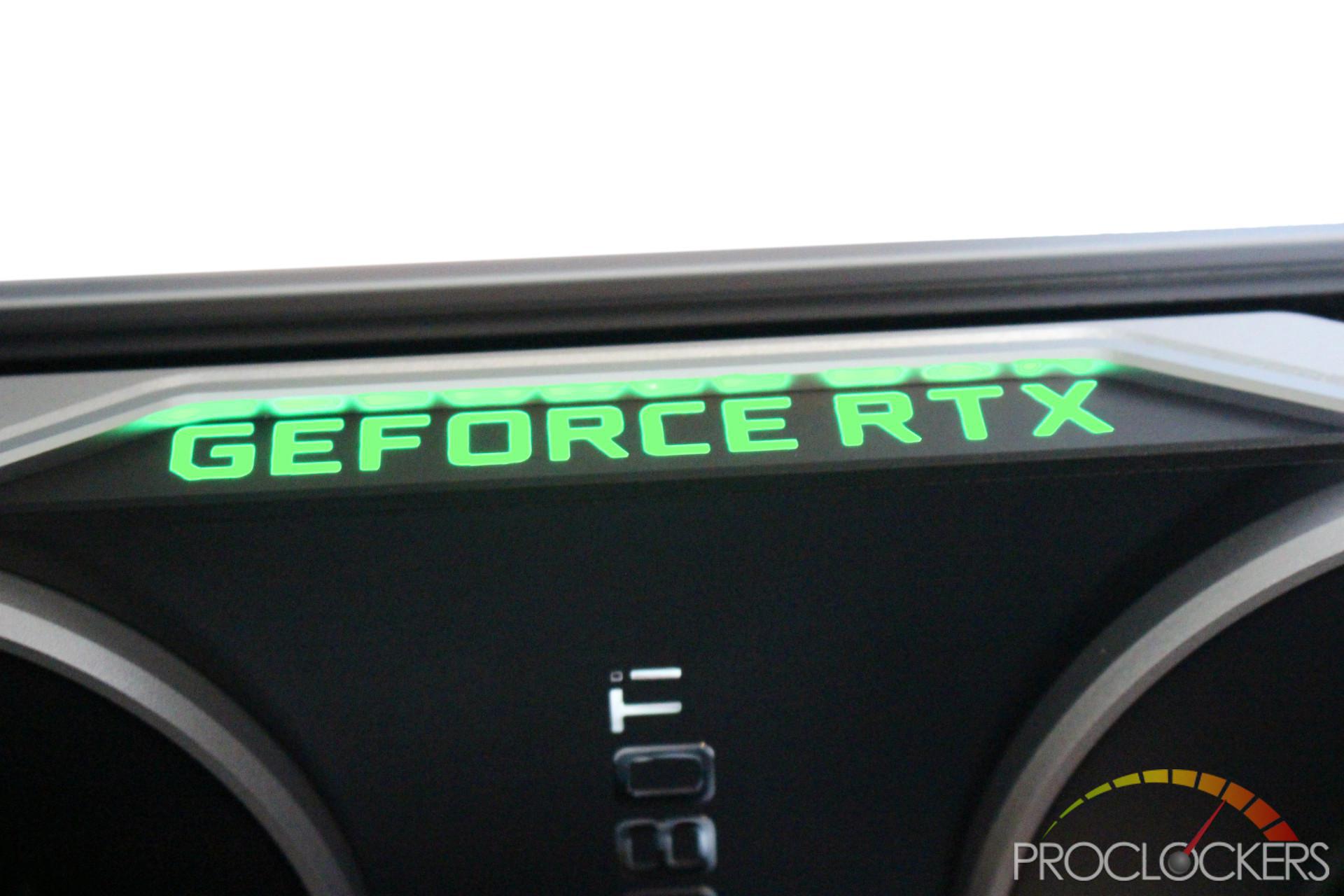
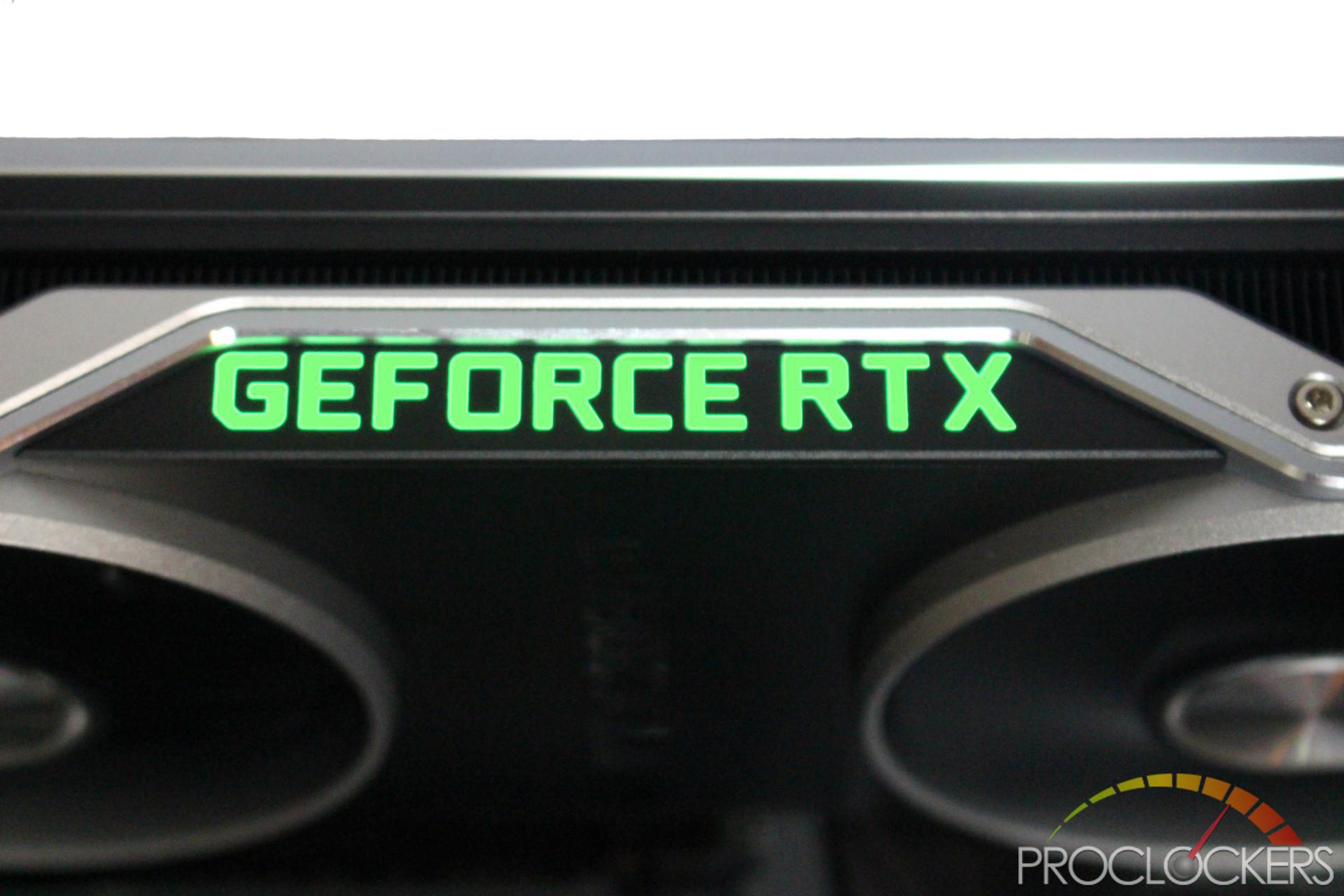
Another thing to note is the silver ‘GEFORCE RTX’ logo on the edge of the card actually lights up in the traditional Nvidia green when powered on. Awesome! Honestly, given the onslaught over RGB these days, we’re a little surprised the logo is monochromatic.
Under the Hood

As the GeForce RTX 2080Ti appears to be similar to previous generations on assembly, we’ll start by removing a small pile of screws from the backplate.
The back plate does play a role in cooling this time with thermal pads removing heat from the GPU die, memory and VRM area of the PCB.
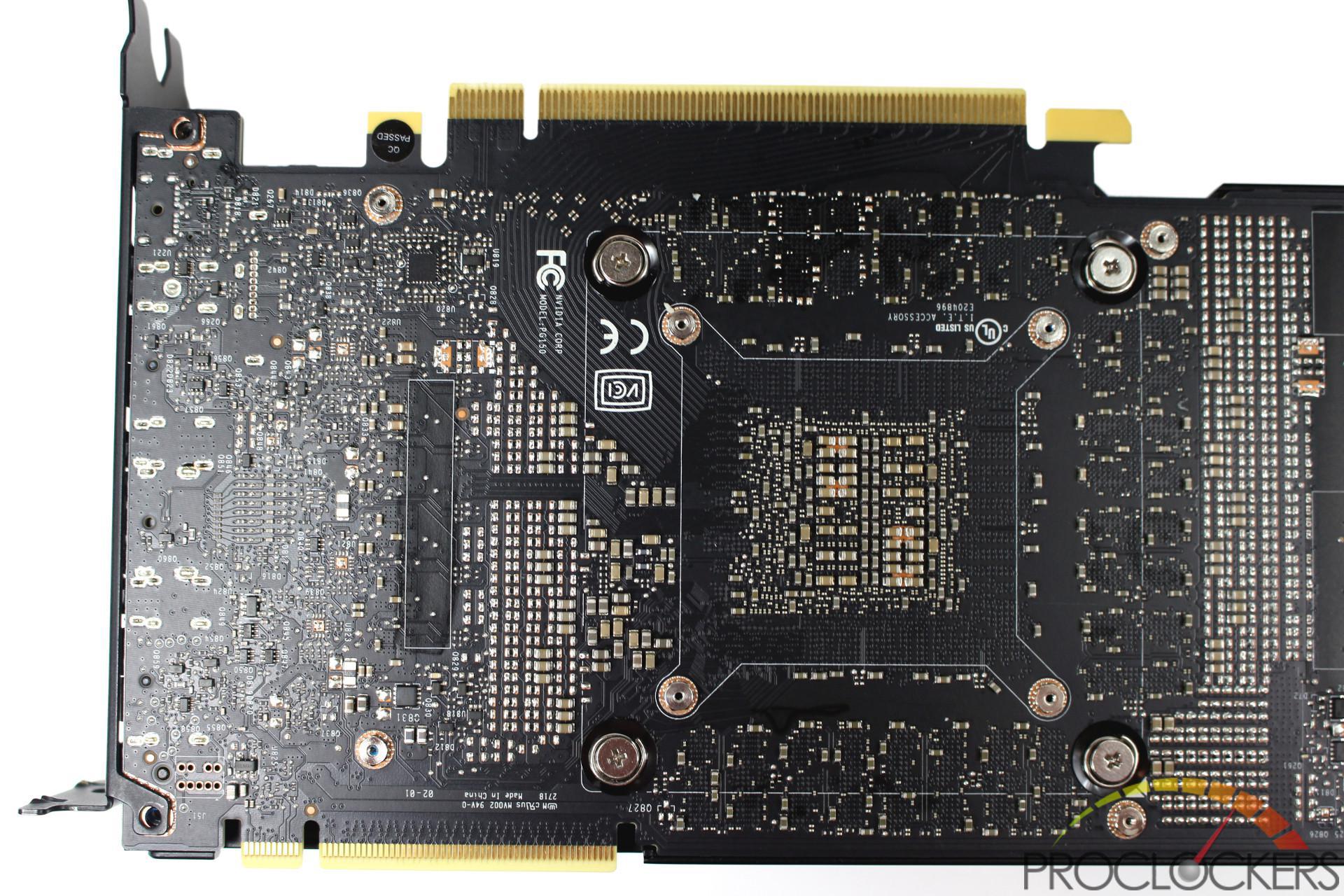
A minor VRM area sits forward of the GPU die and is also cooled by the backplate. The NV-Link connector is so much larger than the previous SLI connectors.
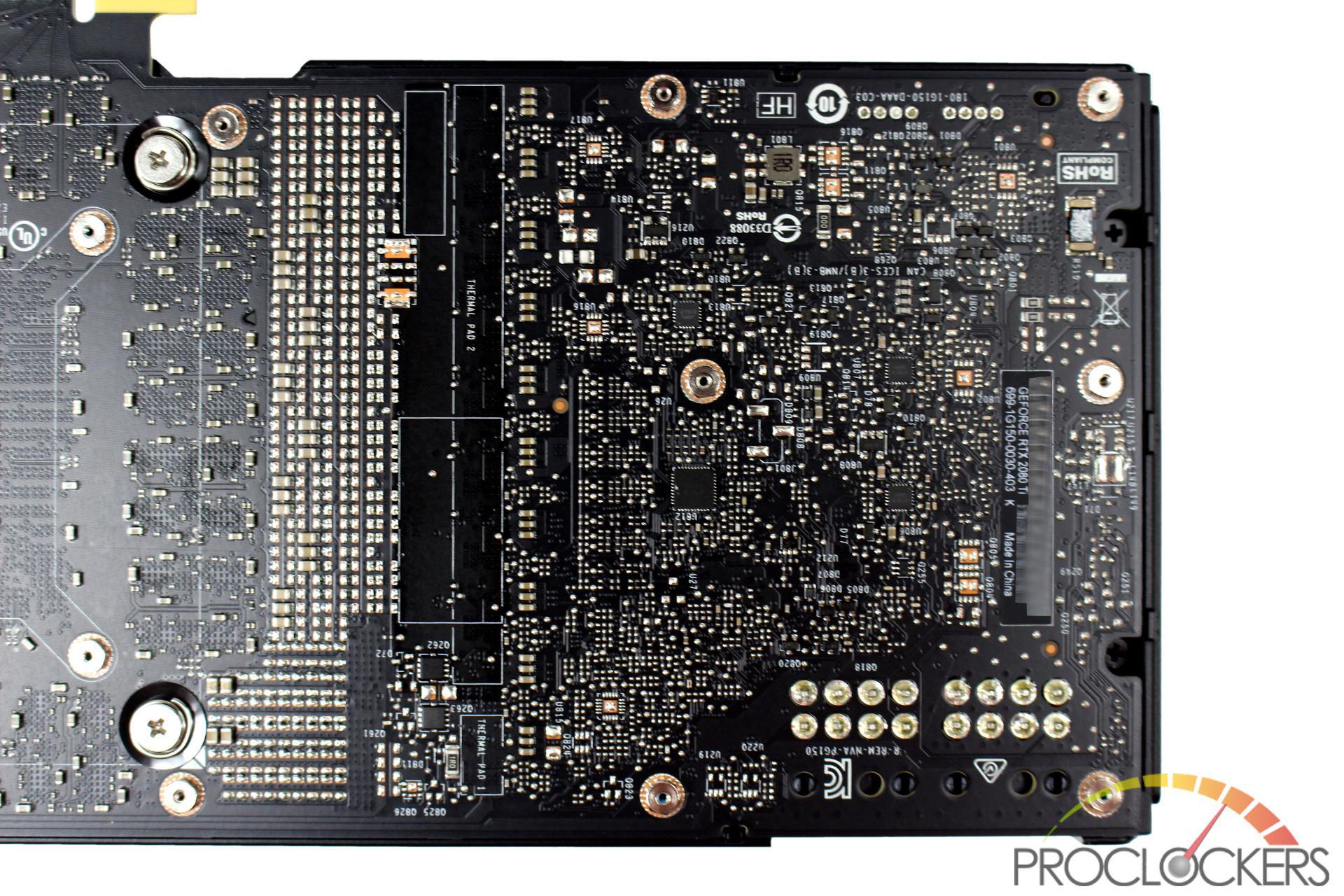
The rear of the card has a significant amount of components on the back of the PCB. Another serial number sticker is near the back of the card on the PCB itself.
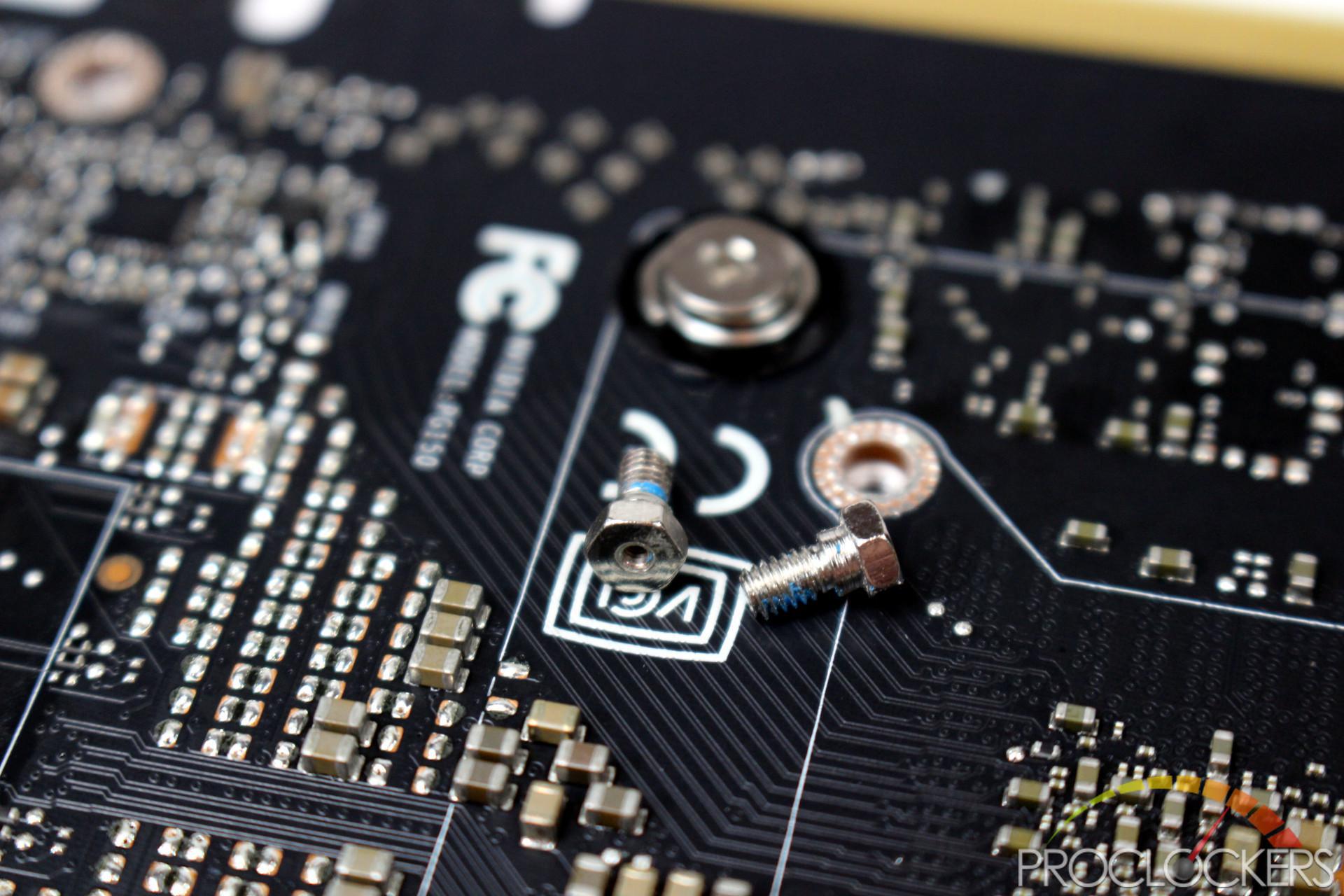
The vapor chamber heatsink is held to the board with the normal four spring-loaded screws around the GPU die as well as well as 14 of these small standoffs the back plate also uses to mount to.
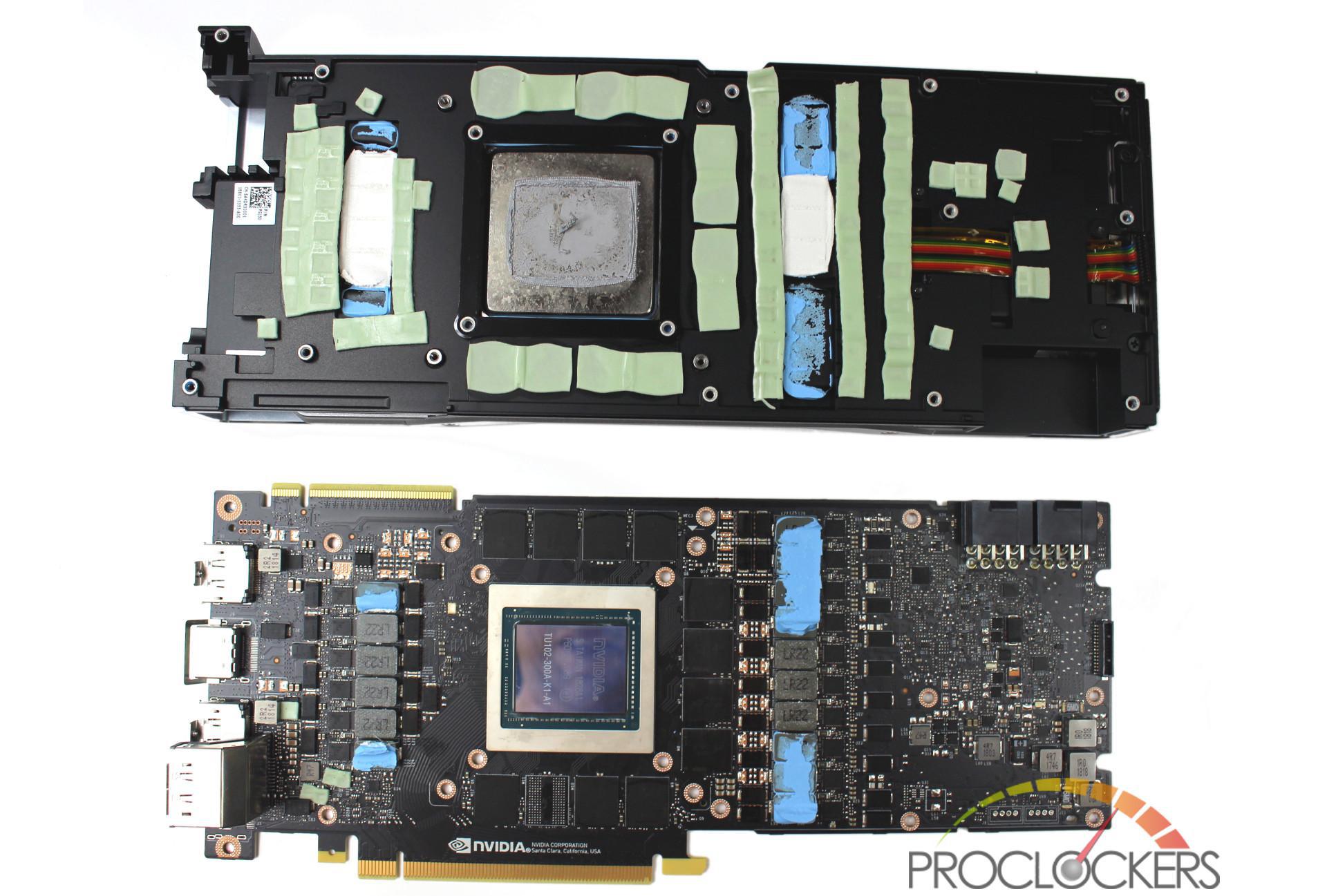
The cooler requires a bit of force to remove from the PCB due to the significant amount of thermal paste, pads and some blue thermal material that is somewhere between the two in consistency.
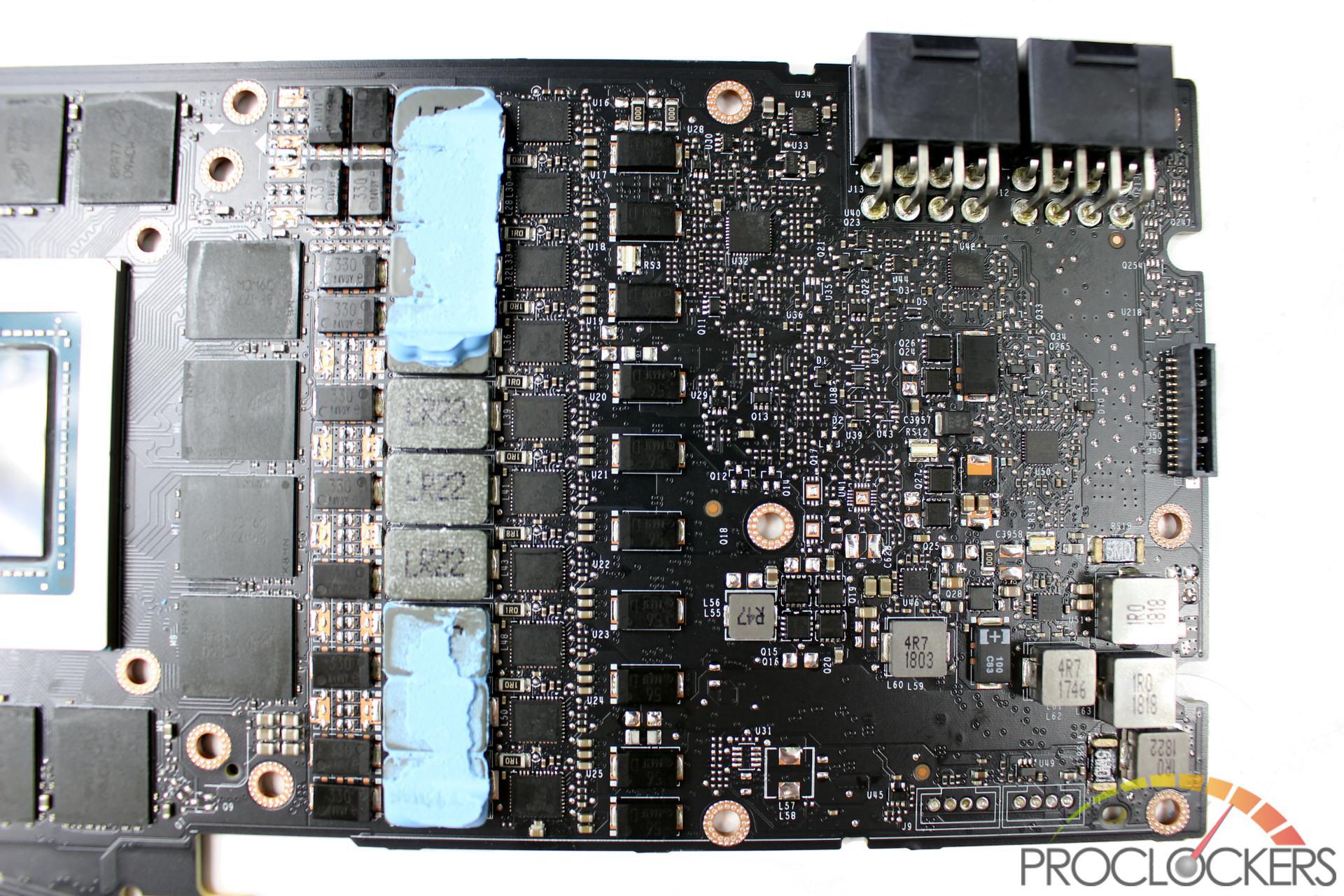
The RTX 2080Ti is fed with a new 10-phase VRM from twin 8-pin PCIe connectors. Fans and lighting are all handled with a single connector this time.
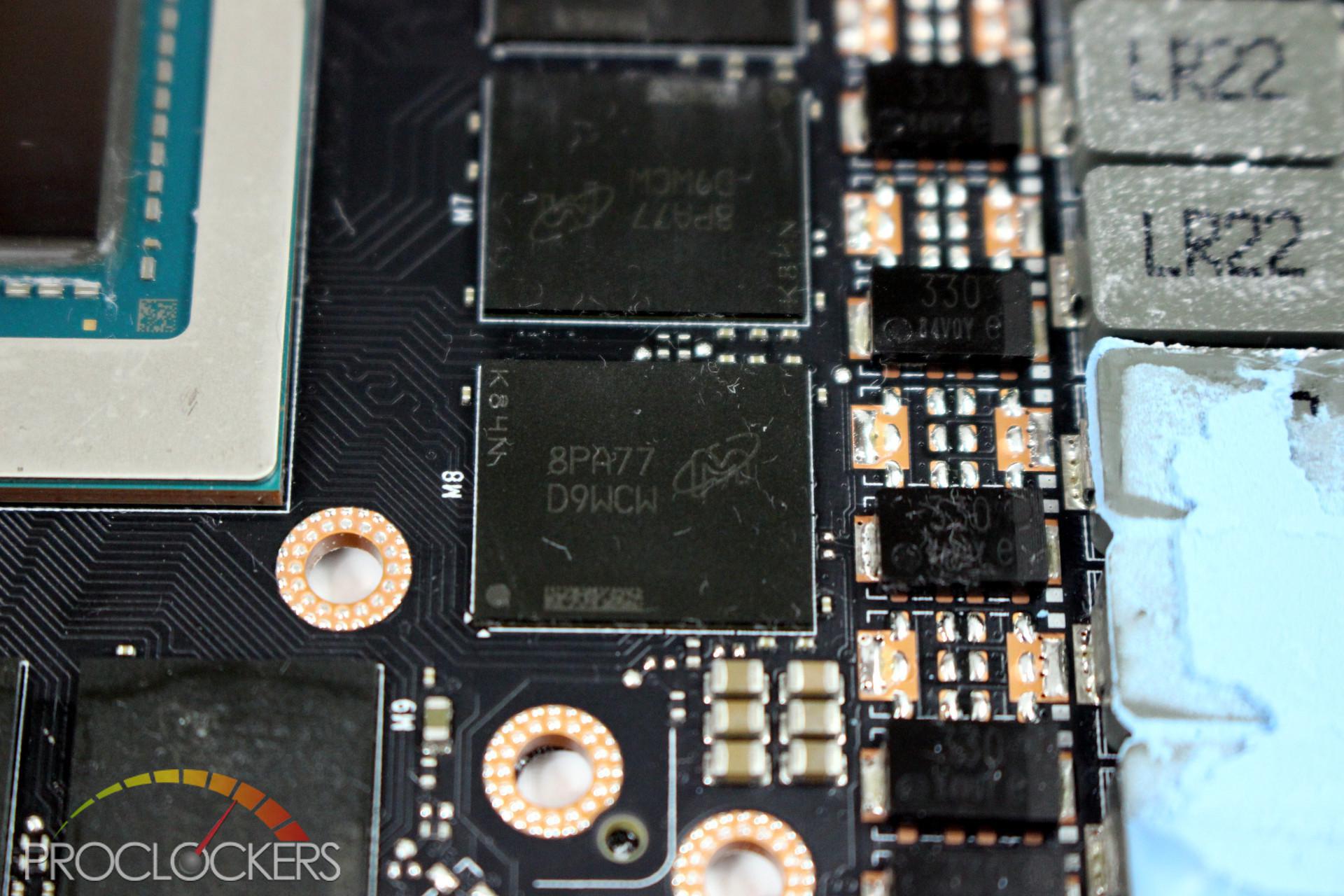
Eleven Micron GDDR6 packages surround the GPU die carrying 1GB of memory each. An empty position is very reminiscent of the GTX 1080Ti series as well.
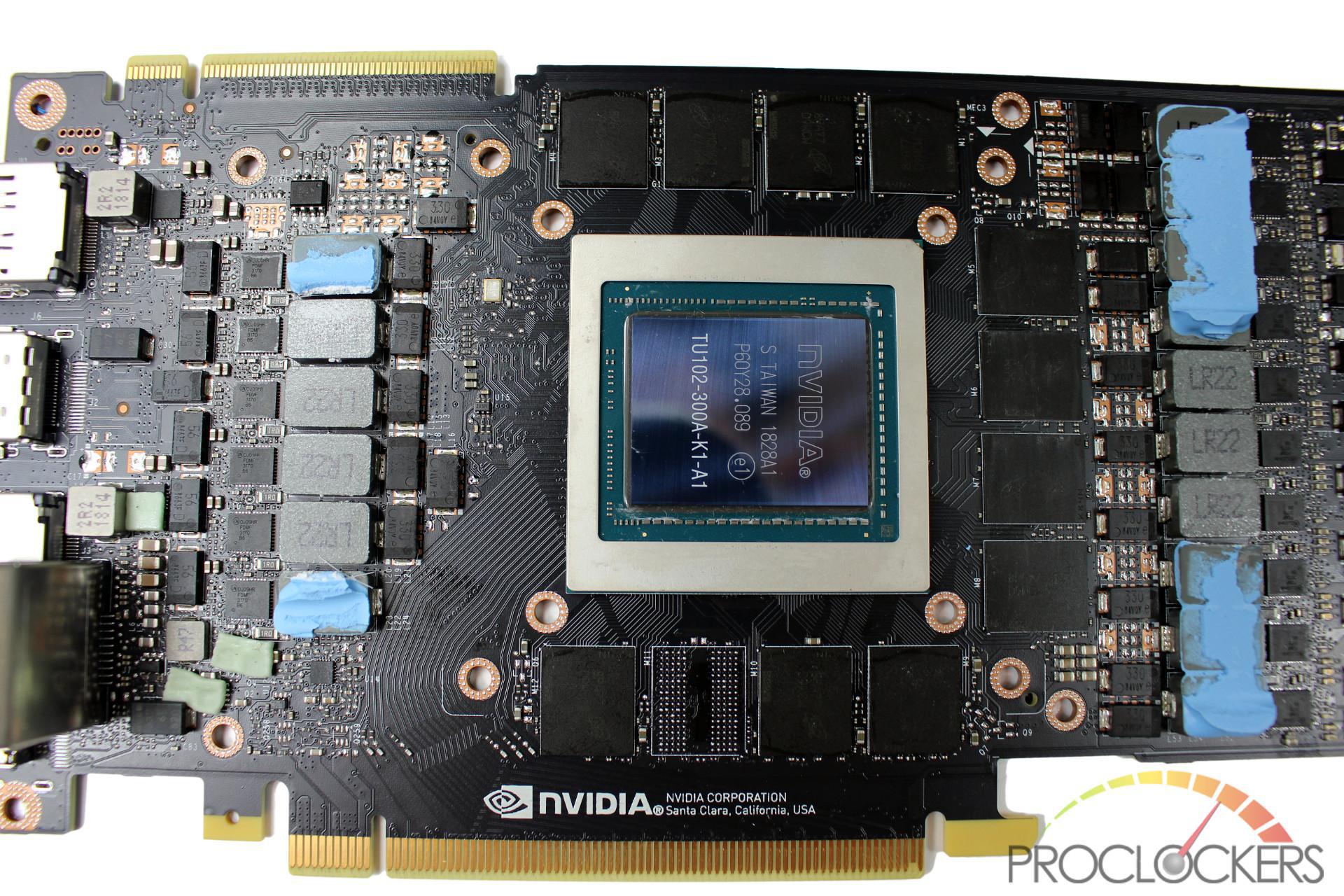
The Turing die is MASSIVE. 2018 is the year of massive dies and Nvidia certainly got their piece of the market with this beauty. Note the additional 6-phase VRM towards the front of the card.
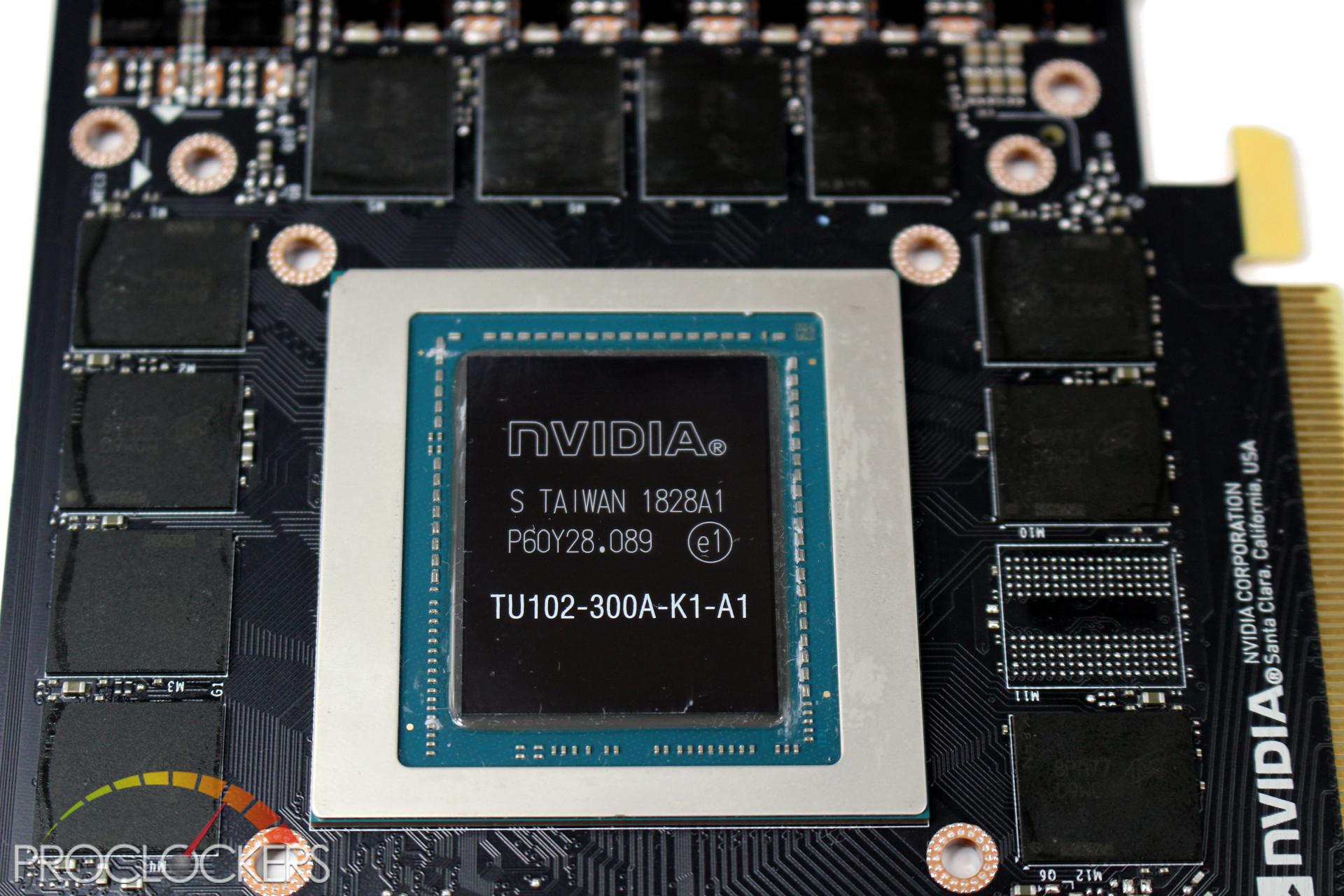
The obligatory Die-shot. Our Founders Edition RTX 2080Ti carries not only the TU102-300 designation but also a new ‘A’ in the part number. Nvidia is pre-screening dies this generation into two bins, the more capable dies carry the ‘A’ designation while the ones used on the stock, non-overclocked cards are minus this character.
System Configuration & Software
- CPU: Intel Core i7-8700K
- GPU: Nvidia GeForce RTX 2080TI Founders Edition
- Mobo: ASUS ROG Maximus X Apex
- Ram: 16GB G.Skill Trident Z RGB 3200MHz C16
- SSD: Toshiba OCZ RD400 512GB
- Chassis: Streacom Open BenchTable
- OS: Microsoft Windows 10 Professional
All testing was performed at stock settings with the exception of system memory that had its XMP profile enabled.
Nvidia’s software consists of the Nvidia Control Panel and GeForce Experience.
The additional tested software is comprised of only TechPowerUp’s GPUz. The new Nvidia Scanner isn’t available as a standalone but is provided to board partners for integration into their own utilities. A pre-launch copy of EVGA’s new X1 utility was provided for the purpose of this review.
Nvidia Control Panel
The NVIDIA® Control Panel is NVIDIA’s next-generation hardware control application that unlocks the award-winning features of NVIDIA drivers. The NVIDIA Control Panel was designed by NVIDIA’s dedicated user interface team to revolutionize software ease-of-use and ensure that set-up and configuration of your NVIDIA hardware have never been easier.
Featuring innovative multimedia, application, and display management, as well as gaming features, the NVIDIA Control Panel, ensures compatibility, stability, and reliability for all NVIDIA platforms. In addition, the NVIDIA Control Panel is architected for Microsoft® Windows Vista™ and will be fully integrated with the new software infrastructures of its next generation, visually oriented operating system.
Historically, NVIDIA’s Control Panel has contained a wealth of settings and adjustments for NVIDIA GPUs and MCPs. In similar fashion, the NVIDIA Control Panel now applies the same depth of control to the rest of the core components within the system. Without ever leaving Windows or entering the BIOS users can optimize and adjust nearly every system component to minimize noise, increase stability, and maximize performance.
Nvidia’s control panel covers almost everything you need to get the best experience from your Nvidia GPU. You have access to Nvidia features such as G-Sync and SLI, as well as more generic features such as setting resolution, refresh rate, and configuring multiple monitors.
GeForce Experience
Capture and share videos, screenshots, and live streams with friends. Keep your drivers up to date and optimize your game settings. GeForce Experience™ lets you do it all, making it the essential companion to your GeForce® graphics card.
Many of the features of GeForce Experience are only accessible once you sign in.
The first time you sign in, GeForce Experience wants to scan your installed game library and optimize graphical settings for optimal performance and quality based on your personal hardware.
You can see it had no problem finding the games used for benchmarking in our Steam library.
You can view settings for each game, and optimize them in one click if you wish.
Drivers can be updated from here as well.
Synthetic Testing & Performance
Futuremark 3DMark
3DMark includes everything you need to benchmark your PC and mobile devices in one app. Whether you’re gaming on a smartphone, tablet, notebook, or a desktop gaming PC, 3DMark includes a benchmark designed specifically for your hardware.
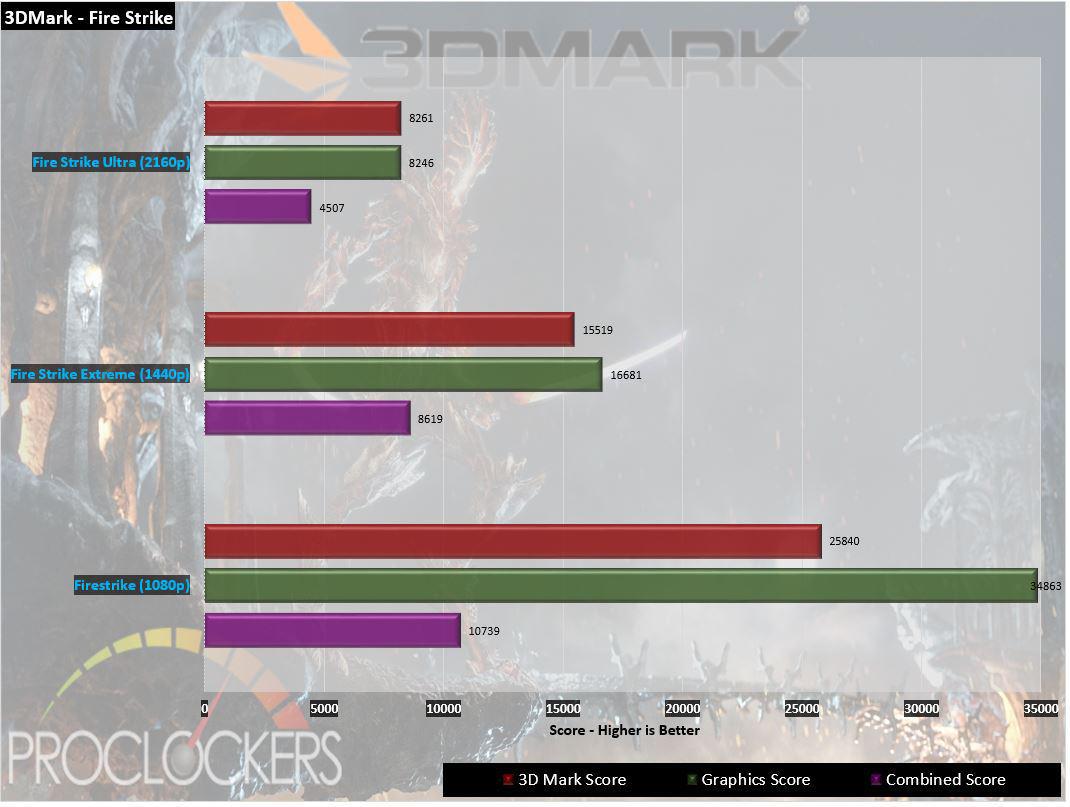
You do expect the flagship card of a new generation to lay waste to its predecessors, and the 2080Ti does not disappoint. We see about a 23% increase in score from a factory overclocked 1080Ti model to the 2080Ti in 1080p, and around 13% increase at 1440p (extreme) and 2160p (ultra).
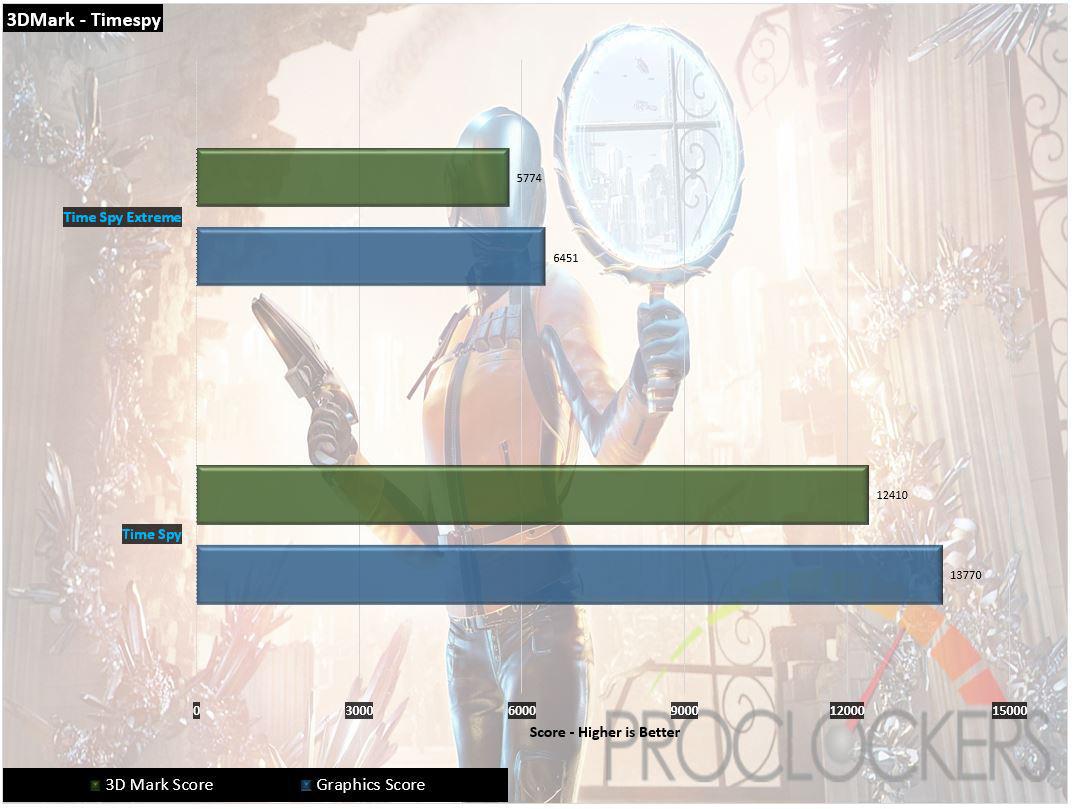
Timespy holds an even wider gap with about a 20% increase at the base 1440p level and a staggering 27% increase at the 4K ‘Extreme’ test.
Futuremark VRMark
The performance requirements for VR games are much higher than for typical PC games. So if you’re thinking about buying an HTC Vive or an Oculus Rift, wouldn’t you like to know that your PC is ready for VR?
VRMark includes three VR benchmark tests that run on your monitor, no headset required, or on a connected HMD. At the end of each test, you’ll see whether your PC is VR ready, and if not, how far it falls short.
Orange Room Test – The Orange Room benchmark shows the impressive level of detail that can be achieved on a PC that meets the recommended hardware requirements for the HTC Vive and Oculus Rift. If your PC passes this test, it’s ready for the two most popular VR systems available today.
Cyan Room Test – Cyan Room is a DirectX 12 benchmark. It features a large, complex scene and many eye-catching effects. Cyan Room shows how using an API with less overhead can help developers deliver impressive VR experiences even on modest PC systems.
Blue Room Test – The Blue Room is a much more demanding test. It’s ideal for benchmarking the latest graphics cards. With its massive 5K rendering resolution and spectacular volumetric lighting effects, the Blue Room sets the bar for future hardware generations.
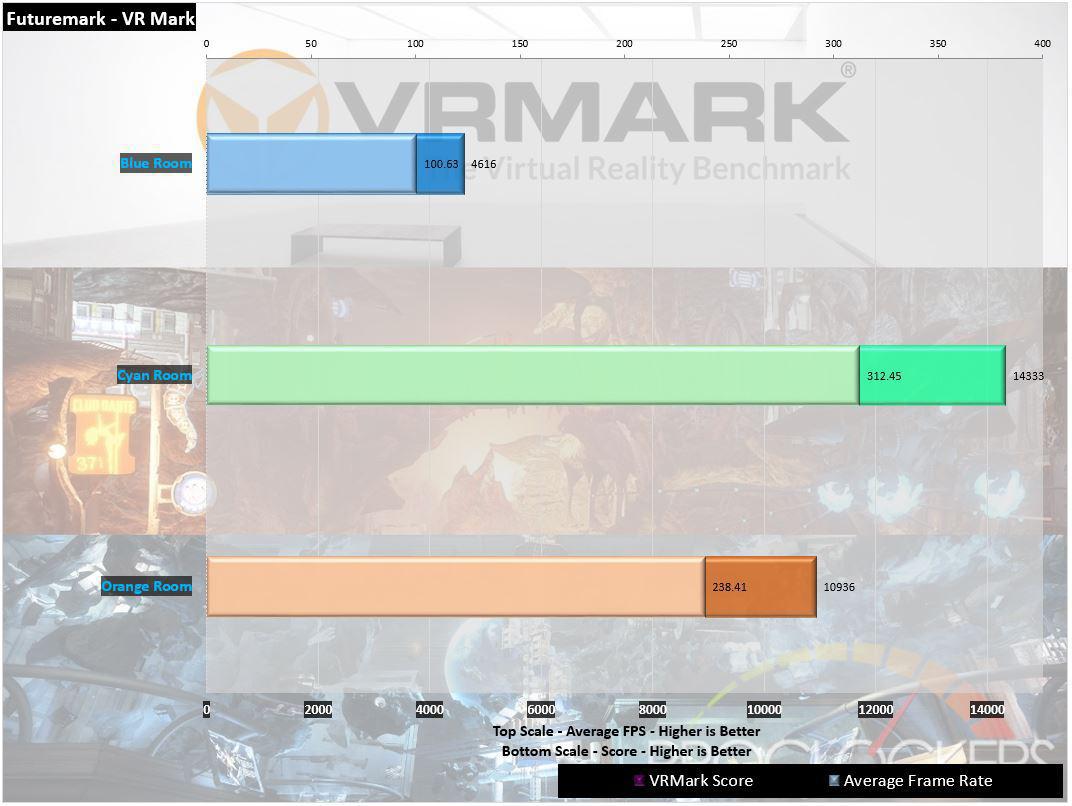
VR workloads are a breeze for the 2080Ti, as they should be given it is designed with VR in mind. We see a modest 10% increase at the low demand orange level, a staggering 75% increase at the cyan level where most high-end headsets fall, and a game-changing 43% increase at the extremely demanding blue level. This gets us over the 100 fps average, dangerously close to the 109FPS target rate.
Unigine Heaven
Heaven Benchmark is a GPU-intensive benchmark that hammers graphics cards to the limits. This powerful tool can be effectively used to determine the stability of a GPU under extremely stressful conditions, as well as check the cooling system’s potential for maximum heat output.
The benchmark immerses a user into a magical steampunk world of shiny brass, wood, and gears. Nested on flying islands, a tiny village with its cozy, sun-heated cobblestone streets, and a majestic dragon on the central square gives a true sense of adventure. An interactive experience with fly-by and walk-through modes allows for exploring all corners of this world powered by the cutting-edge UNIGINE Engine that leverages the most advanced capabilities of graphics APIs and turns this bench into a visual masterpiece.
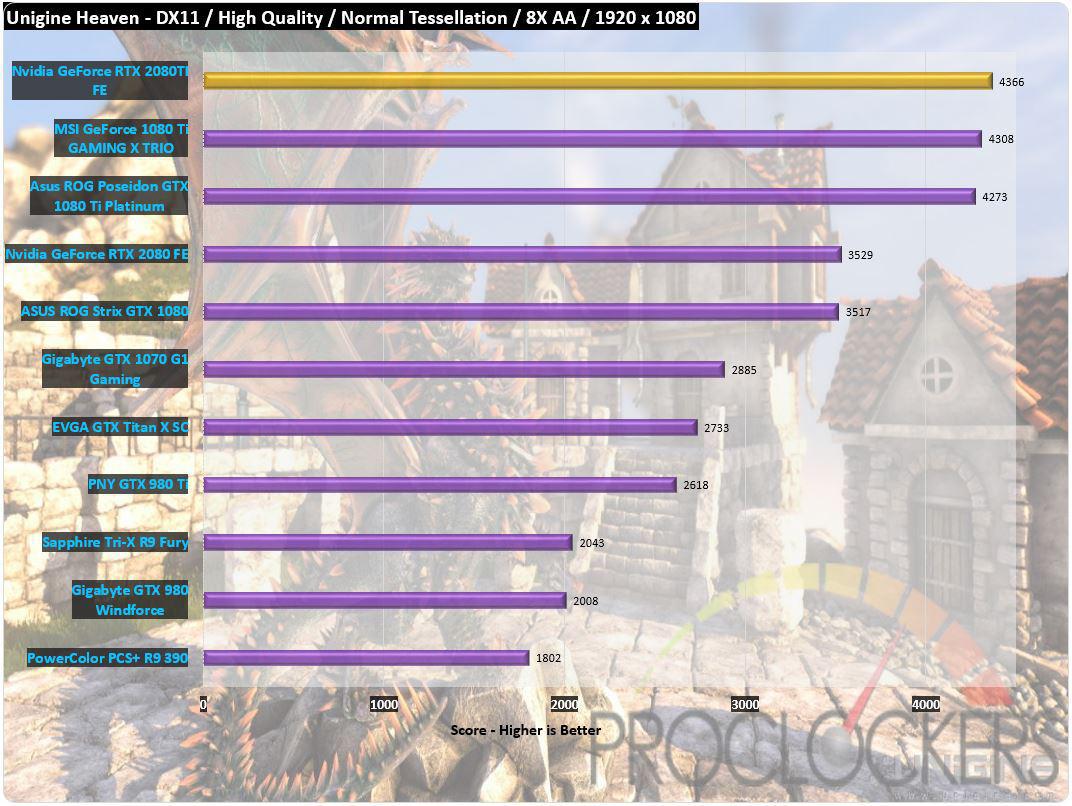
At a lower demand of mid-range settings and 1080p resolution, the 2080Ti really doesn’t gain much ground over the previous 1080Ti.
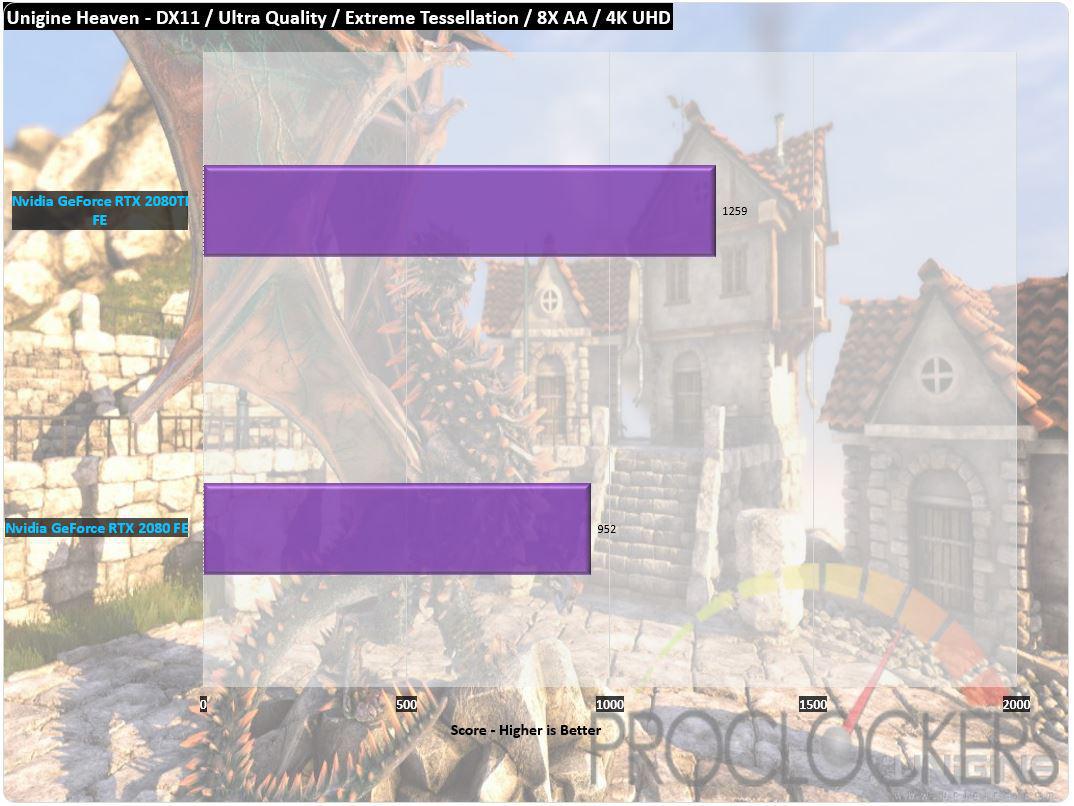
With the settings turned up, the gap widens considerably.
Unigine Superposition
Extreme performance and stability test for PC hardware: video card, power supply, cooling system. Check your rig in stock and overclocking modes with a real-life load! Also includes interactive experience in a beautiful, detailed environment.
A lone professor performs dangerous experiments in an abandoned classroom, day in and day out. Obsessed with inventions and discoveries beyond the wildest dreams, he strives to prove his ideas.
Once you come to this place in the early morning, you would not meet him there. The eerie thing is a loud bang from the laboratory heard a few moments ago. What was that? You have the only chance to cast some light upon this incident by going deeply into the matter of quantum theory: thorough visual inspection of professor’s records and instruments will help to lift the veil on the mystery.
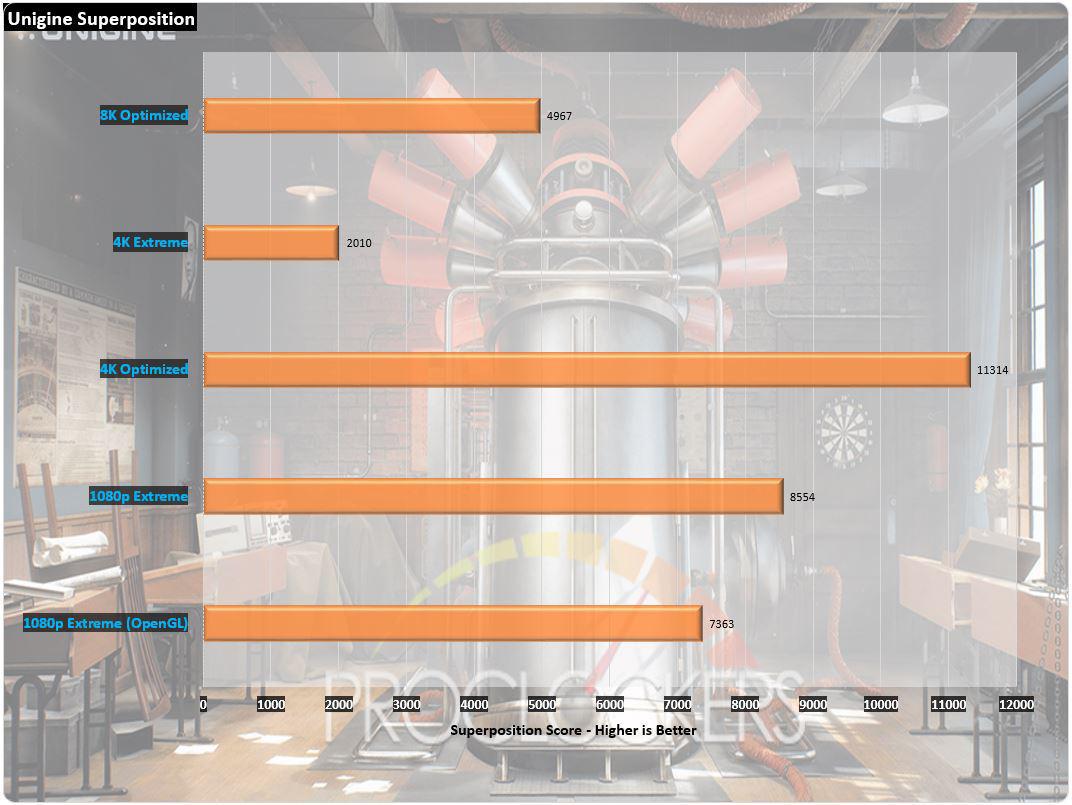
The 2080Ti Founders Edition glides through all of our standard tests with the best scores yet. We had to up the ante a bit and add in a 4K Extreme test with all settings maxed out at 4K UHD resolution. This just crushes most cards but the 2080Ti manages to a choppy but still moving 15FPS for a score of just over 2000.
Game Testing & Performance
Far Cry 5
Anything can happen. Everything will.
Welcome to Hope County, Montana, land of the free and the brave, but also home to a fanatical doomsday cult—known as The Project at Eden’s Gate—that is threatening the community’s freedom. Stand up to the cult’s leaders, Joseph Seed and the Heralds, as you spark the fires of resistance that will liberate the besieged community.
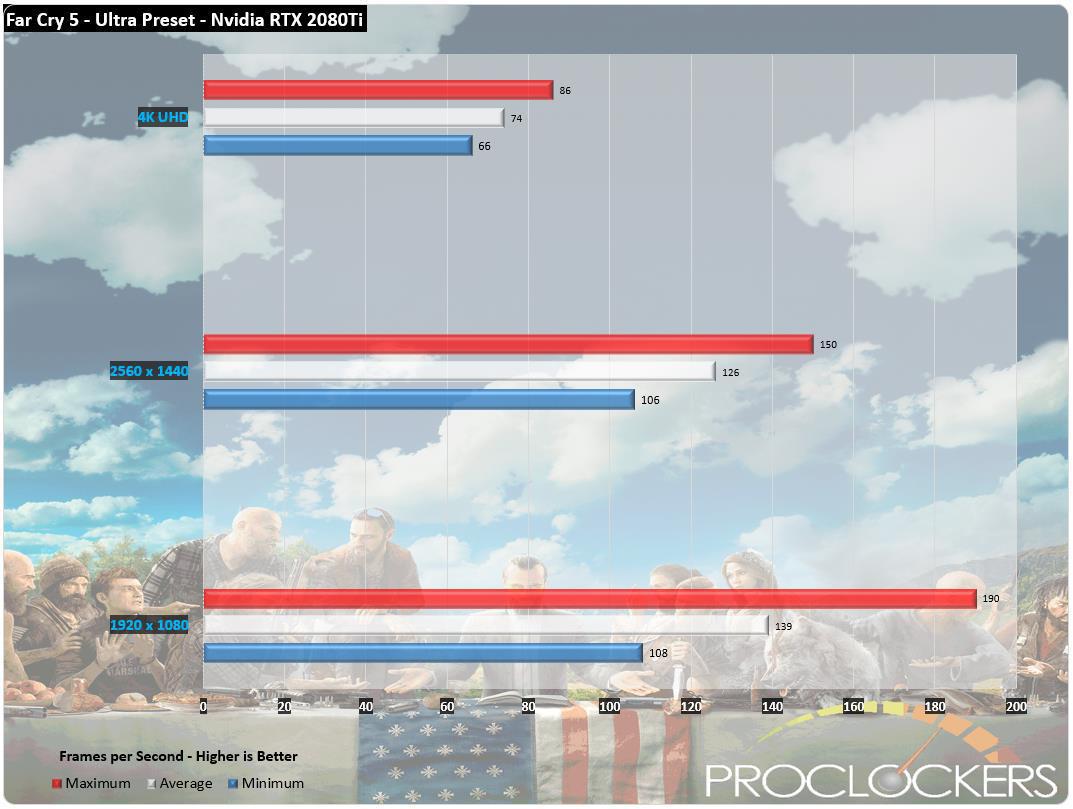
The Latest Installment of Far Cry is quite demanding. The Nvidia GeForce RTX 2080Ti Founders Edition takes 4k UHD in stride, even at the Ultra preset with a minimum frame rate well above the magic 60 FPS mark.
{C}{C}
Compared to the next step down, the RTX 2080Ti is a 40% increase in frame rate at 4K, but the RTX 2080 can handle its own as well.
Ashes of the Singularity
Planet by planet, a war is raging across the galaxy. The technological singularity has given humanity the power to expand further than they ever have before. Now, they compete with each other and their sentient artificial intelligence adversaries for control of newfound worlds.
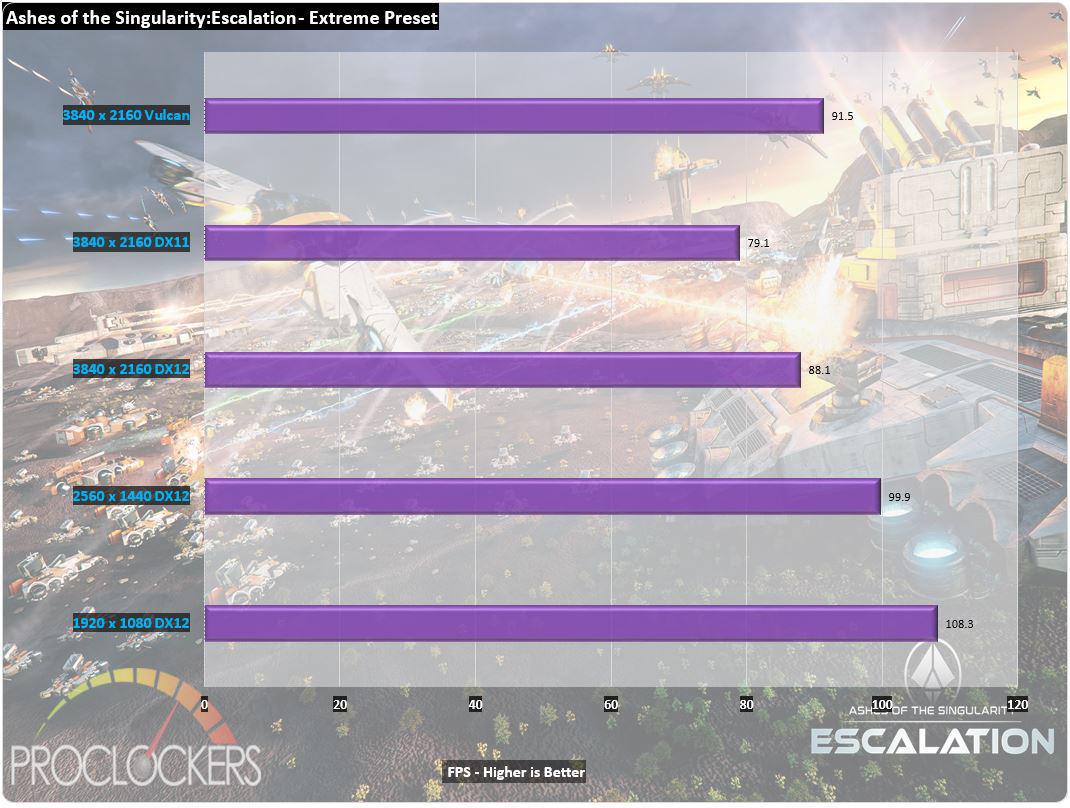
Our first real game test shows the raw power of the 2080Ti. All tests provide smooth and playable frame rates above 60FPS on average, and often on minimum as well. We added on 4K testing with all possible API’s and found that Vulcan provided the best performance, hitting 91.5FPS average on 4K.
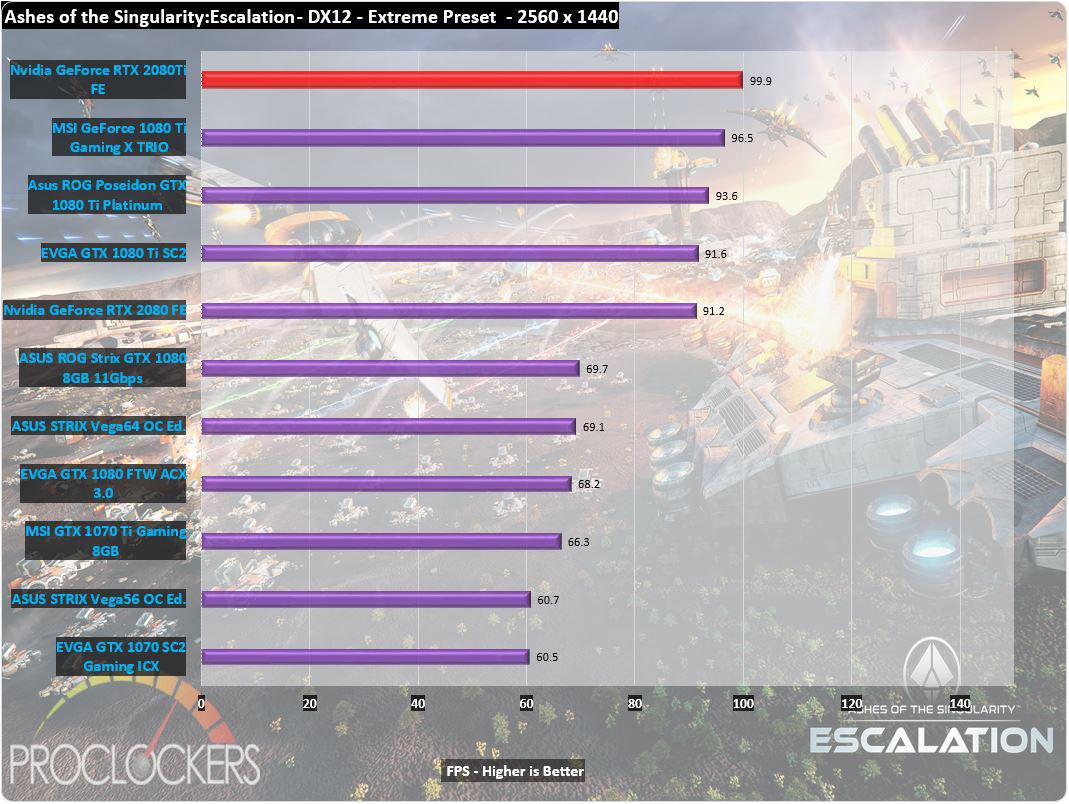
We seem to be hitting some level of a bottleneck somewhere, we only see a small spread on the frame rates of the top tier cards from the new RTX 2080, the last-gen, GTX 1080Ti and the new RTX 2080Ti. the RTX 2080Ti does hold the top spot, but it’s only by a few FPS.
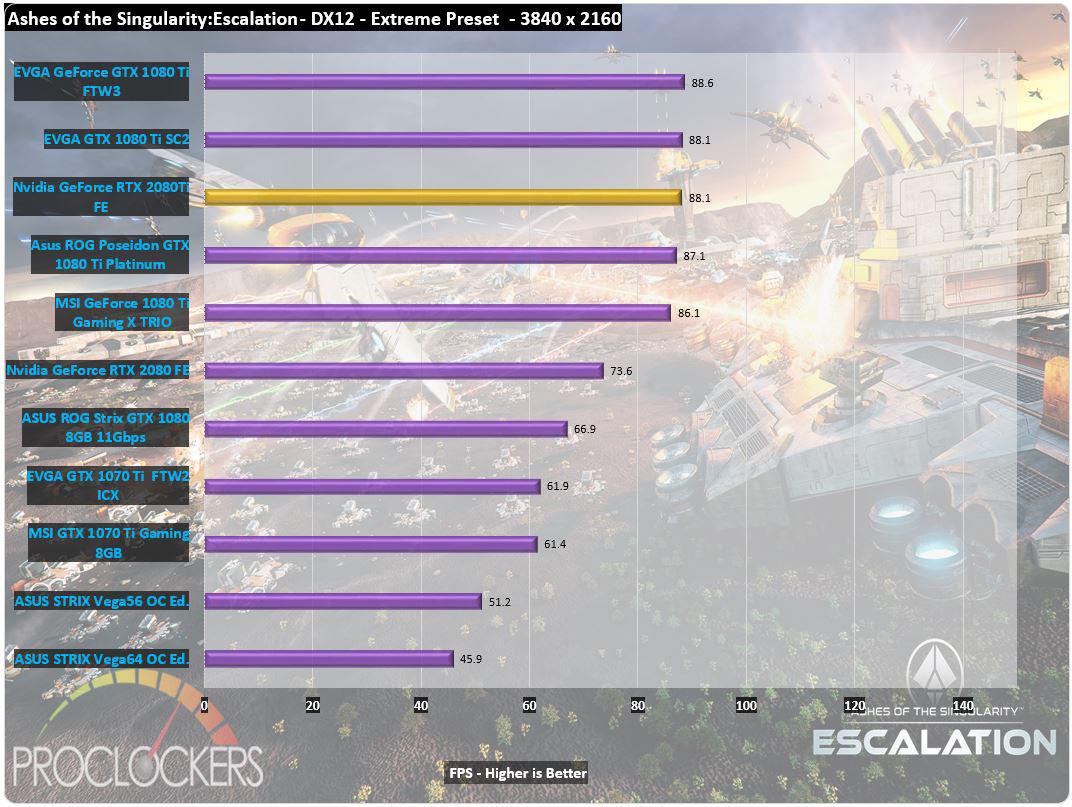
The performance gap is just as small at 4k UHD resolution with all of the top cards fighting over a fraction of an FPS.
Dues Ex: Mankind Divided
The year is 2029, and mechanically augmented humans have now been deemed outcasts, living a life of complete and total segregation from the rest of society.
Now an experienced covert operative, Adam Jensen is forced to operate in a world that has grown to despise his kind. Armed with a new arsenal of state-of-the-art weapons and augmentations, he must choose the right approach, along with who to trust, in order to unravel a vast worldwide conspiracy.
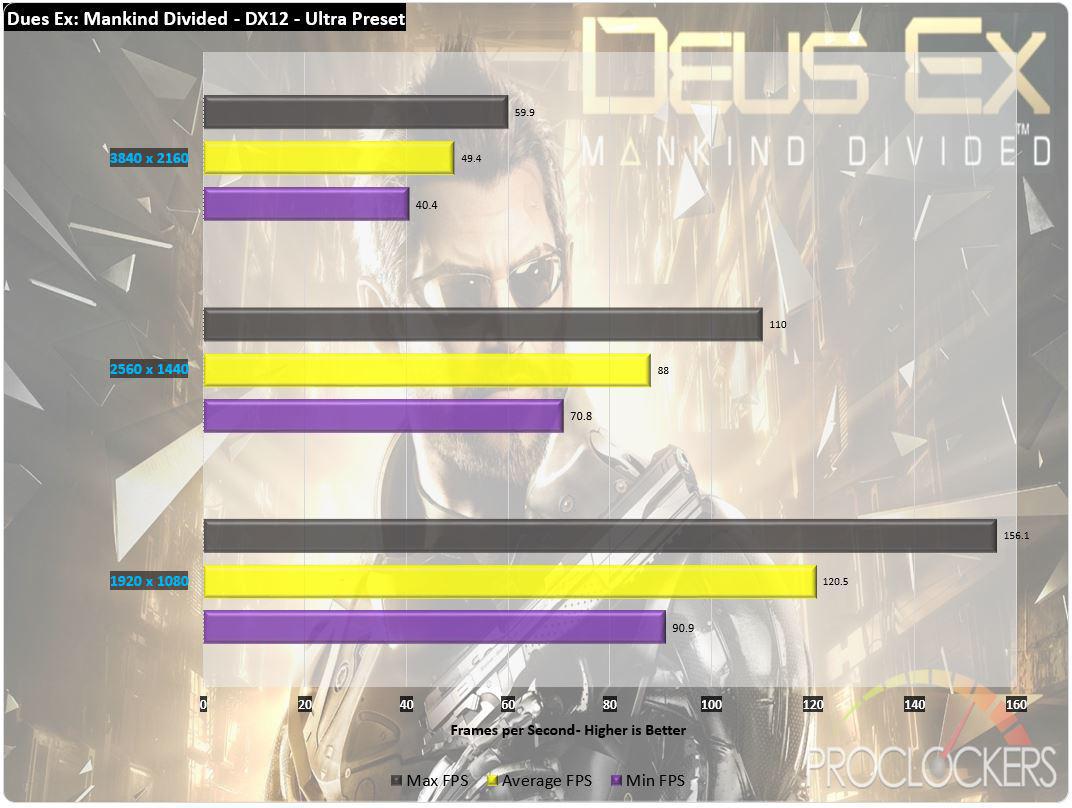
Fully maxed out, Dues Ex Mankind Divided can be quite brutal. We see an average of almost 50FPS in 4K with the lower resolutions never even dropping below 70 FPS.
Middle-Earth: Shadow of War
In the epic sequel to the award-winning Middle-earth: Shadow of Mordor, go behind enemy lines to forge an army, conquer Fortresses and dominate Mordor from within. Experience how the award-winning Nemesis System creates unique personal stories with every enemy and follower, and confront the full power of the Dark Lord Sauron and his Ringwraiths in this epic new story of Middle-earth.
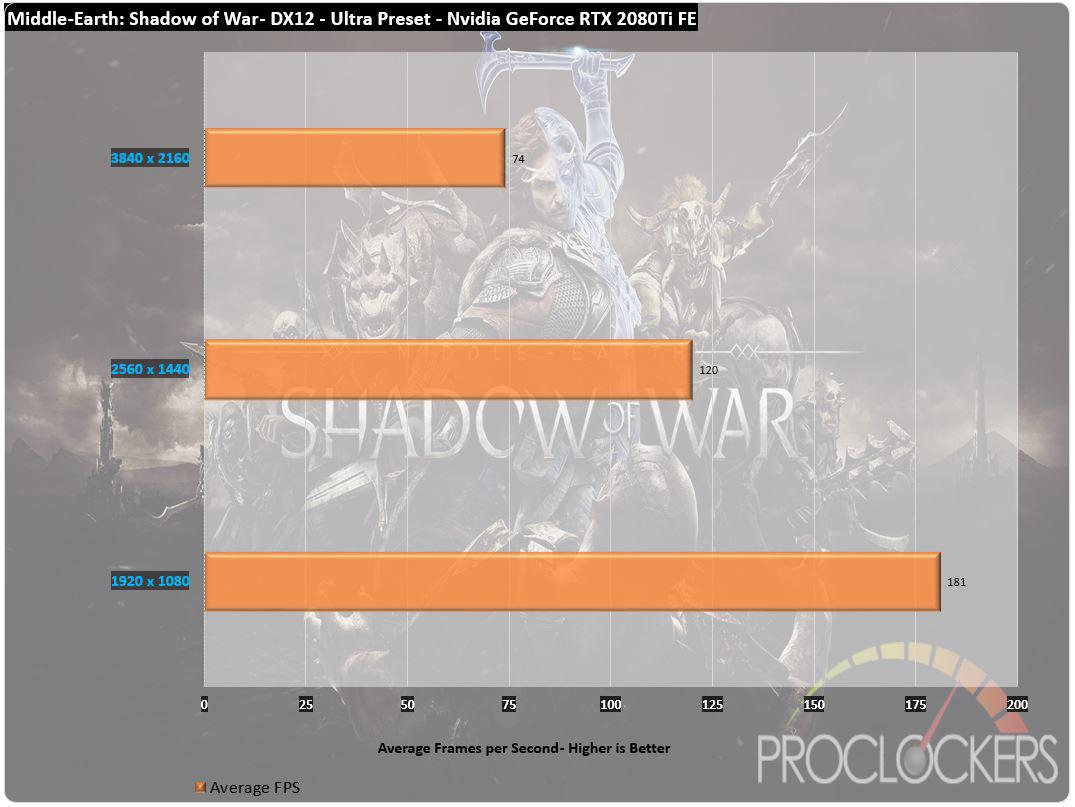
Middle-Earth: Shadow of War can be demanding at the Ultra preset level of detail but the RTX 2080Ti FE manages 74FPS average at 4K and is more than comfortable at lower resolutions.
Rise of the Tomb Raider
Rise of the Tomb Raider is an action-adventure video game developed by Crystal Dynamics and published by Square Enix. It is the sequel to the 2013 video game Tomb Raider, a reboot of the Tomb Raider franchise. It was released on Xbox One and Xbox 360 in November 2015 and for Microsoft Windows in January 2016. It is set to release for PlayStation 4 in the second half of 2016.
Rise of the Tomb Raider was officially announced in June 2014. The game’s storyline follows Lara Croft as she ventures into Siberia in search of the legendary city of Kitezh, whilst battling a paramilitary organization that intends on beating her to the city’s promise of immortality. Presented from a third-person perspective, the game primarily focuses on survival and combat, while the player may also explore its landscape and various optional tombs. Camilla Luddington returns to voice and performs her role as Lara.
Upon release, Rise of the Tomb Raider received positive reviews, with critics praising its graphics, gameplay, and characterization. It was the best-selling Xbox One game during Christmas week and had sold over one million copies by the end of 2015. Additional content was also released, including a new story campaign, a new gameplay mode, as well as new outfits and weapons for Lara.
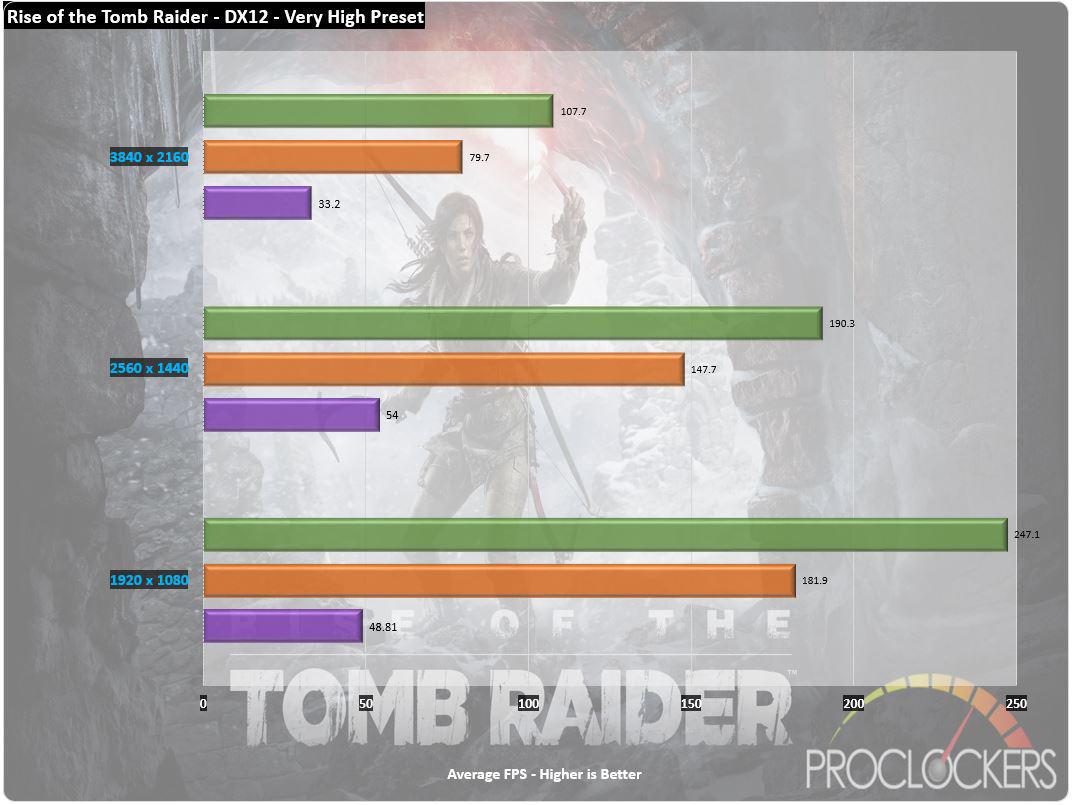
Rise of the Tomb Raider is now almost 3 years old but still is a demanding masterpiece graphically. The RTX 2080Ti holds performance at an average of nearly 80 FPS at 4K UHD maxed out.
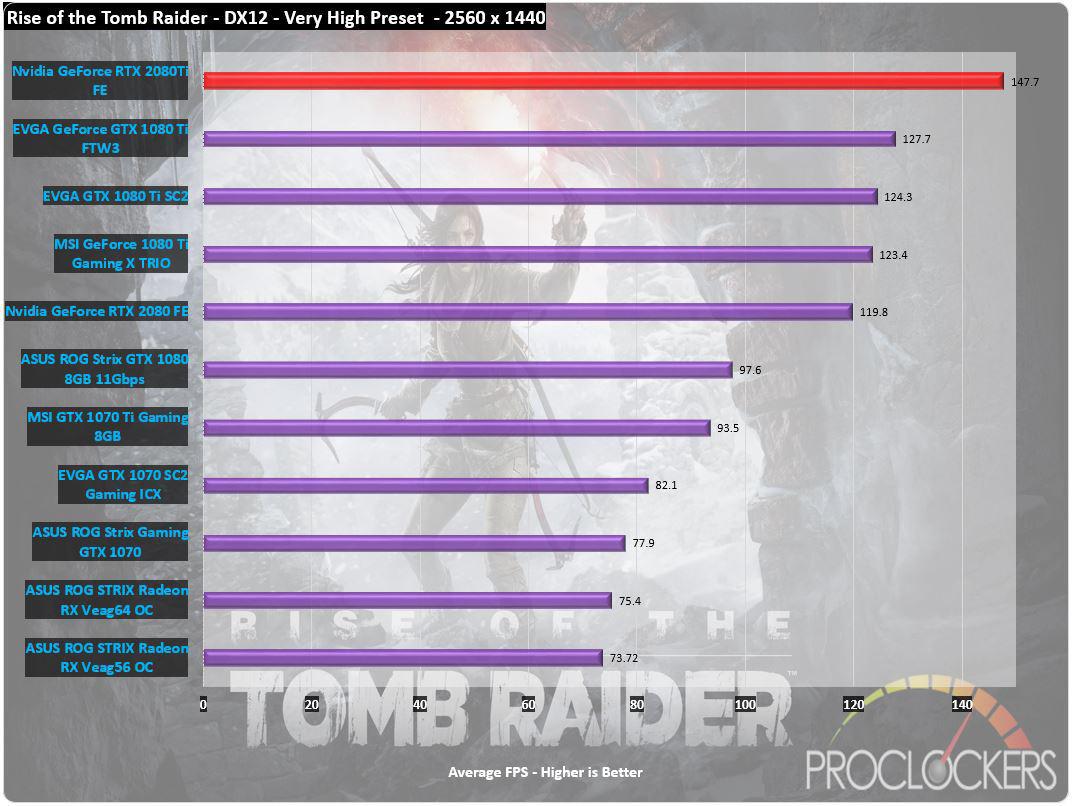
Compared directly to previous generation cards, the RTX 2080Ti holds a significant lead over the previous 1080Ti, nearly 16% faster than the previous leader at 2560 x 1440 resolution.
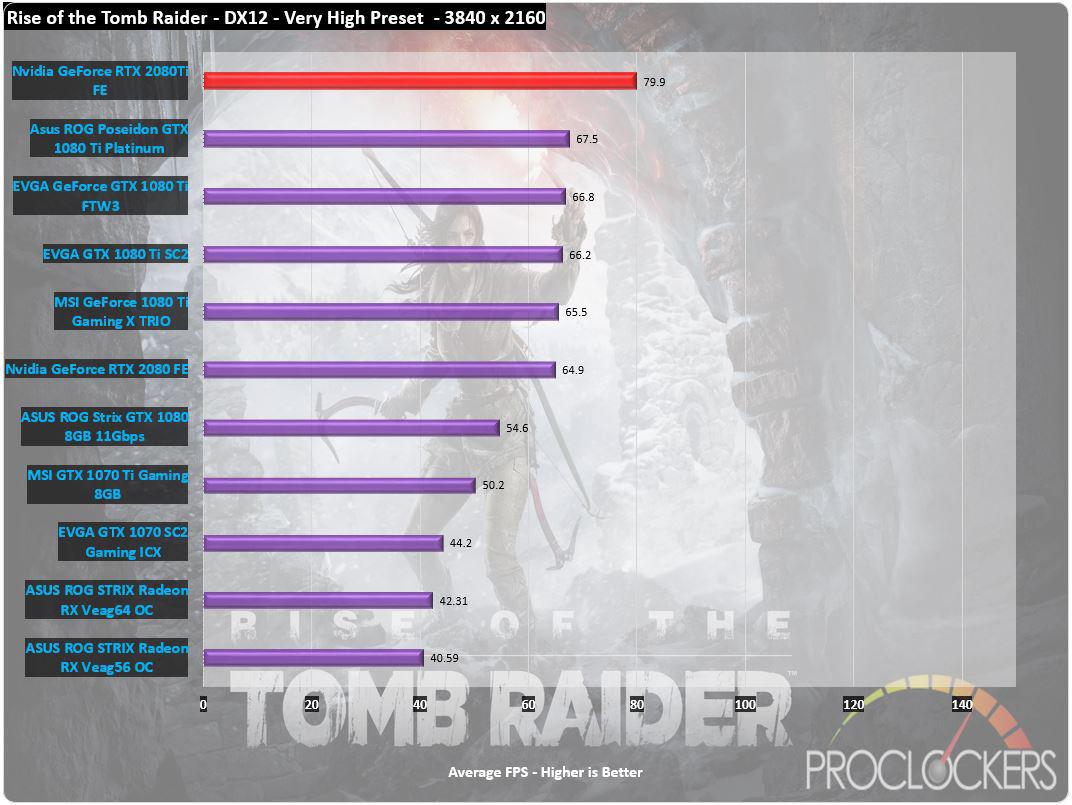
At 4K UHD, the gap widens to over 18% between the RTX 2080Ti and the GTX 1080Ti.
Shadow of the Tomb Raider
Experience Lara Croft’s defining moment as she becomes the Tomb Raider. In Shadow of the Tomb Raider, Lara must master a deadly jungle, overcome terrifying tombs, and persevere through her darkest hour. As she races to save the world from a Maya apocalypse, Lara will ultimately be forged into the Tomb Raider she is destined to be.
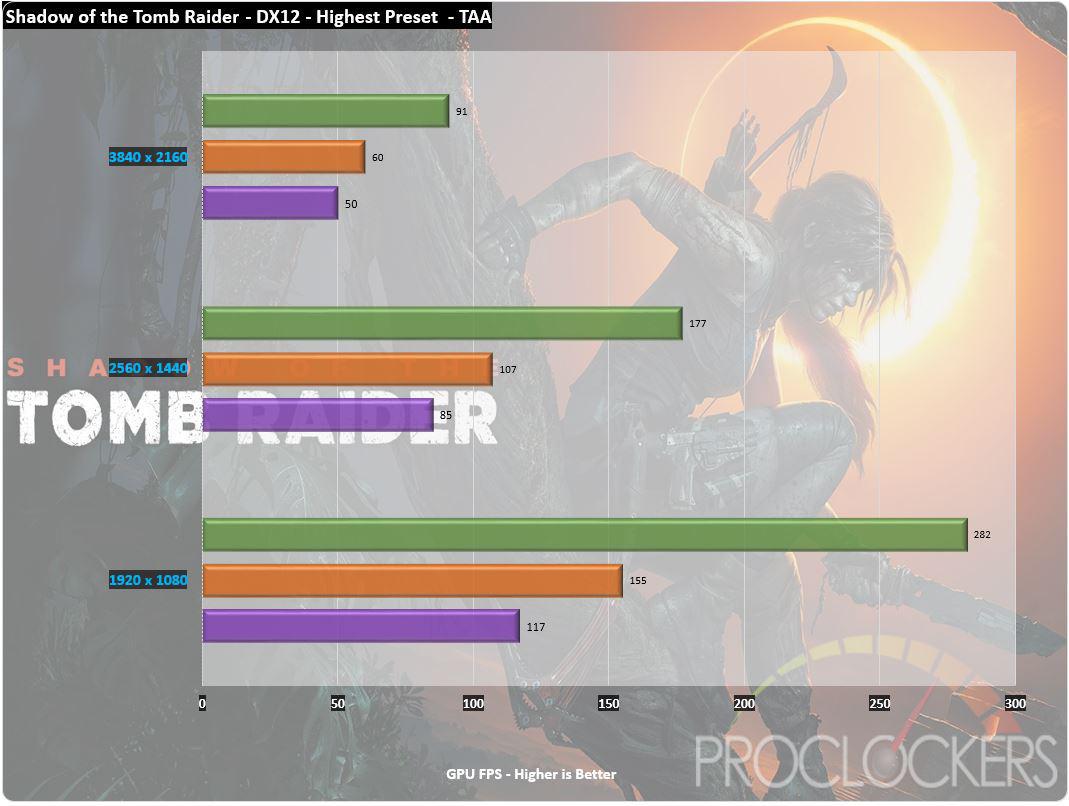
Shadow of the Tomb Raider is the latest installment in the Laura Croft Universe and promises to be a visual masterpiece. The RTX 2080Ti has no problem playing at the highest preset with great frame-rates, even at 4K UHD resolution.
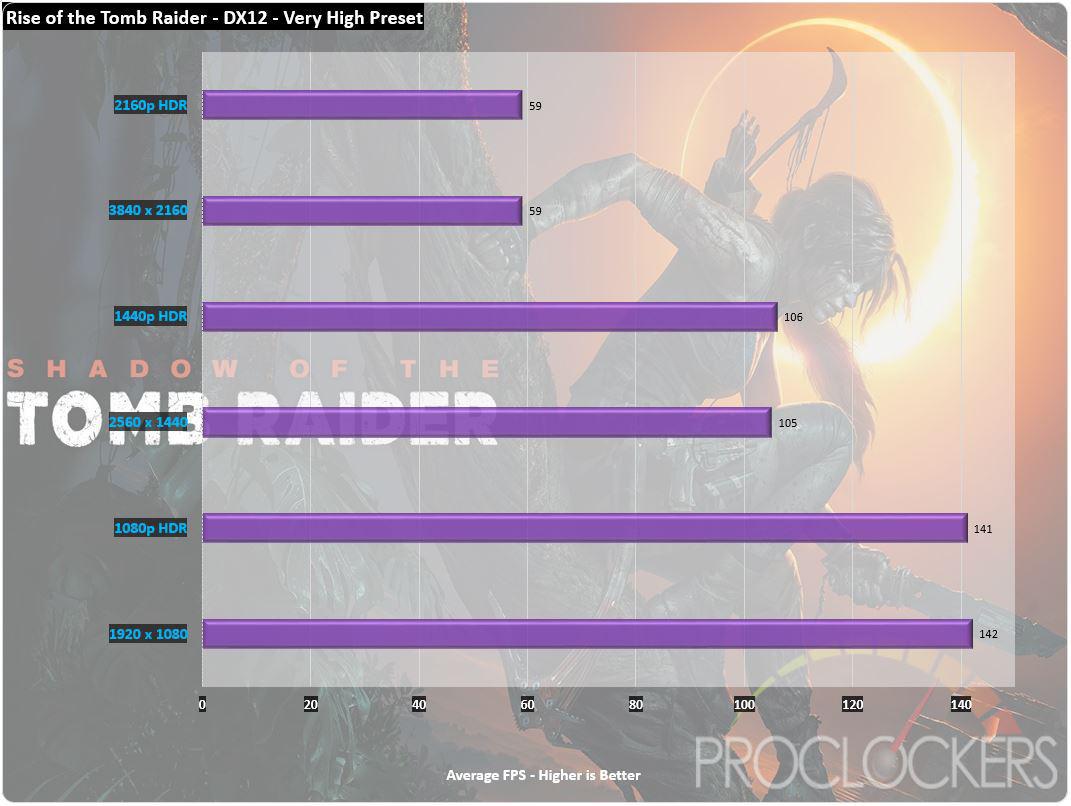
We wanted to test High-Dynamic Range to see what sort of impact it makes, but the frame rates fall within the margin of error for SDR rendering as well.
Grand Theft Auto: V
“When a young street hustler, a retired bank robber, and a terrifying psychopath find themselves entangled with some of the most frightening and deranged elements of the criminal underworld, the U.S. government and the entertainment industry, they must pull off a series of dangerous heists to survive in a ruthless city in which they can trust nobody, least of all each other.
Grand Theft Auto V for PC offers players the option to explore the award-winning world of Los Santos and Blaine County in resolutions of up to 4k and beyond, as well as the chance to experience the game running at 60 frames per second.”
Grand Theft Auto: V is the oldest game in our benchmark suite but still proves to be a heavy load on high settings and resolutions. The game offers players a huge range of PC-specific customization options, including over 25 separate configurable settings for texture quality, shaders, tessellation, anti-aliasing and more. It has the highest recommended system requirements in our game benchmark suite.
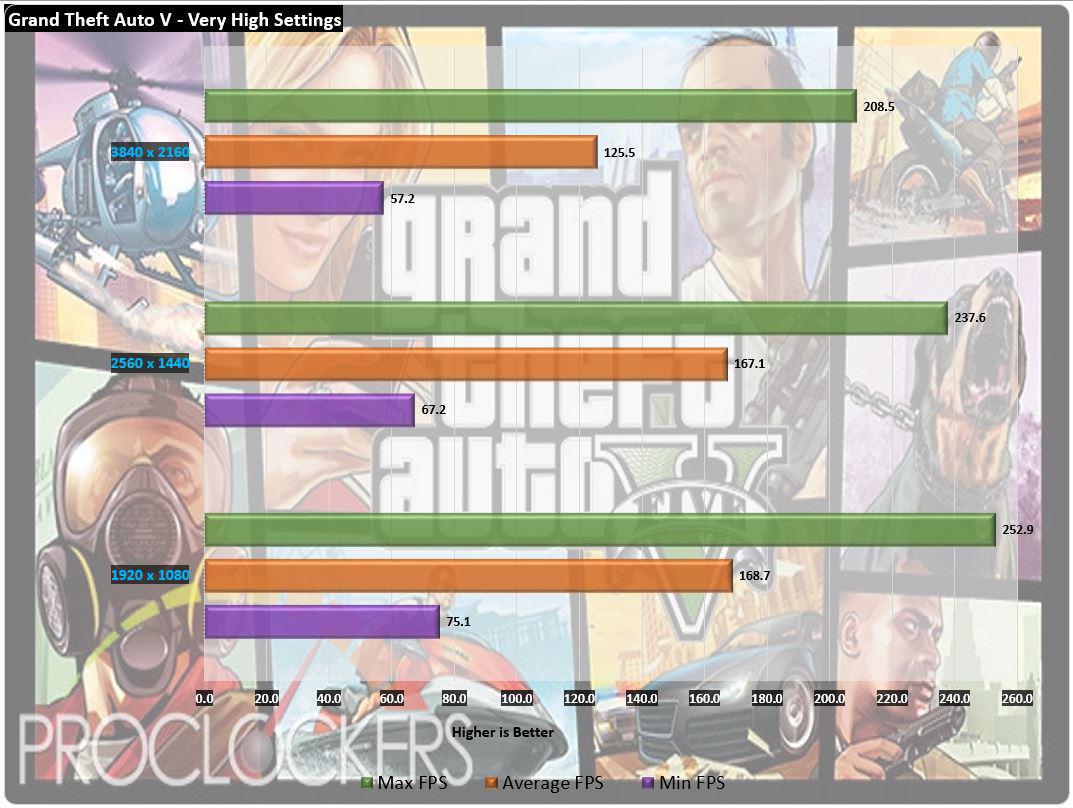
Even at more than 5 years old, GTA: V can be quite demanding but even with very heavy settings, the RTX 2080Ti can handle 4K quite easily.
Tom Clancy’s The Division
We live in a complex world. The more advanced it gets, the more vulnerable it becomes. We’ve created a house of cards: remove just one, and everything falls apart.
Black Friday – a devastating pandemic sweeps through New York City, and one by one, basic services fail. In only days, without food or water, society collapses into chaos. The Division, an autonomous unit of tactical agents, is activated. Leading seemingly ordinary lives among us, these agents are trained to operate independently in order to save society.
When society falls, we rise.
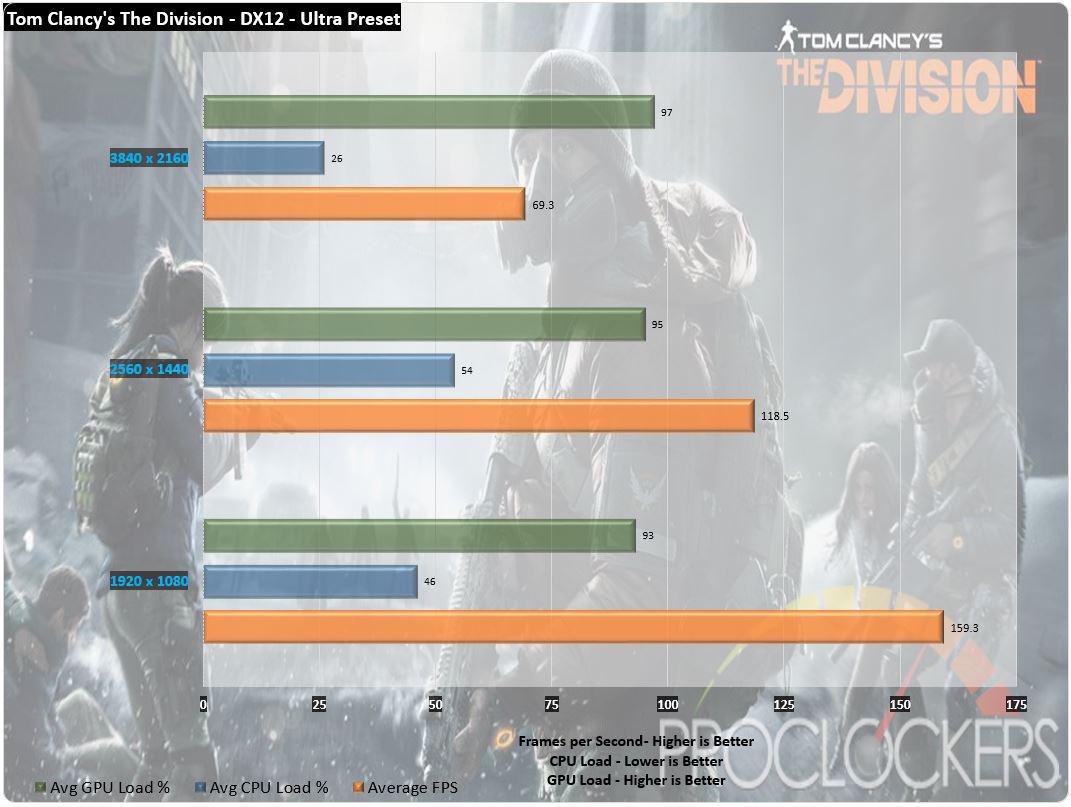
The orange bar is Average Frame-rate at each given resolution, and we see that even at 4K at the Ultra preset, the RTX 2080Ti can handle it and pulls nearly 70 FPS.
Metro: Last Light
“It Is the Year 2034. Beneath the ruins of post-apocalyptic Moscow, in the tunnels of the Metro, the remnants of mankind are besieged by deadly threats from outside – and within. Mutants stalk the catacombs beneath the desolate surface, and hunt amidst the poisoned skies above.”
Developed by 4A Games and published by Deepsilver, Metro: Last Light uses the 4A game engine. At its highest settings, the 4A game engine is capable of bringing all but the most extreme gaming systems to their knees.
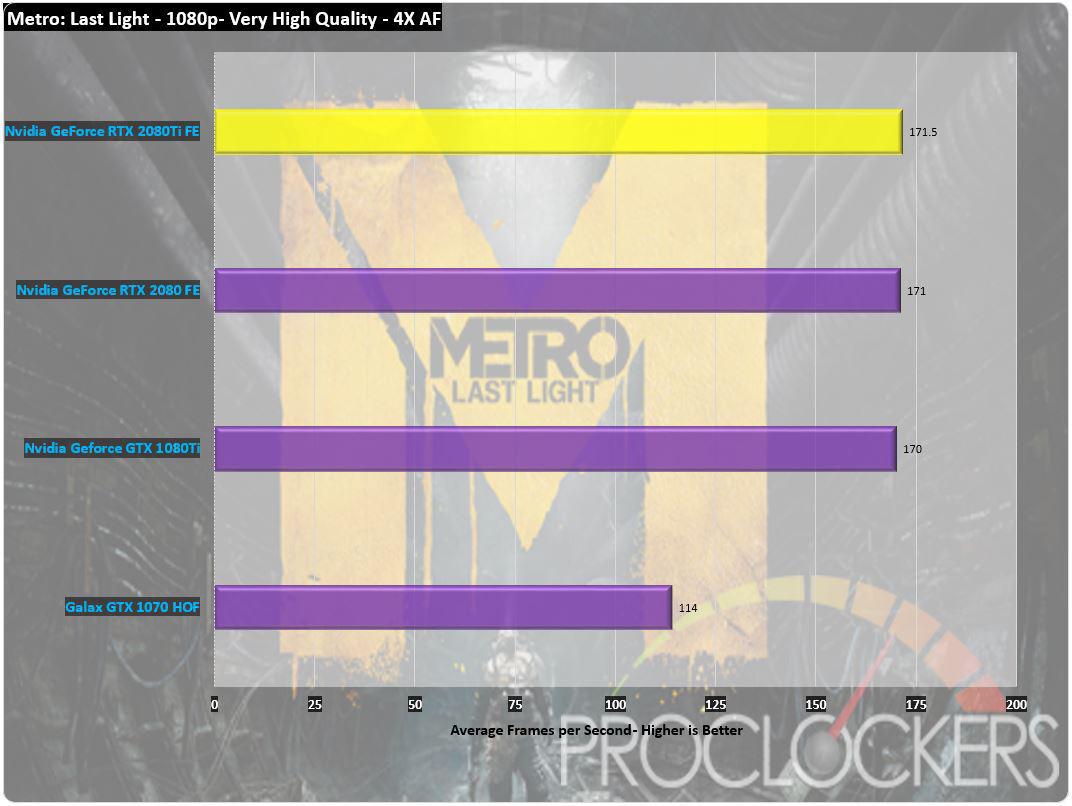
It appears we are hitting the limits of our CPU to feed such powerful cards at 1080P and mid-range settings.
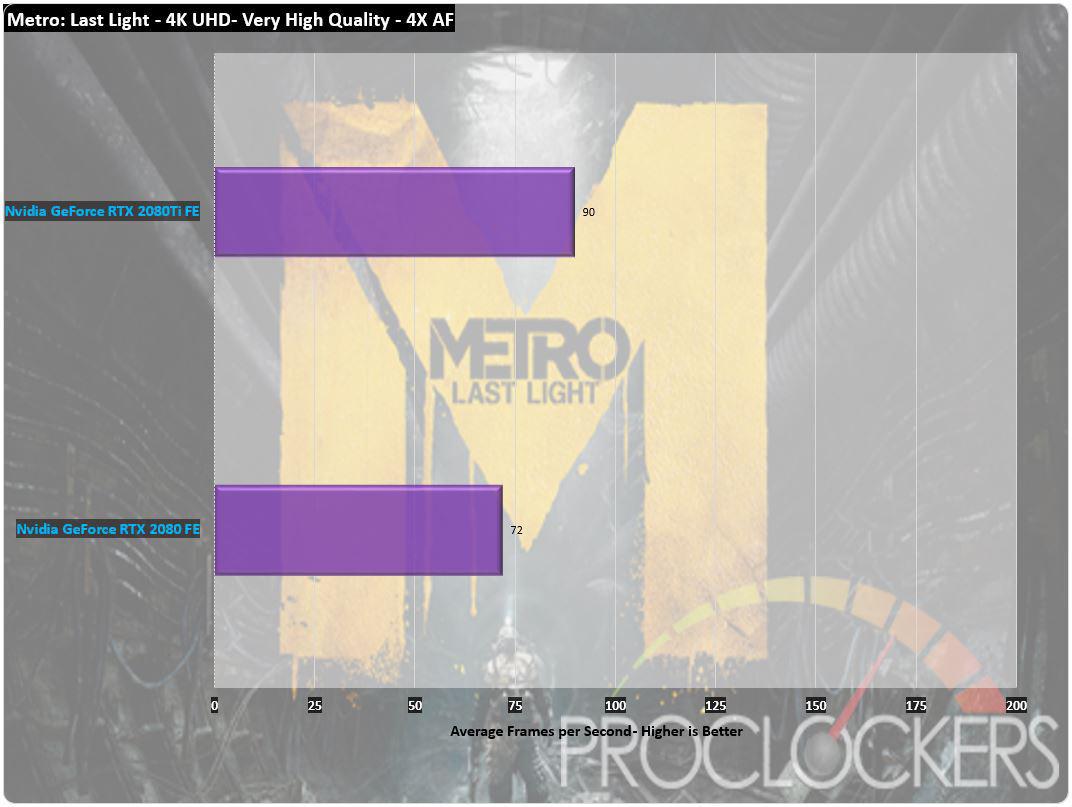
When the settings and resolution are turned up, the RTX cards can handle the heat.
DLSS & Mesh Shading
DLSS Anti-Aliasing Demos – Final Fantasy XV Windows Benchmark Tool & Epic Infiltrator Demo
Turing’s 114 TFLOP Tensor Cores can be used to improve performance through a feature known as Deep Learning Super Sampling (DLSS). DLSS leverages a deep neural network to extract multidimensional features of the rendered scene and intelligently combine details from multiple frames to construct a high-quality final image. This allows Turing GPUs to use half the samples for rendering and use AI to fill in information to create the final image. The result is a clear, crisp image with similar quality as traditional rendering (which typically relies on TAA in most of today’s latest games), but with higher performance. DLSS is an easy integration for developers, so far developers have announced that 25 games will have DLSS support.
Final Fantasy XV – Windows Edition Benchmark Tool
Enroute to wed his fiancée Luna on a road trip with his best friends, Prince Noctis is advised by news reports that his homeland has been invaded and taken over under the false pretense of a peace treaty – and that he, his loved one and his father King Regis, have been slain at the hands of the enemy.
To gather the strength needed to uncover the truth and reclaim his homeland, Noctis and his loyal companions must overcome a series of challenges in a spectacular open world – that is filled with larger-than-life creatures, amazing wonders, diverse cultures, and treacherous foes.
We can see here a clear advantage to Deep-Learning Super-Sampling AA taking over the demanding task of Anti-Aliasing.
The RTX 2080Ti gains 35.5% while the RTX 2080 sees a gain of 35.7% using DLSS over TAA, all with no noticeable difference in quality. The performance increase IS quite visible though.
Epic Infiltrator Demo
Epic Games created the Infiltrator demos as a high-end demonstration of Unreal Engine 4’s rendering and cinematic capabilities. The project is full of a high-quality content representative of a triple-A game scene. Along with the high-quality assets are many high-end, performance-heavy cinematic effects like depth-of-field, bloom and motion blur. Infiltrator was originally built to run at 1080p and with all its settings turned on, even on today’s most powerful GPU is taxing at 4K resolution. By integrating NVIDIA DLSS technology, which leverages the Tensor Cores of GeForce RTX, Infiltrator now runs at 4K resolution with consistently high frame rates without stutters or other distractions.
The Epic Infiltrator sees a remarkable 35% increase in average frame rates using DLSS over TAA on the GeForce RTX 2080Ti FE. The RTX 2080 FE nets a whopping 41% increase in average frame rate.
GeForce RTX Asteroids Demo
Mesh Shading Demo
Mesh shading advances NVIDIA’s geometry processing architecture by offering a new shader model for the vertex, tessellation, and geometry shading stages of the graphics pipeline, supporting more flexible and efficient approaches for computation of geometry. This more flexible model makes it possible, for example, to support an order of magnitude more objects per scene, by moving the key performance bottleneck of object list processing off of the CPU and into highly parallel GPU mesh shading programs. Mesh shading also enables new algorithms for advanced geometric synthesis and object LOD management.
In this demo, we are demonstrating how Mesh Shading can dramatically improve performance and image quality when rendering a substantial number of objects (over 200,000) at the same time. With Mesh Shading, Dynamic LOD management runs autonomously on the GPU. Traditional rendering would require the CPU to be heavily involved with LOD management, creating a large bottleneck in the rendering pipeline. The Asteroids demo allows for adjustment of seven static levels of detail (0-6) in addition to dynamically controlled LOD, for comparisons of overall image quality and performance. Higher static LOD numbers indicate an increased level of detail. Tessellation is not used at all in the demo, all objects, including the millions of particles, are taking advantage of Mesh shading. Advanced culling also greatly improves rendering efficiency. With Mesh Shading, culling takes place hierarchically; first, entire asteroids are checked for visibility; then, parts of the asteroid are checked; and finally, individual triangles are culled. Before the Turing architecture, the GPU was culling one triangle at a time which caused a massive workload on both the GPU and CPU.
This demo really isn’t meant to be a benchmark as much as a feature demo. We used FRAPS to capture a 30-second flight through the asteroid field directly forward of the demo starting position.
Look at that, well over a quarter of a million asteroids to deal with providing nearly 3 TRILLION triangles, but only about 44 Million triangles are being rendered thanks to the autonomous culling of non-visible geometry done from the GPU directly with mesh shading.
Overclocking & Power Draw

TechPowerUp’s GPU-Z shows us under the hood.
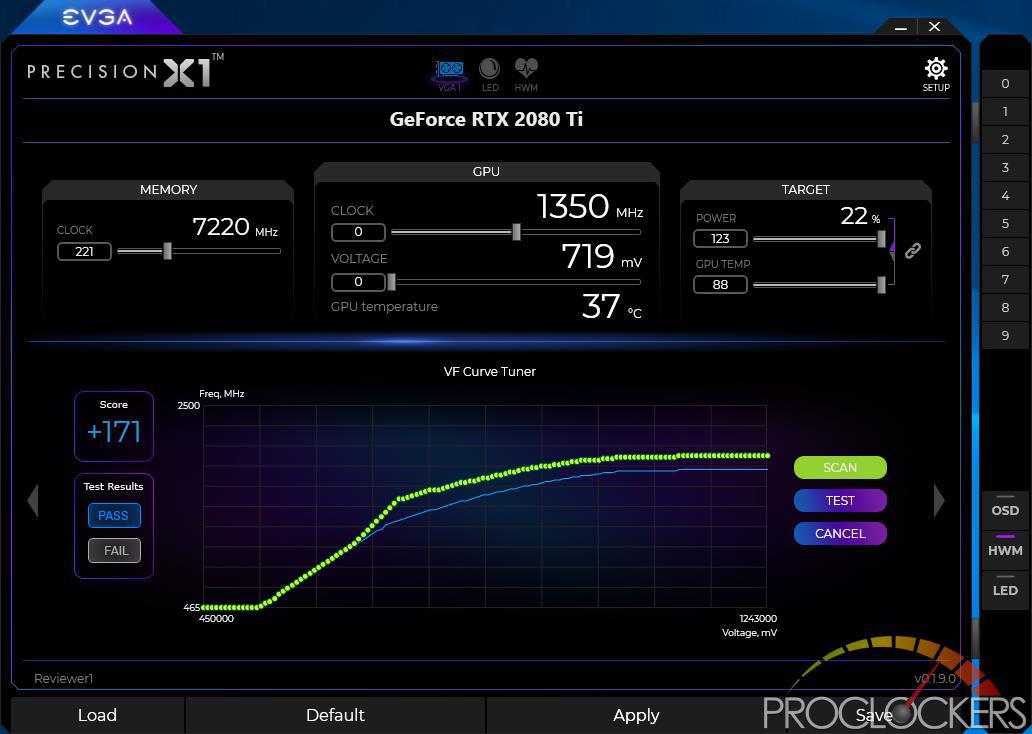
We’ll use the Nvidia Scanner tool embedded in EVGA’s X1 utility to see how the RTX 2080 Ti does. We got minor gains until we raised the power target to its maximum (in this tool at least) to 123%. This gave us a gain of 171MHz core speed and an additional 440MHz effective memory speed for a total of 14.44GHz.
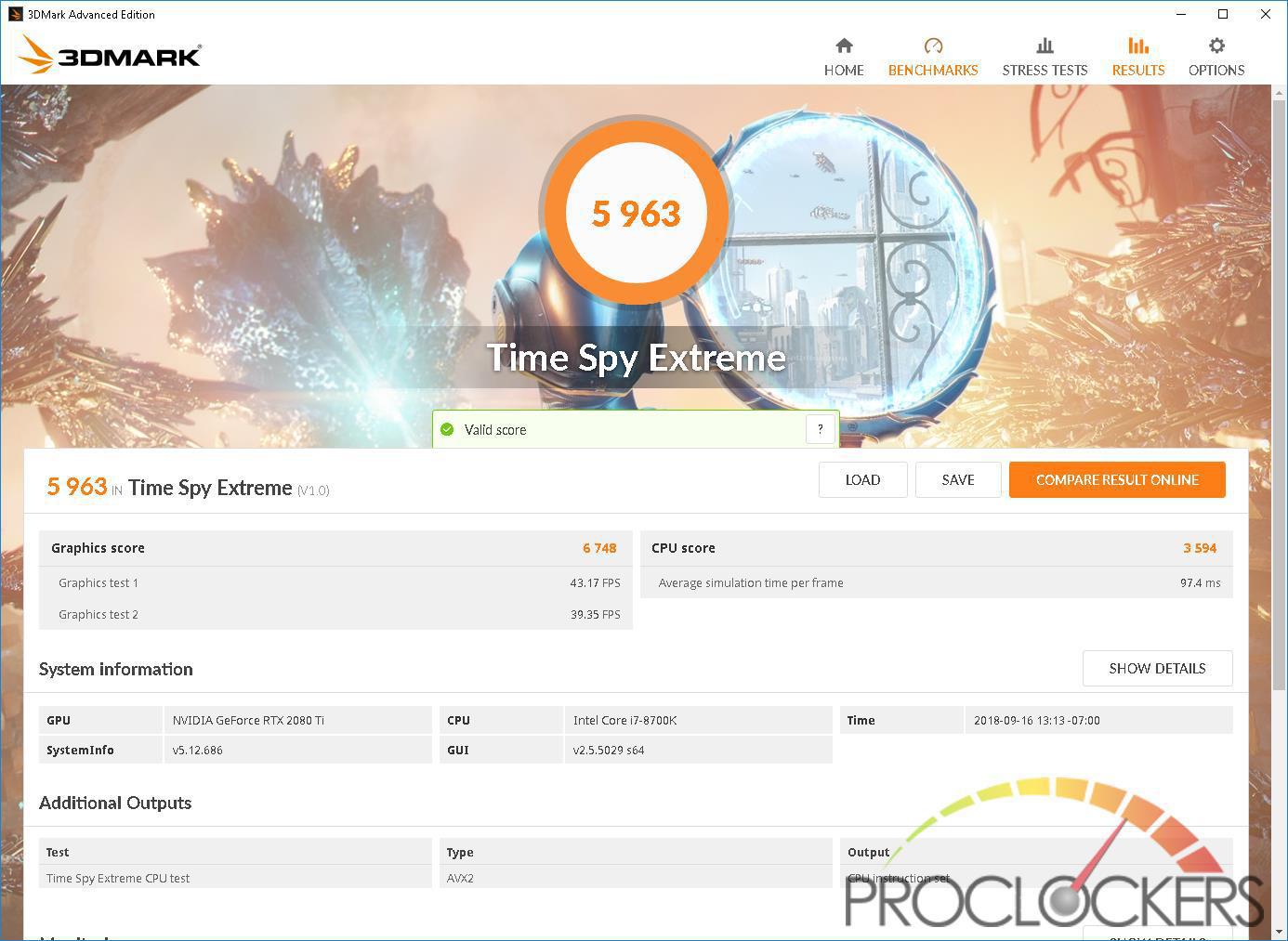
This brings our Timespy Extreme score up to 5963 from 5774, a 3.3% increase for free with almost no effort.
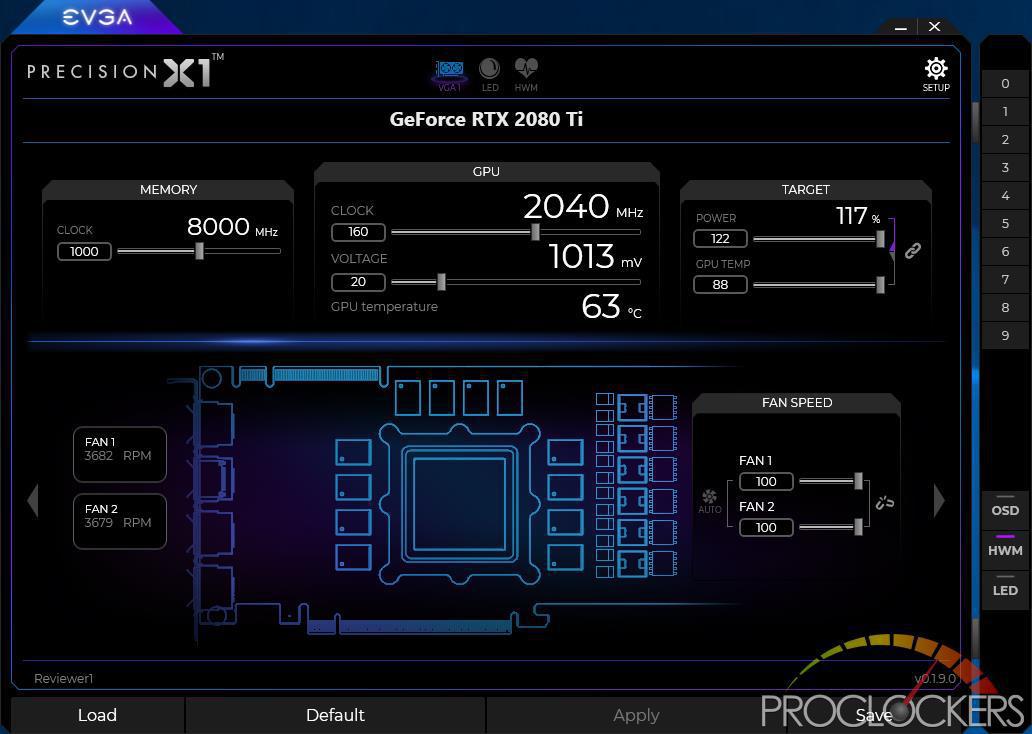
Our next attempt was tweaking manually. A 160Mhz boost to core clock gave us a clock speed that hovered around 2040Mhz and spikes as high as 2100Mhz. we also raised the memory to 16GHz effective which is quite the increase. We also raised the fans to 100% here just on principle.
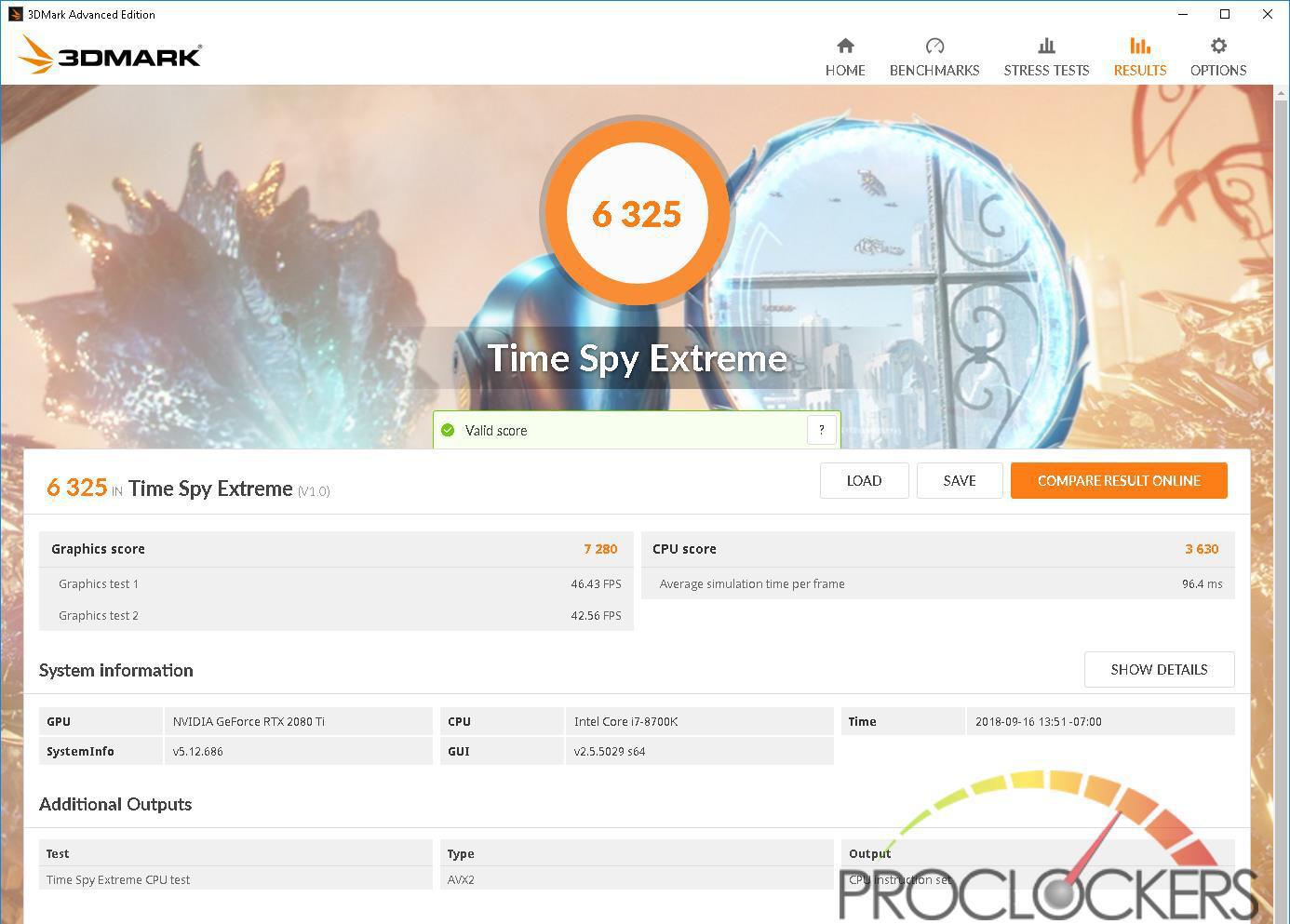
This brought our Timespy extreme score up to 6325, a 9.5% increase over ‘stock’.
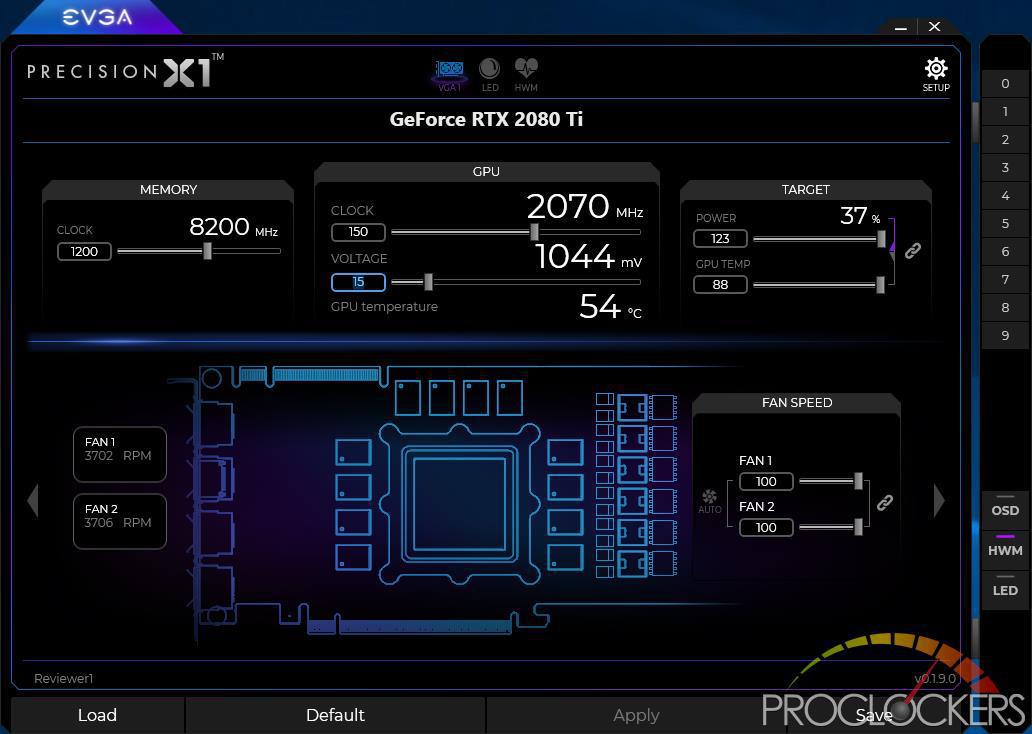
Since GPUz indicated our limit was power, we backed the voltage down just a hair to 15mV over stock, lowered the GPU clock 10Mhz and pushed the memory up another 200MHz to 16.4GHz effective. This lets our GPU core hit around 2.15GHz on the high end and hover most of the time around 2070MHz.
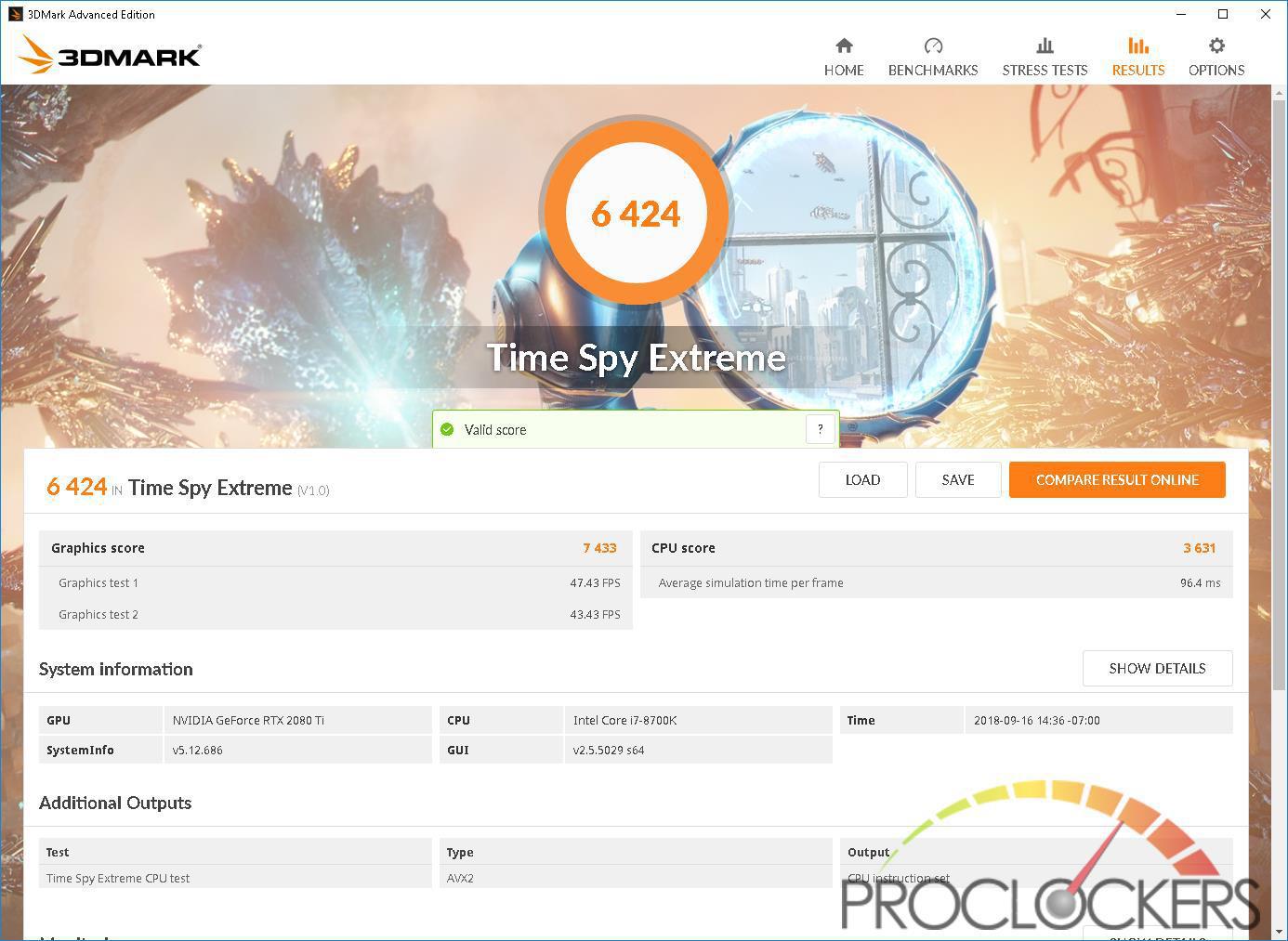
Our final Timespy Extreme score comes in a 6424, an 11.25% increase over ‘stock’. We were bumping into power limits the entire time, and there certainly feels like there is untapped potential under the hood still, so perhaps aftermarket cards will have a bit more headroom. We certainly can’t complain about a 650 point increase in one of the most demanding synthetic benchmarks we run.
Power consumption
We measure power usage with a Watts up? .Net portable power meter with our Corsair RM1000 power supply.
Our 80+ Gold rated power supply runs with the following approximate efficiency:
10% Load – 89.1%
20% Load – 92.5%
30% Load – 93.1%
40% Load – 93.2%
50% Load – 92.9%
60% Load – 92.5%
70% Load – 92.0%
80% Load – 91.5%
90% Load – 90.8%
100% Load – 89.9%
At idle:
109W – From the wall
97W – adjusted for Efficiency.
Under full GPU load:
332W – from the wall
309W adjusted for Efficiency.
This gives us a GPU only power consumption for 212W at stock settings from the PSU or about 223 Watts from the wall.
FLIR Thermal Imaging
We’ll start out with a big Thank You to FLIR for sending us the FLIR ONE PRO to assist in this segment of our reviews.
About the FLIR ONE PRO:
The FLIR ONE Pro gives you the power to find invisible problems faster than ever. Combining a higher-resolution thermal sensor able to measure temperatures up to 400°C with powerful measurement tools and report generation capability, the FLIR ONE Pro will work as hard as you do. Its revolutionary VividIR™ image processing lets you see more details and provide your customers with proof that you solved their problem right the first time. The updated design includes the revolutionary OneFit™ adjustable connector to fit your phone, without taking the phone out of its compatible protective case. An improved FLIR ONE app lets you measure multiple temperatures or regions of interest at once and stream to your smartwatch for remote viewing. Whether you’re inspecting electrical panels, looking for HVAC problems, or finding water damage, the new FLIR ONE Pro is a tool no serious professional should be without.
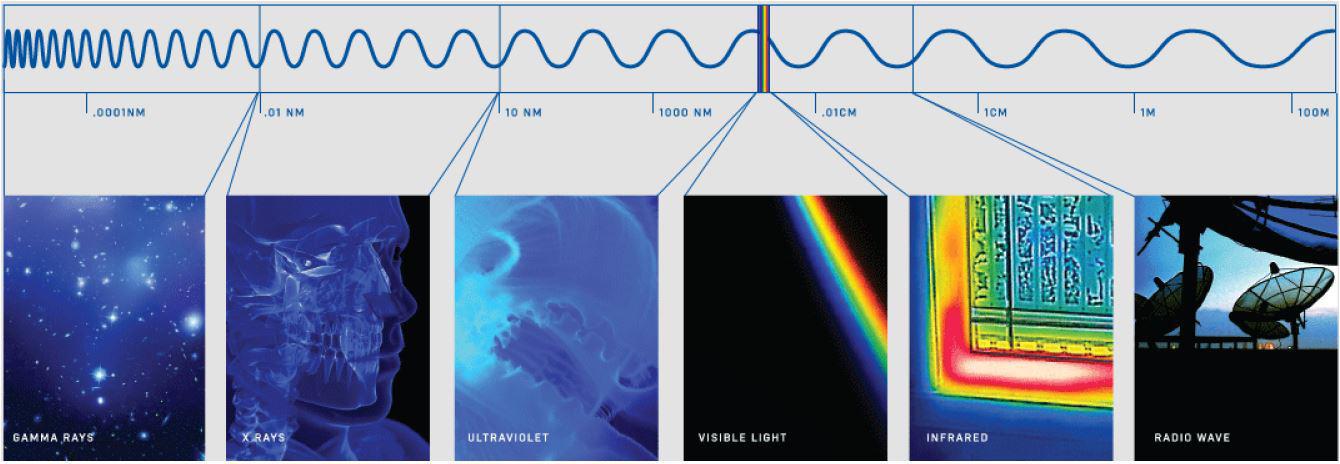
THERMAL IMAGING: HOW IT WORKS
Thermal cameras work by converting that heat energy, emitted or reflected by practically everything on earth, into color images. These color images enable anyone to not only see in total darkness and through smoke and haze but to also safely measure temperature without touching a surface. They are sensitive enough to differentiate temperature differences to fractions of a degree.
Want one yourself or want to know more?
Testing environment – approximately 23C/73F
We’re quite interested to see how thermals behave with the updated dual-fan cooler over the previous single fan ‘blower’ style coolers.
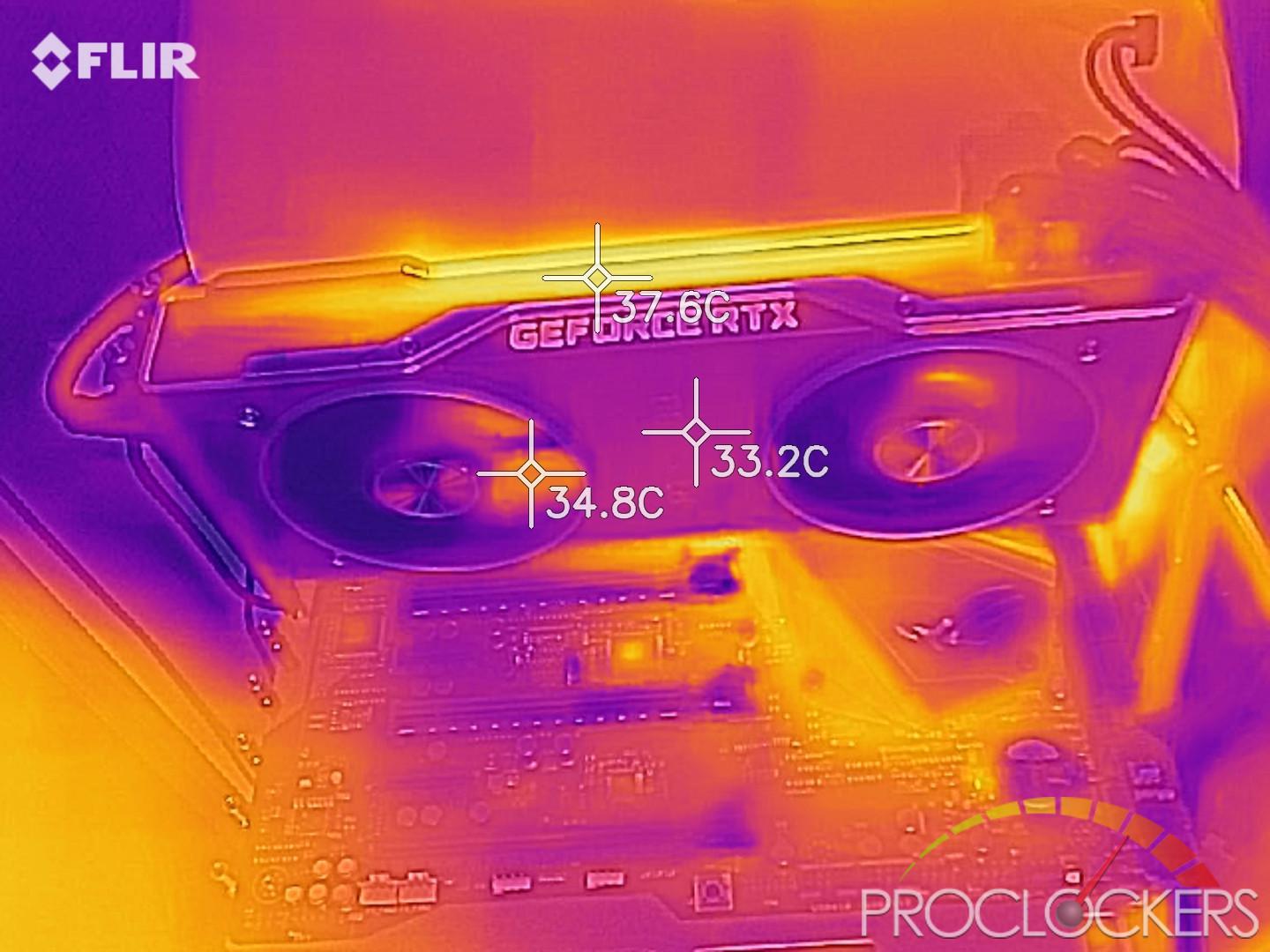
With the RTX 2080Ti idling at Windows desktop, we find the temperatures settling in around 36-37C as indicated by GPU-Z. The dual-fan system appears to be quite efficient, the heatsink fins are sitting around 37-38C in the center between the fans.
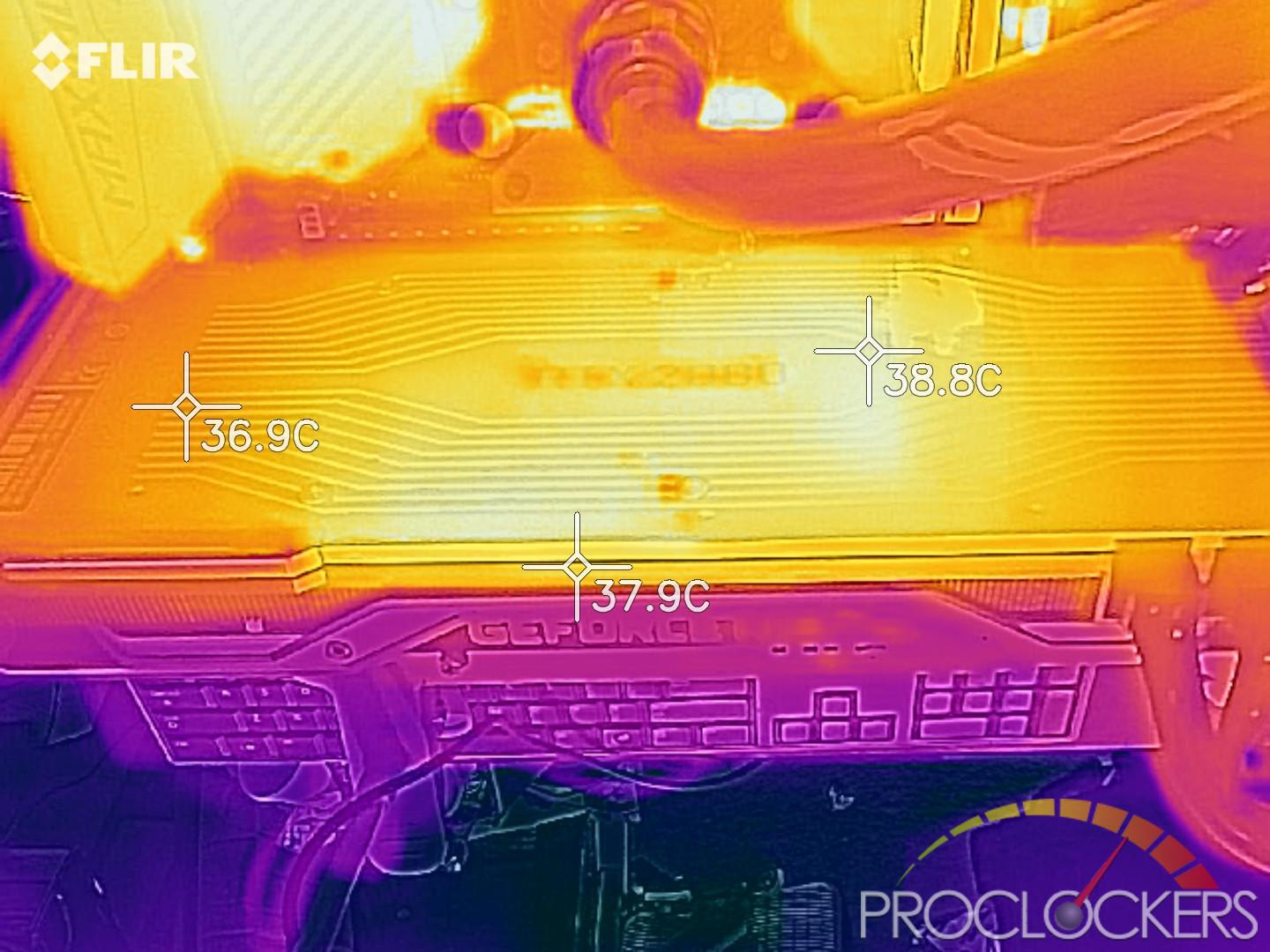
The backplate is a bit warmer with the area over the VRM sitting around 39C with the edges near the exhaust only a hair cooler.
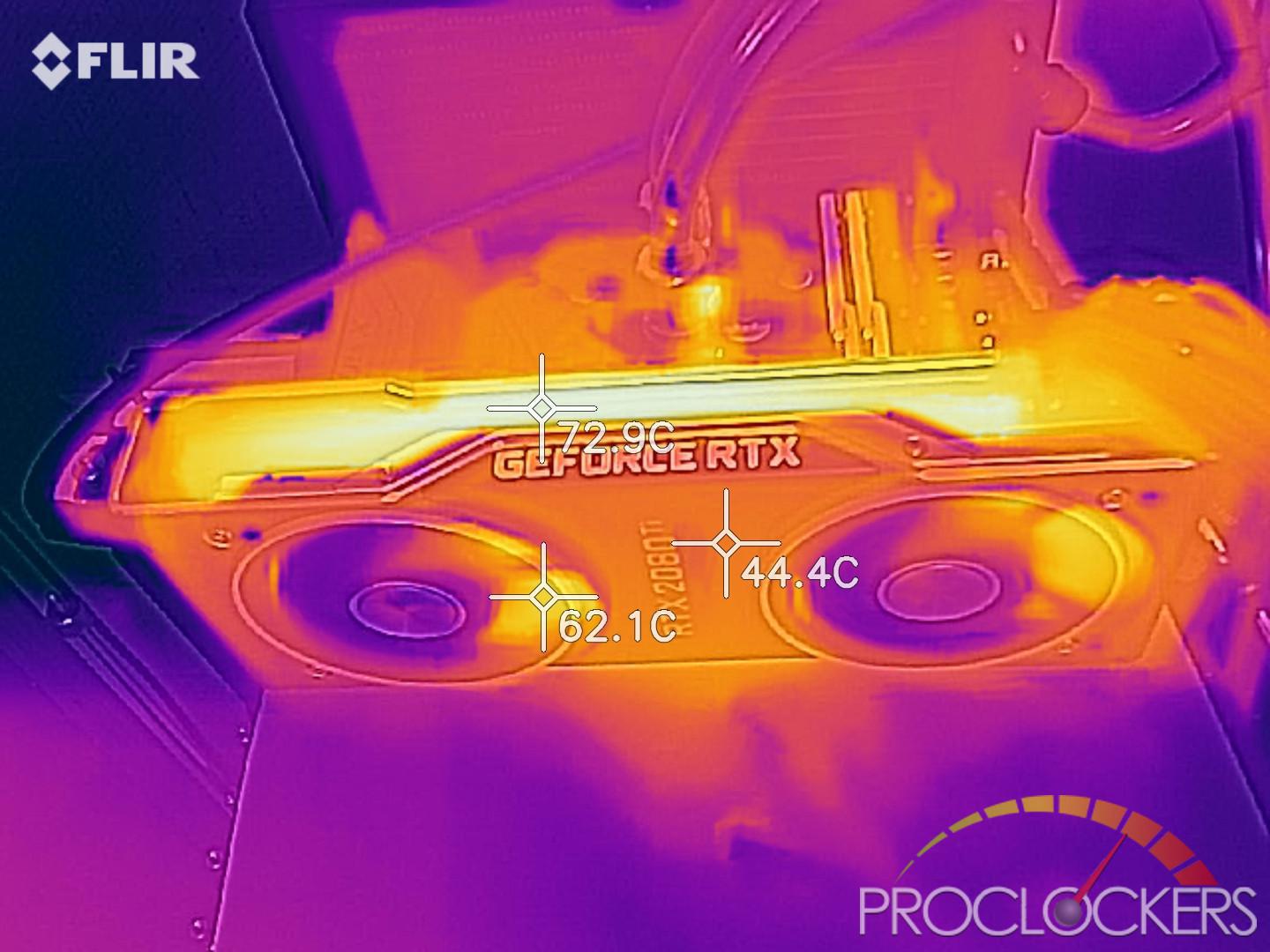
After a 20-minute stress test, the GPU core is sitting around 70-71C as measured by GPU-Z. We see the heatsink fins hitting about 73C and the front shroud is starting to warm up to 44-45C.
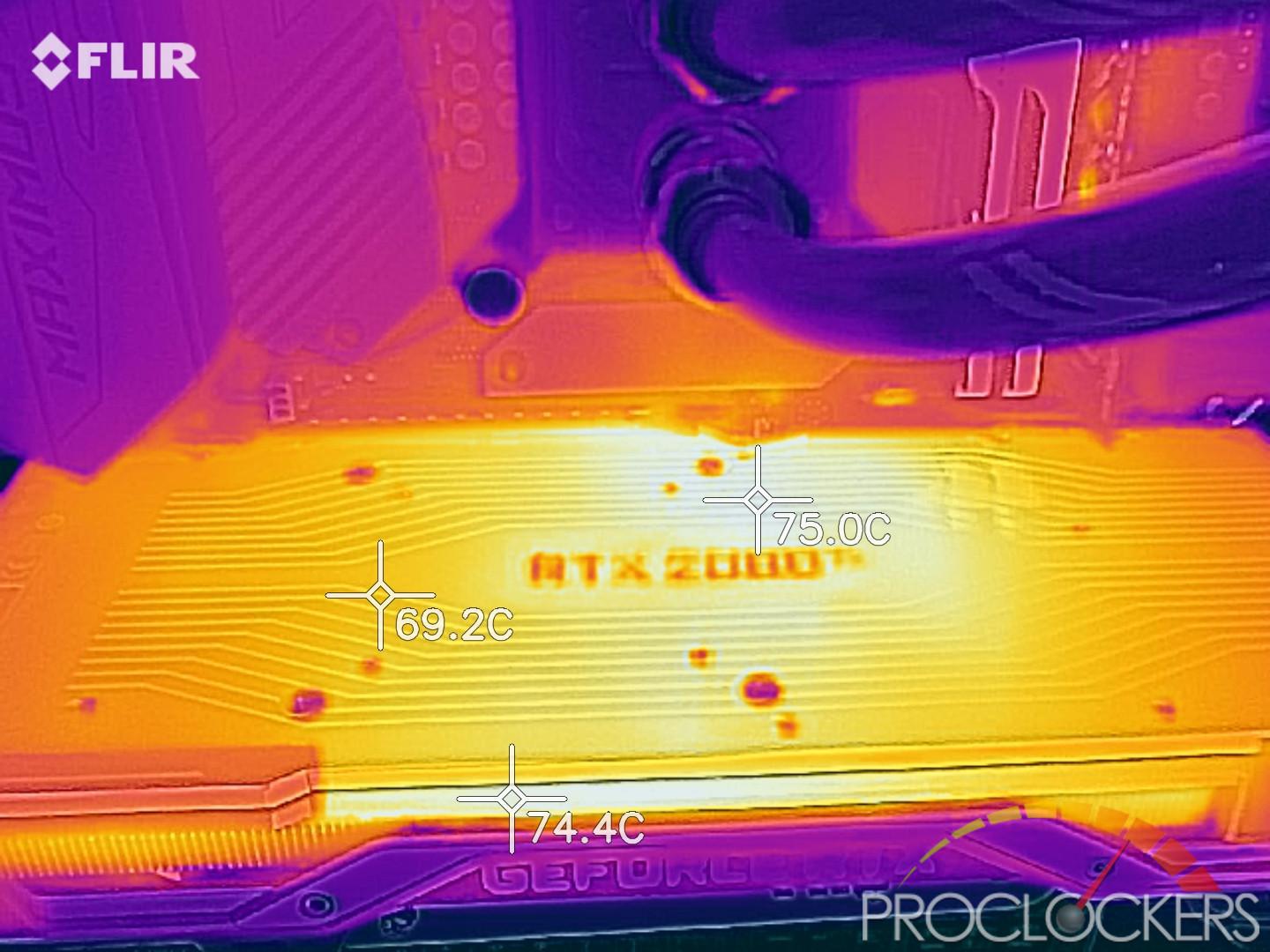
The backplate gets quite warm to the touch with the hottest area between the highest heat loads, the GPU die and the VRM feeding it. The entire backplate warms up to 65-70C. This is uncomfortable to touch but is considerably cooler than previous generations that would often hit 90C. Also, please keep in mind this is an open-air test-bench with very little airflow. Some case airflow would most certainly help the backplate temps.
Final Thoughts & Conclusion
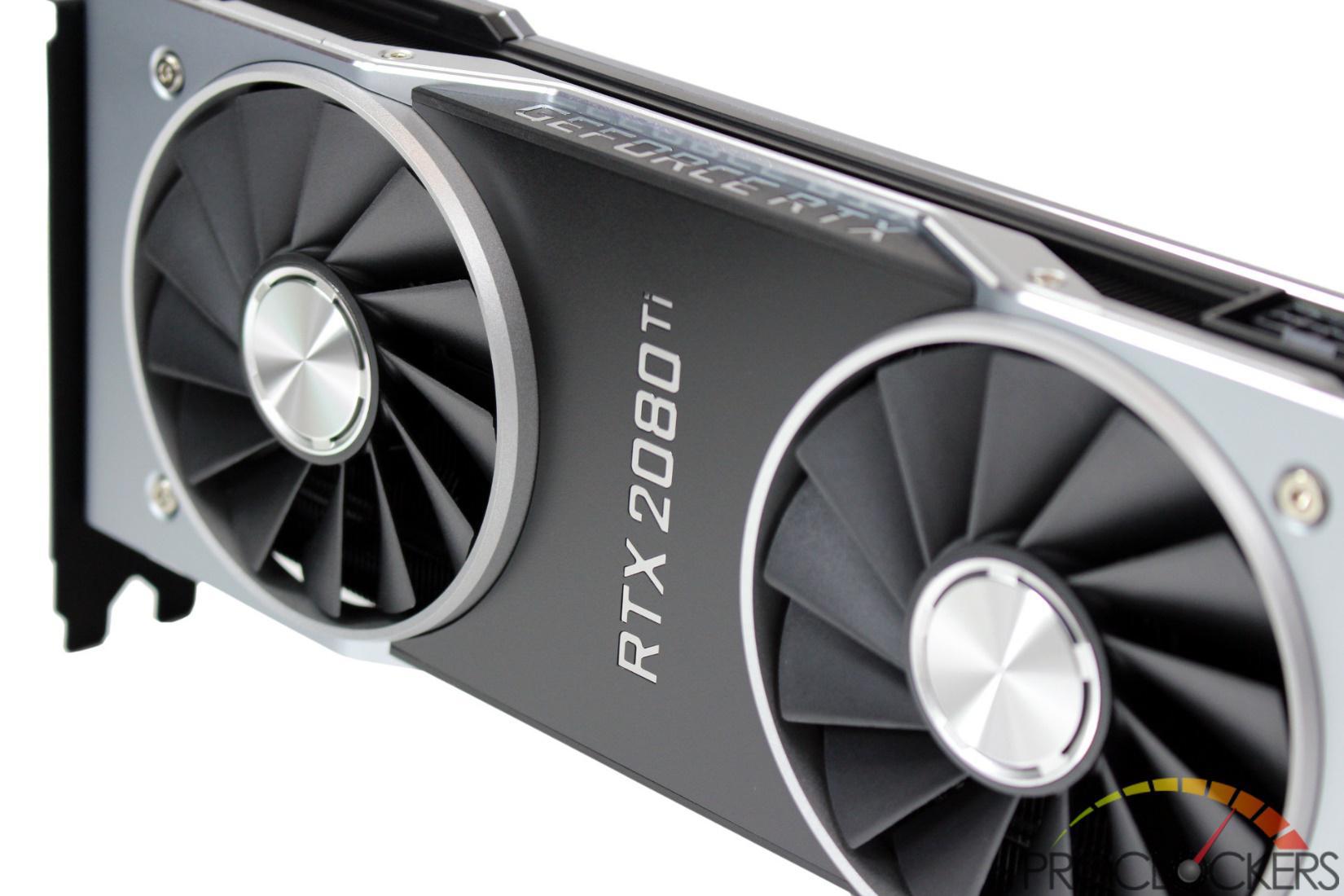
We’ll just cut right to the chase, the GeForce RTX 2080Ti was worth the wait. This is a true single-card 4K solution. Nvidia’s GeForce RTX 2080TI Founders Edition easily supplied not only playable frame rates at 4K UHD resolution, but nearly always averaged above 60FPS with maximum eye candy. And this is mostly without all of the upcoming goodies like the AI-powered, performance boosting DLSS version of Anti-aliasing. While we couldn’t test real-time ray-tracing just yet in any meaningful way, Turing delivered on every other promise Nvidia made, AND with immature pre-launch drivers that will only get better with time.
New technologies take time to filter down into games and to be properly taken advantage of, but the previews and demo’s we had the opportunity to test look quite promising. Ray Tracing is going to provide a new level of realism and immersion. Deep-Learning Super-Sampling can either provide a higher quality of gaming at the same frame rates or provide a much higher frame rate at the same level of detail. While this sounds great on paper as an either/or, it can do a bit of both. It has the ability to bring playable frame rates to higher resolutions too, something we tested quite a bit at 4K UHD.
The $1200 street price of the Founders Edition and $1100 sticker on the standard version will make some cringe due to the significant jump in price from ‘Ti’ to ‘Ti’, this card is a huge leap forward and effectively replaces the ‘Titan’ level card from previous generations. Given the abilities and features, there is some significant future-proofing available for the first time on a consumer GPU. We aren’t sure if this is the chicken or the egg, but the RTX 2080Ti came first and we can’t wait to see what happens to games in the near future as they are able to take advantage of the new technologies.
Epic Job Nvidia!

